It is volume 19 (18 17 16 15 14 13 12 11 10 9 8 7 6 5 4 3 2 1 0)
This is a part of a raw and uneven journal of
digging into the writing systems from all over the world, so I
recommend you to read the summary of this work instead.
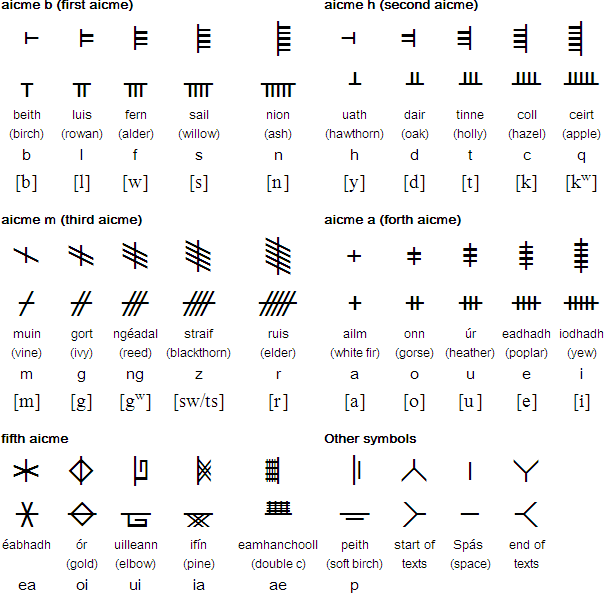
So what I was speaking of in the end of vol.18 was that ogham is arranged in a way that it seems that originally there was only 5 letters and three different ways to write them down, and the order was generally like b d f c s and the other variant is somewhat less alphabetic: h l t s q, well, it begins thus, but then goes a little wrong, but then maybe it tells that probably there was only three letters per aicme.
I was about to say that maybe there were 5 letters per aicme all along, and the name bln is like abz, just a different way to name it, but the result is similar, which is weird, but then ams or amt tells that it can be differently.
But then my mind screams on me that I'm crazy. What am I doing? What am I trying to find? Why do I look for it? What sense does it make? Even if I succeed (and that is if) what will it bring to me or to anybody? I am tired today, I have to sleep. I think I finished the previous session in here, or I drove it into the ground, or maybe I will memorize the ogham in this weird way.
But then the third way to arrange those oghamic letters is mlŋkn which is not too far from what I would expect from it. And is it the first time when some evidence of m standing like b in the beginning? Wouldn't I also accept it if it was any other way or with some other choice of letters? I don't know, I only guess. And this was a guess, which allows me to memorize these things not like a pile of bricks, but as some structure.
Nations could change their writing system when some other nations vowed to genocide them. So they run, settle elsewhere, invent their writing system so they're not identified as that previous nation. For that they would also change their language so they're not identified in speech, so that is how it was that languages invented, and if this guess is correct, we can reconstruct the way people ran this way. But I doubt they would be able to hide. They could be not large nations like modern ones, bible tells that in some bottlenecks there was only one family left and all the people came from them. If all the bible tells is true, then nations are social constructs. It's very deep, but only true if the nation they used to belong didn't die in no flood.
tru looks like m
true lools like me
Noah just drank for 40 days, по библии на Арарате остановился. каждой твари по паре это кошка с собакой? нет, они же животноводы, чтоб всю скотину не перевозить взяли лишь овцу с бараном, козла с козой, коня с лошадью запрягли в телегу, и жена рулила лошадьми пока муж спал. Или сын рулил? Можно ли было раньше женщином управлять экипажем?
Где он брал вино так бухать? были запасы воды вином? оно почти не портится, в отличие от обычной воды.
Это моя беллетрестическая книжка протекает. Библия на меня повлияла серьёзно.
I played with the idea of dice and runes arranged along them if it was possible in principle,
and I found this possibility:
ᛆ ᚾ
ᚼ(ᛡ) ᛁ
ᚮ ᛦ
ᛒ ᚠ
ᛘ ᚿ
ᚱ ᚢ
ᚦ ᚵ
ᚴ ᛚ
ᛋ ᛏ
I recognized ᛦ as y (how convenient!] and now I see it could be syllabic R (ar? are?) but then I played it differently. I had other questions. Labial N? are you Nuts? And I saw that two ᚴ's make me question the validity (the authenticity, the изначальность) of the letter ᚵ so I rearranged the runes in those dice:
ᛆ ᚾ
ᚼ(ᛡ) ᛁ
ᚮ ᛦ
ᛒ ᚠ
ᛘ ᚱ
ᚢ
ᚦ ᚴ
ᛚ ᚿ
ᛋ ᛏ
I even dared to throw away ᛦ as if I could do it solely on the fact of it being transliterated differently. well, Н would be transliterated differently ..so I have to restudy runes based on the communities continuously practicing runic literacy. That is some anthropologic work, I'm definitely not going to do myself, not in decades. Maybe someday, after I solve the immortality thing.
I wanted to leave two jockers out, so I excluded ᛦ too, but that is lame, of course, too many liberty, and ᚱ as П is rather bold too, you know. Then ᚮ could be recognized as labial, but it's much more commonly recognize as vowel, so it belongs to vowels, but then if they were not vowels, but doubles? They are in a sense, and then I wonder if there could be ᚥ the sixth. and that would make them 19 with the ᚵ.
But then we have the set of Bureus, he probably reported them from some field study, not some academic consensus. His report returned neither 24 nor 16, but only 15 runes, and was it memoryholed because then many would study if that was that legendary 15-letter alphabet of пятнашки

And if it's these 15 and three groups by 6, 5 and 5 runes each, so the jocker slots are in last two aettir, let's do it, and because they had only 4 obvious vowels, I had to place those h and R into vowel group, because these two the only ones (plus L, if I had no other option, I would place L in the vowel aet) which were vowels somewhere sometimes
and I would also have to move ᚢ from labial aet to the vowel one.
and this story seems hopeless, but let's play around with it (one of the main tasks of what I'm doing is showing you how the scientific search is going. As Feynman said, first we guess it, then we test it.
ᚠ ᚢ
ᚦ ᚮ
ᚱ ᚴ (and here I noticed that if ᚴ is labial as H in japanese, then these are labials, for ᚦ could be θ which could be Ф and then I naturally question my sanity for am I really able of proving anything with such mental gymnastics. But let's go on. Or is ᚴ standing where ᛘ had to. But then we also miss obvious ᛒ (whether to place it next to ᛏ with whom they're the original ones Gs, but then G's counter-clockwise, unhappy to have such a G around house, угонят чегонибуть эти говёные гангста, гони гопотню, говни говори грязни говерни, от ворот поворот)
ᚼ ᚿ
ᛁ ᛆ
ᛋ These could be linguals and vowels alike, they would just take different mental gymnastics, but let's try it to test it, because now I doubt I could:
Vowels: Η is vowel in ionic greek, but Н is lingual in russian and H is lingual even as h, but then it's labial in japanese, but why does japanese matter? We share lots of phonietics, even though we have different writing systems. Okay, pass. Move on. So ᛁ and ᛆ are legit vowels, but what would I do with ᚿ and ᛋ? Would I go with ᚿ being a form of ᛆ, the other side of ã? I could go there, because all this house of cards is built on similar assumptions. and then they grew or not (some of them notoriously didn't return a lot, like that k-symmetry could be a complete and utter bs, even though it was reported in some other findings and about historic amulets too, but those who made those amultes could come to the same misconception I did, but that's almost as best as it could be, better is only some never ending tradition, but who knows when such tratidtion began and what popularity of an idea has anything to do with the authentity of it.
Linguals. That is challenged mostly by ᛆ and unless it's recognized as ᚿ_like ã, it has nothing to do among vowels, but then a~d could come along, who knows how low could I fall. And let's see that trying to push the third aet into those vowel or lingual to see what it makes out of this one:
ᛏ ᛒ
ᛘ ᛚ
ᛦ
and these ᛒ ᛘ scream of its labiality, and ᛦ reflecting ᛘ demands a question of what sort of y it was, and then I recall that russian т is т in cursive, and that ł is w
And then I have two labials, and I see the boundary where the apophenia lies. But then do I? What if by mere chance the third aet was not so labial. And it's not! Okay, let's play along some more to prove that I could prove anything, let's try to make it lingual. So it would make that previous aet vowel with vowel N adn S and I didn't yet said of S, would I declare it Σ looking so much like E? I never did it! Why would I? Why do I bully myself?
Is it really the way to memorize these aettir? Bureus aranged them by their graphical features, because ᛏ is also written as ᛐ, thus mirroring ᛚ
ᚠ ᚢ
ᚦ ᚮ
ᚱ ᚴ
ᚼ ᚿ
ᛁ ᛆ
ᛋ
ᛐ ᛒ
ᛘ ᛚ
ᛦ
These are actual aettir given by Bureus, let's play with them the way he played:
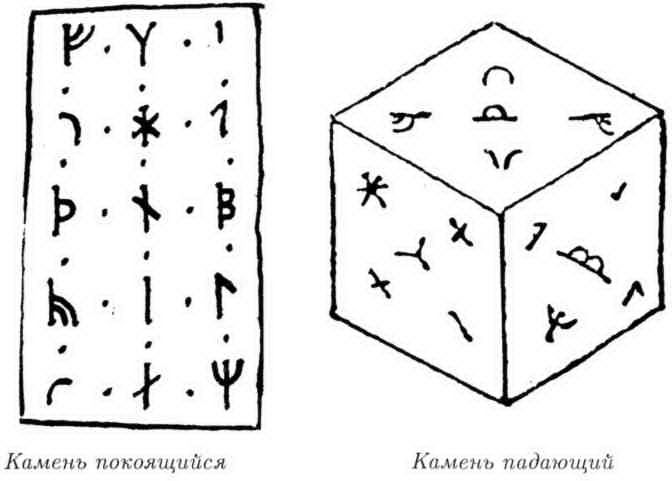
and he didn't have that silly ᚴ in the first ogham. Thus first ogham became more labial than before.
Of all the runes the one which distorted that harmony the most is not present in this Bureus thing. Did they always have to insert K or Kross Kristos Kurse, whether it's course or curse doesn't matter that much.
%20MS.%20Fa%2021,%20Royal%20Library,%20Stockholm_OCR.jpg)
He arranged these same 15 runes into another cross-symbol which seems to be related to the Kabbalistic Tree of Life, and the Yggdrasil World Tree (see the “Titulus III” image on the right (in this addition edition it's the one at the top)).
This rune-cross-symbol’s arrangement was supposed to represent a map of the universe and of the human being, as well as of an initiate’s progress of getting closer to Divinity. For Bureus, the initiate’s progression was related to the vertical line of the cross.
In an effort to explain the larger rune-cross-symbol (with the 15 runes), Bureus makes multiple other smaller rune-crosses (with between 4 – 7 runes) in an attempt to highlight the significance of the runes and their interrelationship(s). An example of one of these smaller rune-crosses is below:
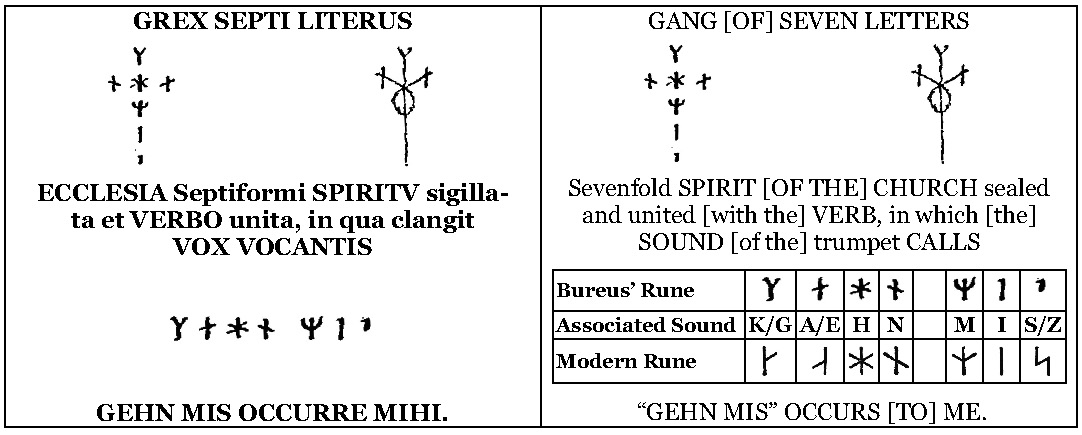
edition misspelled as addition reveals the actual meaning of that word: they don't only edit something out, they always seem to edit something in. They often open your book with a preface written by them (well, not by you, by someone of them) it's not the rule, many books are published without previews or with previews written by the author, but then I'm sure they tell the author why he needs it and what it should tell. Or maybe not, but that typo revealed all this. And I have no idea if it's delusional or not, I just allowed that possibility and drew the sequences out of it, so now if I meet something of the kind, I already have a possible explanation.
And I just flood with the recent founds just not to lose them:
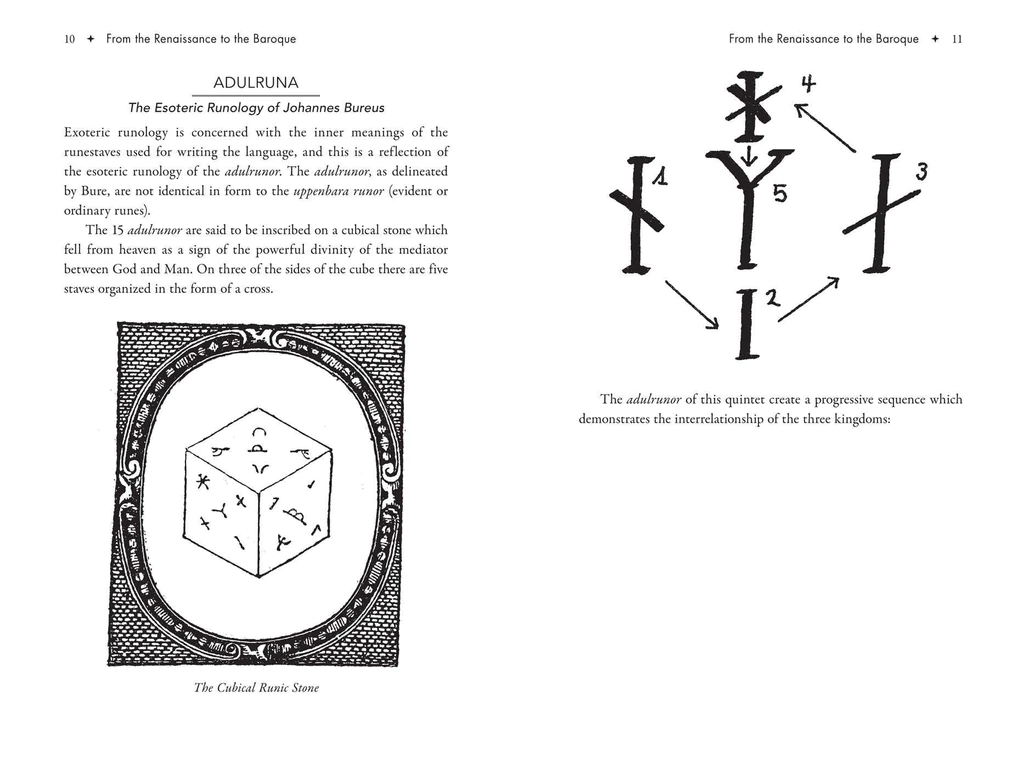

Bureus believed that each rune could be traced back to the Adulruna, and that beyond their phonetic reading they also contained secret knowledge that had been lost to the ages.
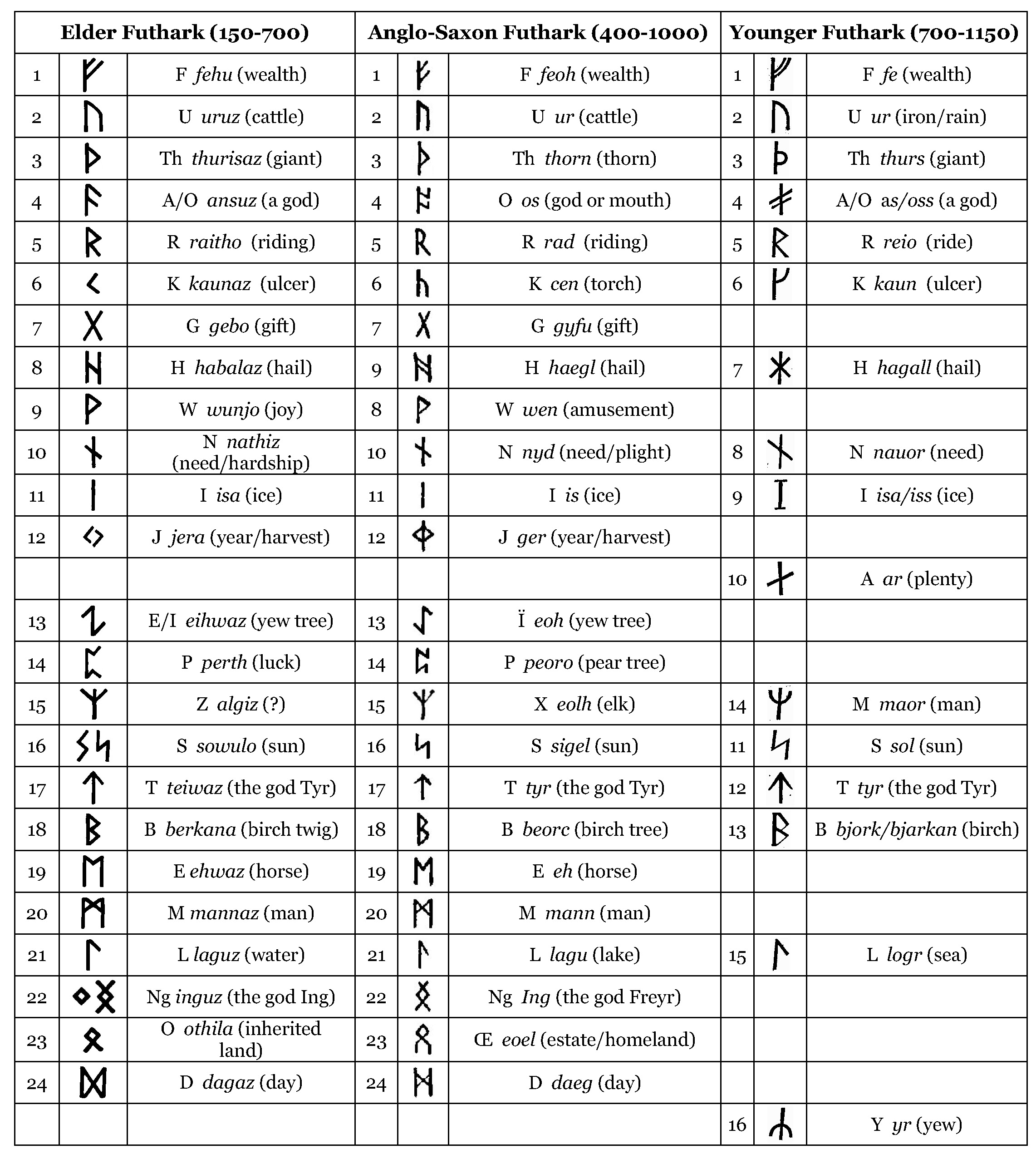
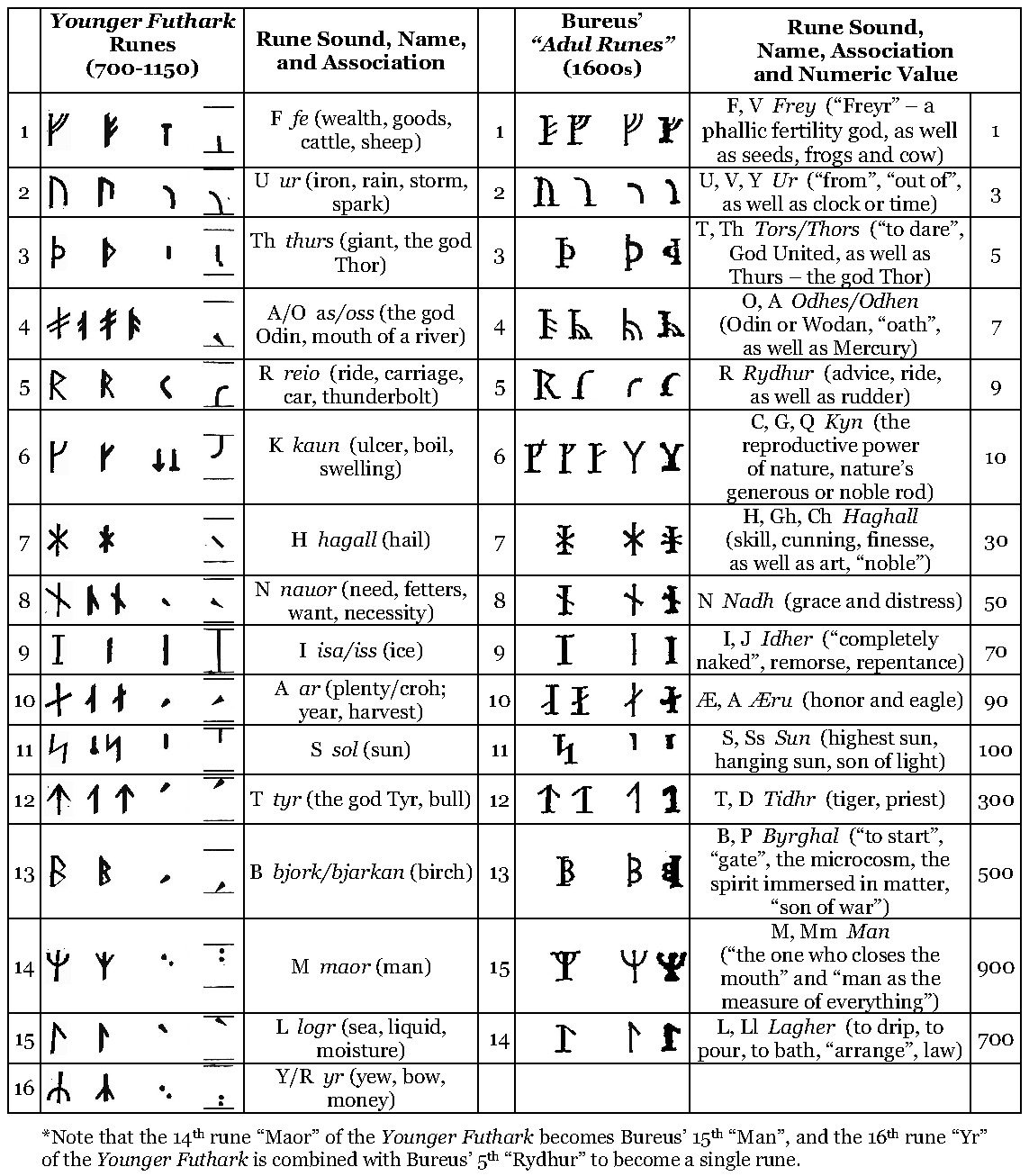
Here is another piece of the puzzle:

It leads to the whole panel, where it can be downloaded in .tiff of 160MB, I have converted it into png to archive it just in case for further use, for there is more to it than this: a mirror
the original belongs to Uppsala University Library, shelfmark: Sv. Rar. 10:206 ligg. fol.
As you can see here, dots doesn't mean neither voiceness nor voicelessness, but that it's somehow different from the original form, and thus B is the original form, and P is only its variation, and K is the original form, and G is only it's variation, but then it sorta contradict to what they say about C being voiced at first. And also the way B there looks completely not runic may tell that it was borrowed from other nations, and thus before b they used f, and thus instead of "beat" they used "fight" or somethiong.
But because there is more, let's give that more, and here's probably the source of that bindenrunen table:


This one I cannot tell much about, that large tiff that image links onto (and the mirror above in case this hosting goes) has lots of calendaric information not included here, but this table above may hold keys to understanding those calendars.
And the last tidbit from that huge and marvelous panel:
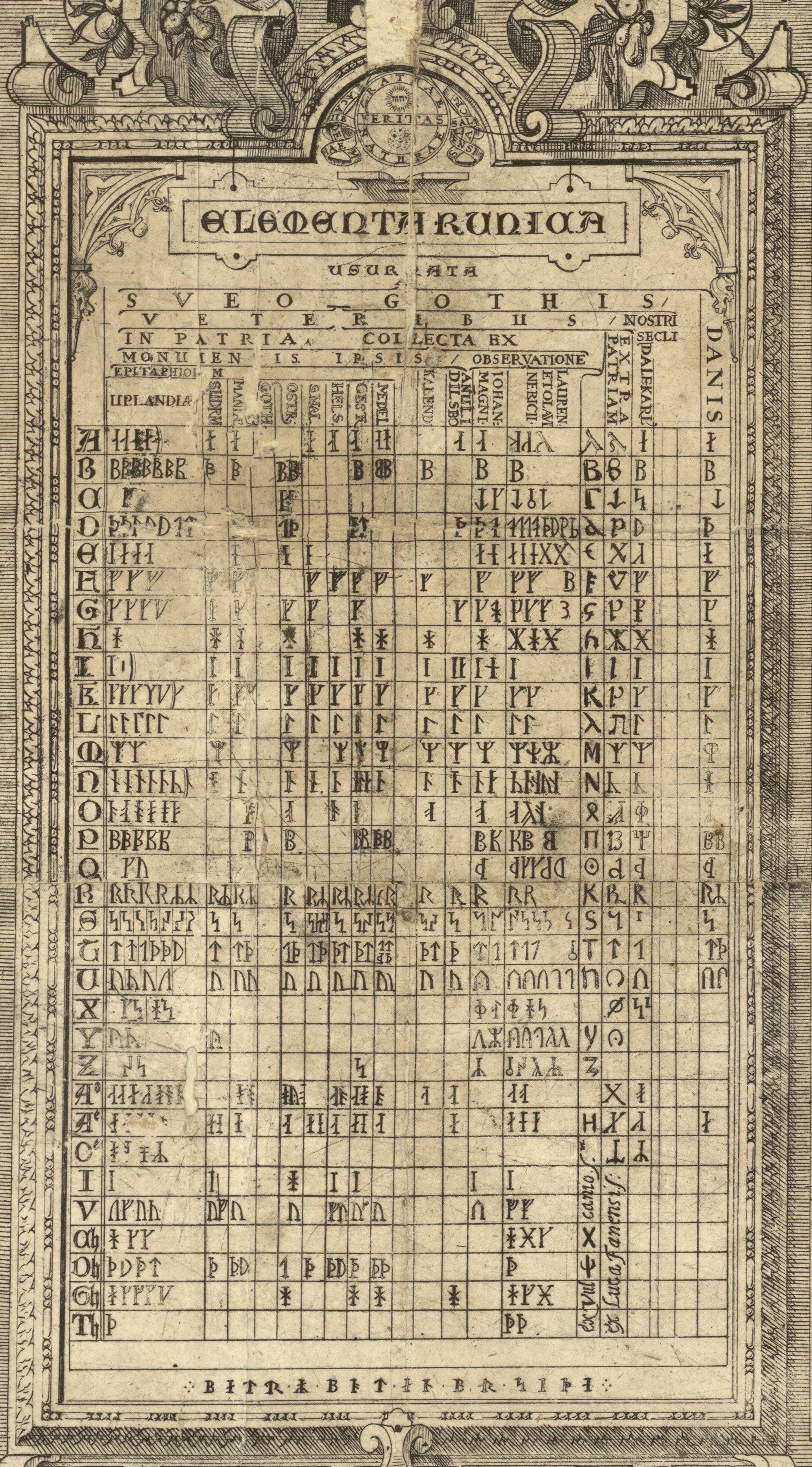
Now here I see that U and V stand as two distinct letters, even though they're not always distinct in the variants of runic writings collected in this table. In some cases ᚠ is used to depict V, and it relates it to ו like directly and make that dash of f kinda избыточным (abundary) excess (or is it in excess? maybe I shouldn't write in language I don't thoroughly understand. but I do
Also see how all vowels seem to be two or three thing (if we consider ᚢ the third), one dash across the staff for a, e and even i; and two dashes for o, aa=o in dannish, and that danish standing aside to the right separated from all the other sveo-gothis (probably swedish-gothic)
But then ᛁ only in the Iohan-Magni has the dash (and in Anuli Dilsbo it has a dash alike of ᚴ's, which could explain it standing next to that, as if the -y suffix is like suffix -ic.
So generally, except ᚢ indicated by bornholm's axial symmetry as a labial consonant, vowels are one simple dash (or no dash in the case of ᛁ most of the time, but also not alwasy - is always jsut more благозвучная form of all-was-y? but then -was- in there doesn't make sense, so probably no. ) or double dash in the case of o. and then, on to the next one:
ᚢ slightly differ in shape, but always represents the upside down U or V or Y or L/J? what? but to them later, let's stop at inverted U/V shapes, they remind me of something:
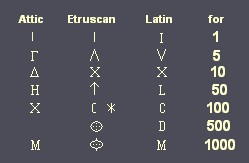
I also didn't know about Attic, Г ~ Λ, haaardly it is a coincidence, too many of them, and they're not that rampant in other cases, but it's still a mystery to me. But then, about those rampant other cases, am I not supposed to catalogize these pairs of Δ and X, H and ᛏ and L, at least T and L because t is a dashed form of l so it looks most of the times, then X~C and it's interesting because C~D and now 10~100 or what. And then D is 500 and Δ is only 10 and other systems don't seem to know them, and does attic M borrowed from roman? and what are those weird signs for 500 and 1000 in etruscan system, and also set that ᚼ used dogether with C in etruscan 100, but then what do I know. Isn't it X squared. And why am I here, that previous grey area showed that the sharpness of my wit is tired, so let's relax and leave it for another day (and the next part of other numerals is already written, I just added here something as an edit.
But then.. why maK? or is it hUth?

or is it some Oscan or Umbrian П? and notice how 4 and 5 both begin with the same letter again: petora and pompe. So fetor~four? fompe~five? dus, tris they're cognatics, tuf trif, very cool, and those two and three also begin with the same letter. Is T two sticks or three ends? a natural question. and some reforms of writing or numeral system could be hidden in these little facts. Bat and bi in basque.. is bi plural form of bat? as in russian "одни" зачастую означает "вдвоём"
In etruscan 6 and 7 begin the same, but all these could be nothing, but still weird, because I would expect the signs for numbers to stand for the letters for their initial letters, as some freak actually proposed about the russian, and I think i've shown it. I collect it all, I'm an encyclopedic mind, or that is one of my aspirations.
6 seems to be the most persistent across languages. And greek hex stands for the assumption that h was ʃ.

And that uvula can make some tricks man, it can vibrate, the картавое R in russian (in the way I and almost every other картавый говорящий по русски (в других языках понятие может означать другое) pronounce it) and some forms of creeking (речь ручей река речей тека течь читать?) creaking (скрипеть, что ближе к русскому крик, скрипучая петля кричит, остальное лишь разница в употреблении, это одно и то же слово. добавлю его в cognates.html
So you can see it yourself if you light a spotlight into your throat in front of a mirror and say hr in the throat, and then it will start wiggling and not directly pressing against, it obviously vibrates next to the tongue and not palate. Or maybe it vibrates the palate behind it, I cannot see clearly, I'm not using endoscope tonight. But then some videos about it on youtube, but just a meat dissection is much more informative, though not as graphic as defloration of pyloric sphincter but then, maybe even more.
That root of the tongue niche raises several questions, and here I went to watch some endoscope video reports, and they are insane, but nobody seems to research that area past the tongue, as it's nothing but some whatever, I think that thing is the one they sing with in black metal. So расщепление голоса это расщепление языка? кто знает, кто знает..
and here goes some attempts of making some smart russian alphabet, and it just needs numero 21 for some magical reasons, but 21 is 7 vowels and only three columns. And after I played here and found not much, so decided to place it in green, I jump to the posibility of 3*7 in more darker shade of grey
A Б Г Д
E V Ж З
И М N Л
О П К Т
У Ф Х С
(in japanese manner all R are substituted by L, but then maybe L and R share the claster and can be used intelchangebry, also to demonstrate such semantically consistent pairs of inter=intel and -ry = -ly)
ё = ио
й = и (just like y is not confusing americans, let russian и (just as y is ij = ii, it is ɪɪ)
ц = тс
ч = тх
ш = сх
щ = скх
ъ = '
ы = и
ь = и
э = у
ю = иу
я = иа
(but then иа is how jackass screams, and probably that is why latin doesn't work for russia)
A B G
E V Z
H Θ X
I M N or L(with awavy tonuge it would look like.. И, which is sorta like n, but then it may be ŋ)
O P T
U F S
Y W Ж
как вариант, хотя гласная H и Y вместо
другой вариант:
A B G
E V Z
H Ψ X
I M N
O P K
U F S
Y W Ж
or
A B G
E V Z
H F R
I M N
O P K
U W Ж gosh, there are so many labials and I stick to this exotic something
Y Ψ X either way, this proof of concept speaks that we know about right ammount of labials to fill such a structure, or that ammount may tell that Ψ could be invented to fit this structure, but then greeks didn't have W, but then it's all strictly speculative, and shouldn't even be looked at, but then I would sing differently if it was more stratight forward.
семиты кошатники. сима скорее кошачье имя. сёма? мужская форма симы?
(в египте кошку обожествляли, а мусульманы собак нечистыми считают)
северяне с4обачники (вплоть до собачьих упряжек.) и собачье имя жёщще обычно. норд?
норд народ? самоназвание северян? родин на севере? nord on rode (suddenly rode is ехал)
does rode is axis? aet? ace? 3 ace are 3 suits. and letters in aettir are..
a k d p 10 9 8 7 as in preferance?
or I V X L C D and they were 6 not 8
what are
А В Г Д
ט ח ז ו ה
U VW X y Z (the y is of uvw gang, a curiosity probably caused by )
these three lines greek, hebrew, latin, are having v as its second vowel, and thus are candidates to represent ivxlcd
cd as the final accord screams abcd, ivcd 1 5 100 500? or 1 4 16 64? ot 1 5 10 50? or 1 4 8 32?
or 1 2 3 4?
ivxlcd x~v, L~Г (graphivally symilar)
I V C D is new meme for me.
IVC
XLD
IVX (these most people know)
LCD (these most people are not aware of)
LK..M?
is D.. J or N? g is both D and G, which is natural since the D follows C in both structures. they are the same structure.
alphabet is numerals.
f fot first because futhark? but s is not the second, yet th is the rhird. I thought first is not ᚠ but of ᚨᚩᚪᚫ
Eerste is that A. And these cognates could be explaned by that rune for a looking like f.
A B C D
I V..C D
X L C D ?
BC (before Christ)
AD (anno Domini)
is the other way in spannish:
AC (Antes de Cristo)
DC (Después de Cristo)
That D is not
гласные передавали разные эмоции
боль скорей всего была I, потому что ай, визжат от боли, пытаясь не орать? орут от злости. А или О?
Остальные строки могут быть приворотными, а I-строка отворотная, как в малитве дай нам того и сего, а от боли избавь (в отченаш просят избавить от лукавого, от того что не то чем кажется. чтоб кусты не оказались меховой убийцей, например)
A эй, hey
E eee the shape of e tells of pleasure. so yeah!
I ай ouch
O oh! (удивление)
U oo.. у.. ew, фу (разочарование) этим может объясняться нарушение последовательности глАсн гУБн яЗыЧн (ы тоже не факт что без языка произнесёшь)
notice that vowels place lingual vowels before labial vowels.
Only ogham does it the other way around, others follow aiu pattern, which is consisstent in the east, because they also place consonants this way, but ogham is yet weird and to be decyphered.
от и до антонимия:
отстойный или достойный
отставленный или доставленный (привезённый)
от =of
of and to are antonyms.
to me / off me
but I'm not a native speaker, so it makes me sad
t = f? both are θ, Θ
but they're at the opposite side of the lingual-labial spectre. It wouldn't make sense unless there were only two letters: vowel and consonant.
ⴰ/ⵔ and all those dotted variants ⴱⴲⵀⵁⵕⵙⵚ
notice that ⵓ is u and it's so only because they don't have o, their o is u, as you can see by it's position after N and before R, notice how they treat the RR and is that ⵖ q? it's ɣ, voiced velar fricative, that voiced h I was confused about, but then who wouldn't? Why does it stand where Q should? is it a form of R as some Ж? also their ⵣⵥ are supercool, and explain why Z is final. Tifinagh influence? Punic influence. Was it roman influence which erased the carthagian influence all over the mediteraanian? but then that ⵔ I just considered vowel R like they have it in sanskrit. is it labial like П, of maybe it's more like ᚢ and not V but U? I don't have to be stratching it's all new to me too.
ⴻ is also vowel. E, shape of which tells so, and then it make the sequence of 123 in ⴰⵓⴻ of a u e, which is oghamic, so I'm telling you we have to dig this corner of earth and we may find many funny findings.

ⴰⴱⴲⴳⴴⴵⴶⴷⴸⴹⴺⴻⴼⴽⴾⴿⵀⵁⵂⵃⵄⵅⵆⵇⵈⵉⵊⵋⵌⵍⵎⵏⵐⵑⵒⵓⵔⵕⵖⵗⵘⵙⵚⵛⵜⵝⵞⵟⵠⵡⵢⵣⵤⵥⵦⵧ⵰ ⵿ ⵯ
ⴲ is β (voiced bilabial fricative, and not w, more like v, sounds exactly like v to my ear)
(technically here I'd have to give two links, and even these two are not good enough: https://en.wiktionary.org/wiki/ⴲ https://en.wikipedia.org/wiki/Voiced_bilabial_fricative but I guess you know why I don't do: because you know how to factcheck yourself, and books would only assure you not to, which is also counterproductive because we know that books lie)
The tifinagh canon you can see above follows european alphabets to a degree, but it is different here and there, and these differences demonstrate explanations for some question raised when I described explored though of alphabets without the tifinagh writing system. But is it real? Cannot it be a novice invention of their local nationalists as some russian writing systems appear how would I know that they were fake if I hear of them as a foreigner? I wouldn't. Or rather wiki would tell me that it's fake. I would hear. Let's try to google russian runes. And I opened a private page and switched vpn on just in case.
and what I found I placed into freaks.html where I will collect all the psycho bs, it's within these lines.
I better take some rest, smoke some more and return to discussing that tifinagh canon and what it may tell in the context.
and even before I went I see that ⴻ as a form of ⵓ may tell that э is a form of ɔ
This is the common mediterranean culture, and it refers eachother back and forth, tifinagh is for real, I will include it in my study much deeper and I will start with that guess of two protoletters of female vowels and male consonants. of ⴰ/ⵔ and ⵙⴱⴲⵀⵁⵕⵚ
as as the norsk word for god?
And earlier this morning I was thinking that Б-Г is female+male, BC, the first consonants or if vowels are separated, the first letters. And that G-D is gay, but then what do I know, maybe G is not guy, but girl. They're both lingual that is why, but it is some freakery, so grey it goes.
alfa
be-ta
gam-ma
del-ta
e-psilon
ze-ta
e-ta
fi-ta (I call this letter in russian manner, because fuck that ionic shit, Athens is attic!
but then heta, not eta.
alfa
be-ta
gam-ma
del-ta
e-psilon
ze-ta
he-ta
fi-ta but what tells me that θ was read as f in attic period? because russians took θ as f? because they themselves pronounce θ as f (phonetically it's f, and that is where their ugly ð's go: d and f.
To show tongue is not pretty. and farting sound is also dirty, so only some pirahas maybe use it.
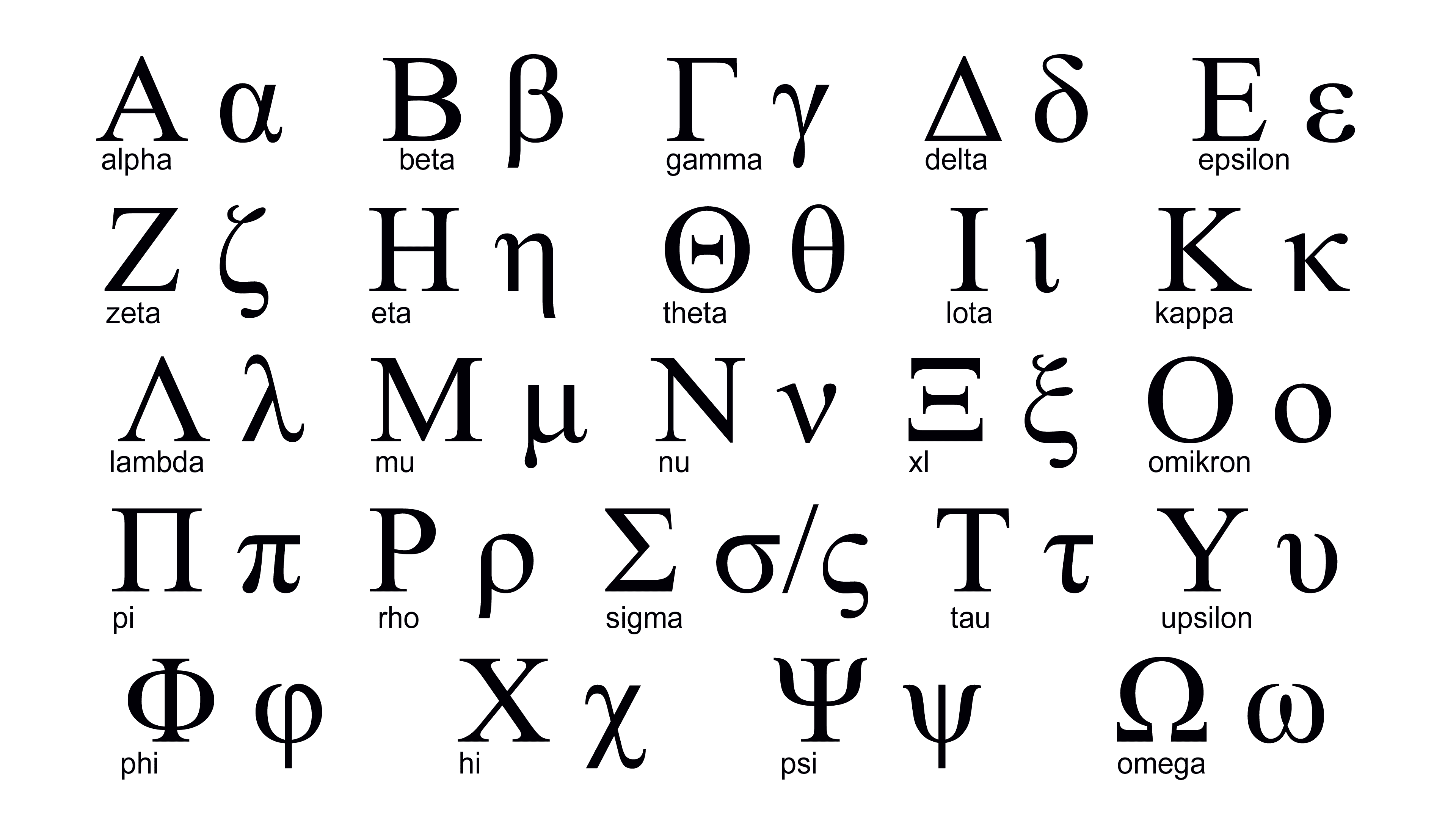
let's do in in roman point of view, in western dialects. But I'm ignorant about the subject, why do I write. In the draft, to understand. It's an exercise I placed in front of me.
alfa
be-ta
gam-ma
del-ta
e-psilon
ze-ta
he-ta
te-ta
io-ta
kappa
lambda
mu
nu
xi
o-micron
pi
rho
sigma
tau
upsilon
phi
hi
psi
omega
and because the names ending with ta group so closely together in the beginning of the alphabet, I separate them from them all and play with them as with some previous and shorter version. Because from simple to more complicated. 24 is still less than 26. So 18 preceded it, 16 preceded that, no matter what they say, they are wrong by this very simple rationale.
be-ta
del-ta
ze-ta
he-ta
te-ta
io-ta
by the order of the labial-lingual-vowel which the first half began I feel the missing 7th note between the fita and yota. And then I see it's not 7th, it's the 5th,
be-ta
del-ta
he-ta
te-ta
ze-ta
io-ta
be-ta
del-ta Δ et Λ
ä-ta
te-ta
ze-ta
ö-ta
ä-ta
be-ta
del-ta
ö-ta
te-ta
ze-ta
A
B
D
Ö
F
Z
logic of what I'm pulling out of ther tells that it should be whethere OVZ or OFS, I casually wrot OPT, but it looked too
AMN OTS
Aмон отец? Аминь Отцу? (у было волей бога, когда палец не меня слушался, это скореей всего оно как только бывает, имет.. в общем, в ы поняли)
A
M
N
O
T
S
Ata Mata Nata Ota Tётя Соседя? методом свободных ассоциаций пришло, как обычно подобные ряды и создаются
рф можно опечататься как ря, что совершенно очень сильно комично
А
М
Н
or
A
B
E
?
That Н is russian N, AMN or ABE? abe отец, но для этого достаточно две буквы АБ
Аб Гд Её Жезл И Кол и Мэн оперсту (у перста или у престола?)
АБе GoD ЕЁ ЖеЗл И й! й разрушает всю эту апофеническую поэзию. но как знать апофения или нет, скорей похоже на неправильно разгляданное изображение, которое в начале проявилось и Аб (отец на иврите. но тогда не аб, но Ав, Av, как в греческом. но абе в значении падре это тоже меметичное, только на каком-то другом языке судя по всему. На иврите это абА и Ав. v одиночная форма, b в слоге. в слоге она звучит, а в одиночестве её легко перепутать, v перепутатьс ложнее и потому что зубы показываются чтоб губку укусить. в отличие от м. и б в данном плане как м, м долгая форма буквы б, а н долгая форма буквы д. я никогда не понимал этого. я думал что в долгая форма буквы б, но она артикуляционно другая. короткая форма буквы V буква W, сколь ни парадоксально, но тогда порядок противоположный тому, который у Б В. но меня порядок Б М должен интересовать. отмотаем назад, там было интересное.
ä-ta
be-ta
del-ta (сделана? done? -ta is -ne?)
ö-ta
fe-ta
se-ta
эники
беники
ели
вареники
Эники-беники
Ели вареники,
Эники-беники-ба —
Вышла буква А.
Эники-беники
Ели вареники,
Эники-беники-фокс- (Эники-беники-клёц Эники-беники-хоп)
Вышел (на палубу (пузатый и)) толстый матрос. (вышел зелёный сироп)
Эники-беники метёлки-веники!
Болики-Лёлики опилки-ролики!
Эни, бени, рики, таки,
Турба, урба, синтибряки,
Эус, бэус, краснобэус, Бац!
Вы наверняка знаете детскую считалочку про то, как эники-беники ели вареники. Но задумывались ли вы когда-нибудь, кто, собственно, такие эти загадочные «эники-беники»? «Тонкости» углубились в удивительный мир лингвистических исследований и раскопали — ни больше ни меньше — 4 версии.
1. Ярославская вилка
Некоторые исследователи считают, что «бенечка» — слово, пришедшее из Ярославской губернии и означающее не что иное, как «вилка». Это понятие зафиксировано в словаре Даля. Если эта версия верна, то все встает на свои места: вареники ели вилкой. А «эники» при такой интерпретации — не что иное, как просто удачная рифма.
2. Система счета
Возможно, «эники-беники» — это исковерканные числительные англо-валлийского счета, восходит к aina, peina. Это довольно редкие числительные, которые использовали только при расчетах между кельтами и непонимающими их языка англо-саксами. А вы думали!
3. Древняя молитва
Согласно третьей версии, эзотерической, «эники-беники» — фраза из древней молитвы, посвященной тюркской богине. На киргизском языке «энеке» означает «матушка», «бээ» — кобылица. Тогда «энеке бээ энеке» переводится как «матушка и кобылица-матушка». Кобылица-матушка — это собирательный образ древней богини половцев-тенгрианцев.
4. «Кость увеличилась»
По еще одной версии «эники-беники» — искаженная транскрипция немецкой фразы «кость увеличилась в два раза», часто звучавшей при игре в кости. В таком случае для русской считалочки фраза могла быть заимствована без перевода и с утратой смысла.
Akka bakka,
banka ranka,
etla metla, sang dang,
fil i fang, isa, bisa, topp!
Akka bakka bonka rakka
etla metla sjong dong
fili fong
issa bissa topp
Akka bakka bonka rakka, issa bissa topp.
Sjong dong filifong, stékk om stein - stå!
Akka bakka
bonka rakka,
etla metla
sjong dong,
filifjong
issa bissa topp
Eeny, meeny, miny, moe,
baji neki baji thou,
elim tilim latim gou.
Anne manne miene mukke,
Ikke tikke takke tukke,
Eere vrouwe grieze knech,
Ikke wikke wakke weg.
Perfect tense is a wonderful case:
in dutch it's different from past simple tense by the prefix ge-
in russian it's different from past simple tense by the prefixes за- or c-
in english it's different from past simple tense by the postfix 've, but because it's placed before the verb, it may also be seen as the same thing.
and the wondrous part here is if we consider с- a reduced за-, russian з shares the position with latin g, and v is also not far from there if it's vav of f.
which is especially funny, because in greek Ζ stands after Ε, so it's all very very close, but what it is about I don't know. Maybe that second line is have, especially since H is also there, and so is e, but not a, but hve could be the form, I have to read the oldest possible sources of english, from the time it was more like dutch or even boefore that
ab
dc
ef
hg
ij
lk
mn
po
qr
ts
uv
xw
yz
ab
dc
ef
hg
ijk
nml
opq
tsr
uvw
zyx
AB
good morning everybody, so far 1:1: the 'f g- з- thing is interesting, the DC thing isn't.
even though AB itself is: a~d and b~c, these two unexplained yet similarities, where t~v thing
DC could explain.
4:20 is the break of day. midnight belongs to the previous day, so I woke up in the eveningn, and thus I had less experience with the weed today. 'vegз thing came to me before I got high, and the other thing is nothing, and now I'm thinking of the events of the previous day, so I do a breakfast, meet the day and smoke again at 4:20, or maybe I won't eat, or maybe it will come to me yet. in the 2:47 I've got to wait.
love is ловушка
лавушка девушка
ладушка дедушка
вот где эти в и д играют, там где кроме них всё одно и то же.
дедушка daddy. D as boy, B as baby
BaBy as попа-попа? с двух сторон полосой снизу заканчивается.
Daddy Tt? this is of two ends ending with tails? or maybe no, maybe boys with tails were more usual before? when medice didn't cut such anomaly off. briest против beast. priest приест как жрец жрёт.
what wiki names rhombic dodecahedron is rhombododecahedron, because it itself is not
Speaklittle and to the point, Be fast, and something third or is it the third. Уходи быстро.
Тятя это повторение. Тя это Т, изображающее половой член, дабы изобразить мускулинность.
т или т, 1 или 3, существенней непосредственного числа видимо имеется в в иду идея нечётности (т и т простая и курсивная формы одной и той же буквы)
body is boy?
body is buddy?
both are volk etimologie, but first is at least more extatic.
ᛆᛒᚦᚾᚠᚵᚼ(or ᛡ)ᛁᚴᛚᛘ(even though it looks like ᛉ)ᚿᚮᚱᛦ(if R, or ᛣ if Q)ᛋᛏᚢ
ᛘ is double ᚴ as ᚠ is double ᚵ
ᛘ is ᚠ
ᚨ is A, and the same with the same short branches
Fighter of this world
Lighter of this lord
all around is lrnd lrn'ed?
ᛘ is ᛉ?
all amount?
ᛉ is ᛘ
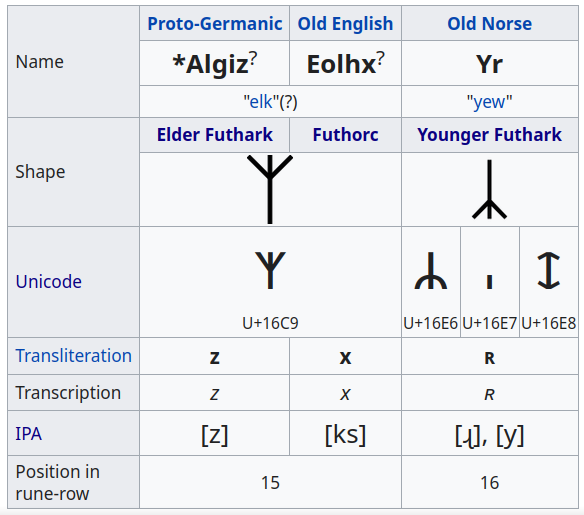
ᛉᛦ could be the PR because how close П to M is, because how ᚱ is П
ᚱᛦ
ᚱ predated П and R for both can be the same letter if they both originated in ᚱ
А как именно к вам пришло осознание сеья ьрнрм: богом?
когда молился и вдруг понял, что разговариваю сам с собой
rкогда осос осознал что мол молиться это молить себя.
cross the heart is to vow in a ..just saw in an animation (luca, probably)
so what do they vow when they cross the hearts. Good thing is they cross it higher than the heart, but if you look from where the god is, exactly the heart it is. So
it means some fucking star
it means I'm a fucking star
routine is ritual
повторенное деяние
ritual is routine
re-деяние (dual = деяние? dual = двойное. tual = деяние? с чего бы вдруг? х.з.)
ka re? nah, I'm trippin'
еврейская риставка бэн когната русского суффикса вна
но вна ближе к она, значит бэн когната русского он.
плита палетта палитра plate плата полотно плоскость простость (plane, plain)
chauler in french sounds almost exactly like жара which it is.
kindred
children
(k~ch n~l d~n and ŋ can unite k~g and n)
ча да
|
ча до
ki nd
child
модель создания книги просто работая со словарём, разбирая следующим образом одно слово за другим, и когда я сумею так сделать, значит я suck seed to succeed добился успеха, не надо биться, добиваться, это какие-то угнетательные , и даже удалось нехорошо, слишком пассивное, manage is an active verb russians don't even have. man age, да еблан повзраслей наконец!
ab-brevia-tion [абривиЭйшн]
со-краще-ние (tion обычно переводится как -ция, значит ли это что н~ц? graphicallyt they're close)
brevis краткий (на латыни) брить обрезать, знать краткий тоже недалеко от cut.
abc [ЭйбИсИ]
алфавит, букварь, основы (алфавитная последовательность в свей чистоте трёх матерей (read aeiou.bt for more.)
ability = способность, умение
able [эйбл] = способный (ебал)
to be able to [ту би Эйбл ту] = мочь (быть в состоянии)
possible [пОсибл] = возможный
possibly [пОсибли] = возможно
this sudden revelation of able cognating in russian ебал (умеешь это? да я это ебал (и в хвост и в гриву, как свои пять пальцев. познать=выебать) говорит о том, что языковые различия могли быть вызваны табуированием тех или иных слов в разных культурах, так что тем приходилось находить синонимы, а иногда и не находить. В русском нет manage (удаваться пассивный залог совсем другого понятия: удалось = далось полностью = was recieved well, было получено, получилось, преуспевать is to succeed, but manage is what happens before the success. Before you succeed you manage, мужаешься, или это от manus (рука по латыни) тогда )
[энд дуинг соу ай фаунд ipa сайнс ту мэйк ит мо дификулт фо лёрнер ту лёрн ит.
соу ай юс зы лэтаз зэй олрэди ноу.]
aboard [эбОорд]
на борту
board [бОорд] = борт
about [эбАут]
об (out [Аут] = наружу (от))
(ab на латыни значит от, оff. т.е. это слово-билингва? не так ли создавались слова из односложных? не всегда, но быть может само слово слово=some slo + wo of word?)
above [эбАв]
над (ab на латыни значит от, оff)
ove ~ over (над: over the head = над головой) (сверх: overprice = наценка, завышенная цена) (снова: game over = геймись ещё) (истекать: game over игра закончена)
abroad
за границей
road дорога
город = co-road? cross-road? 𓊕 is ideogram for city in egyptian. город = дорог? привет, лукашевич, дорогОй город, дорОгой. другой. град by road? g~B again? and again?
so
- አ ቡ ጊ ዳ ሄ ው ዞ — а бу ги да хе вы зо
- በ ጉ ዲ ሃ ዌ ዝ ዦ — бэ гу ди ха ве зы жо
- ገ ዱ ሂ ዋ ዜ ዥ ሖ — гэ ду хи ва зе жы хо
- ደ ሁ ዊ ዛ ዤ ሕ ጦ — дэ ху ви за же хы то
- ሀ ዉ ዚ ዣ ሔ ጥ ጮ — хэ ву зи жа хе ты чо
- ወ ዙ ዢ ሓ ጤ ጭ ዮ — вэ зу жи ха те чы йо
- ዘ ዡ ሒ ጣ ጬ ይ ኮ — зэ жу хи та че йы ко
- ዠ ሑ ጢ ጫ ዬ ክ ኾ — жэ ху ти ча йе кы хо
- ሐ ጡ ጪ ያ ኬ ኽ ሎ — хэ ту чи йа ке хы ло
- ጠ ጩ ዪ ካ ኼ ል ሞ — тэ чу йи ка хе лы мо
- ጨ ዩ ኪ ኻ ሌ ም ኖ — чэ йу ки ха ле мы но
- የ ኩ ኺ ላ ሜ ን ኞ — йэ ку хи ля ме ны нё
- ከ ኹ ሊ ማ ኔ ኝ ሶ — кэ ху ли ма не ны со
- ኸ ሉ ሚ ና ኜ ስ ሾ — хэ лю ми на не сы шо
- ለ ሙ ኒ ኛ ሴ ሽ ዖ — лэ му ни ня се шы ъо
- መ ኑ ኚ ሳ ሼ ዕ ፎ — мэ ну ни са ше ъы фо
- ነ ኙ ሲ ሻ ዔ ፍ ጾ — нэ ню си ша ъэ фы цо
- ኘ ሱ ሺ ዓ ፌ ጽ ቆ — не су ши ъа фе цы ко
- ሰ ሹ ዒ ፋ ጼ ቅ ሮ — сэ шу ъи фа це кы ро
- ሸ ዑ ፊ ጻ ቄ ር ሦ — шэ ъу фи ца ке ры со
- ዐ ፉ ጺ ቃ ሬ ሥ ቶ — э фу ци ка ре сы то
- ፈ ጹ ቂ ራ ሤ ት ቾ — фэ цу ки ра се ты чо
- ጸ ቁ ሪ ሣ ቴ ች ኆ — цэ ку ри са те чы хо
- ቀ ሩ ሢ ታ ቼ ኅ ጶ — кэ ру си та че хы по
- ረ ሡ ቲ ቻ ኄ ጵ ፆ — рэ су ти ча хе пы цо
- ሠ ቱ ቺ ኃ ጴ ፅ ፖ — сэ ту чи ха пе цы по
- ተ ቹ ኂ ጳ ፄ ፕ ጆ — тэ чу хи па це пы джо
- ቸ ኁ ጲ ፃ ፔ ጅ ኦ — чэ ху пи ца пе джы ъо
- ኀ ጱ ፂ ፓ ጄ እ ቦ — хэ пу ци па дже ъы бо
- ጰ ፁ ፒ ጃ ኤ ብ ጎ — пэ цу пи джа ъэ бы го
- ፀ ፑ ጂ ኣ ቤ ግ ዶ — цэ пу джи ъа бе гы до
- ፐ ጁ ኢ ባ ጌ ድ ሆ — пэ джу ъи ба ге ды хо
- ጀ ኡ ቢ ጋ ዴ ህ ዎ — джэ ъу би га де хы во
It looks like canon of one line is common and further they interpreted it by themselves using some common phonetic ideas, probably transmitted by songs, so everybody had to transliterate the nuances the way they invented it again and again not knowing that some neighbours may have the transliteration system already invented, and thus it would explain the different ways different nations write today.
ባ and ቦ are ba and bo
ጋ and ጎ are ga and go, so it's not as systemic as it could be, and this archaic inconvenient abugida even though it is a historic evidence of some ancient ideas (so it could be preserving the phonetic sequence of a u i and a again the way it is in ogham aouei
and this common thing may tell that the same way beth-luis-nion tells the story of 5-fold system being 3-fold in its origins, the vowels also were 3-fold, so let's investigate that 3*3 writing system?
b l n
a
o
i
baloni (baloney indeed)
is it where this word originates? in the mocking of somebody discovering this oghamic sequence before me?
LVX (lux) is 65 or 55?
IVXLCD
IVKSLCD
IVKHSLCD
IVKHSLRCD
EFGHOPRST
IBFVWGKHSZLRCJDT
IBFMVWGHKQXCDZST (and LRJ somewhere in between)
I imagined how it could go and I made it arbitrary and it went out Interestingly. And I've got the Idea that J at the place of M could be Y [ю] parrotting ו the vav.

Бог и God are two ways to pronounce the same word.
it summarizes that г read as в in russian.
Й ~ N
-ый, -ой = он
ая = она [ана]
ое = оё = оно
Thinking of amen ~ ΛΜΝ ~ lemon
thought how citrons could be the tree of knowing good and evil, that oranges are good (sweet) and lemons are evil (bitter, sour? acidy, acidic, acetous, acerbic)
цитрус ~ цедра
желтый~зелёный~злой
оранжевый~красный~классный (red рад)
Were citruses considered poisonous and thus forbidden fruit?
And some "wise snake" told people that it's good to eat them if they know good from evil (red from green) and those who ate them thus broke taboo and was evicted from the garden.
and https://en.wikipedia.org/wiki/Citrus#History tells some very interesting stories and gives some interesting names, such as Citrus medica
The citron (Citrus medica) is a large fragrant citrus fruit with a thick rind. It is one of the original citrus fruits from which all other citrus types developed through natural hybrid speciation or artificial hybridization.[3] Though citron cultivars take on a wide variety of physical forms, they are all closely related genetically. It is used in Asian cuisine, traditional medicines, perfume, and religious rituals and offerings.
and though other versions for what could be the forbidden fruit are given here and elsewhere (fig aka инжир, vine, psychodelic mushrooms, cannabis, ergot, etc. the fig even has new reasons to be it other than sycamore is so bibleic (see инжир for more) here: Like other plant species in the family Moraceae, contact with the milky sap of Ficus carica followed by exposure to ultraviolet light can cause phytophotodermatitis,[44][45] a potentially serious skin inflammation. Although the plant is not poisonous per se, F. carica is listed in the FDA Database of Poisonous Plants.[46] also because Adam and Eve used fig leaves to cover their nudity) this new version about citron makes too much sense to be disregarded:
https://en.wikipedia.org/wiki/Etrog
On the first day you shall take the fruit of majestic trees, branches of palm trees, boughs of leafy trees, and willows of the brook; and you shall rejoice before the Lord your God for seven days.
— Leviticus 23:40, New Revised Standard Version
While the biblical phrase peri eitz hadar (פְּרִי עֵץ הָדָר) (translated above as "fruit of majestic trees") may be interpreted or translated in a number of ways, the Talmud derives that the phrase refers to the etrog.

Original mosaic of ancient Maon Synagogue (before the 6th century CE), depicting etrogim at the base of a menorah.
4chan is shi-chan, deaths & girls, the range from guro to kawaii that site offers.
Before previous line came to me I was thinking of that site being kinda satanic, from the point of view of a christian, because many sinful things are on it, and also freedom is not what that backward religion tolerates. So I had that, then the shi-chan thing, and now (an hour ago or so) I see shichan is similar to satan. And if tan is chan then sa is shi. and sat is shite is shit and if shi is death than shit is dead.
(is sh makes that syllable palatalized? de, not da. but then tott but then t~s~
子猫 koneko (ko neko, small cat, kitten)
猫咪 mao mi (cat miaow, mi or mai is miaouw)
猫 mao is cat in chinese
ニャー (nya) is meow
咪 is not in japanese
or is it..
Kun: めえとる Me e toru めえとる is to meet in japanese (according to g-translator)
On: ビ、 ベイ Bi, bei
It is some chinese myao, but also "Don't!" in cantonese
and it's readings are all variety of labials:
god is гад
бог is bog (whole space of
кот is god
dog is the opposite (hell hounds, cerberi, I am now with dogs, because I found them godly, but they are dirty in muslim view. What do I care. Cats are gods in semite view?
I'm hermaphobe and this is why I have to
cross your heart? Why would I ever cross my heart? Why would I ever double croass me? I am einsane.
einstein is also stein
insane in stone? I want to be in stone? I want to live in stone. I want to cross this world through. I want to go home. I want to sit in my home and not cross no world.
mdma looks like mama and it is kind as her. 90s were great because of it.
warned is armed
war? armed as warmed? warmade? warmight.
Let's practice peace instead. Protection. pokoy pokoи pokoй pokrov по кров? what is по?
Lucifer is лучше (luckier, said I in the end of vol. 13)
B is double D
F is double Г(G)
all this make me think that the alphabet is the other way around (because the theory of it is lost)
Я Ю Э
is it the initial trible?
Ь Ы Ъ
ся y ex
сь
Z Y X
аз you это (э is not ver often letter, and this (это) is as russian as it gets. with то, it,
я that = the it?
the as in there?
this is not his.
(he're it was?) here he's his
there they're their
Рифмуя боже и его же, узпрел что
разделение уз-рел дало понимание слова не такое, какое школьная морфология даёт (уз реал (как в реалайз) а не у-зрел. как плод зрел?)
понимая узрел как уз рел перетряхивает всю голову. попробуем на всё так посмотреть дабы понять куда это может привести.
Многослойность имира проязвляюется когда разводы на металле показались трёхмерными, словно из стекла и многослойные, не мог понять что за глюк, пока не понял что это капли от душа делают поверхность металла действительно многослойной (я ещё и под углом на них смотрел, когда они одна поверх другой как будто ложились, узор создавая непонятный совершенно) но это оффтопик, конечно, у меня здесь такого до
достаточность. достопримечательность.
если бог это bog и g в bog это g of god which is гад, 𓆓 ~ Г
то что есть бо?
'll 'm
're 's
are the only ones with ' and they are right one above the other
A B C D
E F G H
I J K L M N
O P Q R S T
U V W X Y Z
there's also 'd
and 've
A B C D
E F G H
I J K L M N
O P Q R S T
U V W X Y Z
Looking and the USA I see not a violent revolution, but silent resolution.
've = 's if 's is not is but has.
S~T~V?
Freinds call me to discord, but discordian agenda is just not my thing, and thus I think I'm with god now. Where am I? I'm in the between. I'm good enough so they fight for me.
enough = and oh? en ough?
very good is merry good?
forms that me talke:
咪 Phono-semantic compound (形聲): semantic 口 (“mouth; speech”) + phonetic 米 (OC *miːʔ).
咪
meow
sound used to call a cat
Used in 咪咪 (mīmī, “(slang) breasts; tits; boobs”).
唵嘛呢叭咪吽 (ǎn mānī bēimēi hōng) om mani padme hum
Oṃ maṇi padme hūṃ[1] (Sanskrit: ॐ मणि पद्मे हूँ, IPA: [õːː mɐɳɪ pɐdmeː ɦũː]) is the six-syllabled Sanskrit mantra particularly associated with the four-armed Shadakshari form of Avalokiteshvara, the bodhisattva of compassion. It first appeared in the Mahayana Kāraṇḍavyūhasūtra where it is also referred to as the sadaksara (six syllabled) and the paramahrdaya, or “innermost heart” of Avalokiteshvara.[2] In this text the mantra is seen as the condensed form of all Buddhist teachings.[3]
The first word Aum/Om is a sacred syllable in various Indian religions, and Hum represents the spirit of enlightenment.[4]
In Tibetan Buddhism, this is the most ubiquitous mantra and the most popular form of religious practice, performed by laypersons and monastics alike. It is also an ever present feature of the landscape, commonly carved onto rocks, known as mani stones, painted into the sides of hills or else it is written on prayer flags and prayer wheels.[5]
Due to the increased interactions between Chinese Buddhists and Tibetans and Mongolians during the 11th century, the mantra also entered Chinese Buddhism.[6] The mantra has also been adapted into Chinese Taoism.[7]
so far only mi, me~mei, here comes mai, and soon it gets very interesting, what I wanted to show you, all the labials meet in it. (meet ~ in it)
Cantonese (Jyutping): mai6
咪 (Cantonese)
When used with 囉/啰 (lo1) at the end of a phrase, used to spell out something obvious.
本書咪已經還返畀你囉。 [Cantonese, trad.]
本书咪已经还返畀你啰。 [Cantonese, simp.]
bun2 syu1 mai6 ji5 ging1 waan4 faan1 bei2 nei5 lo1. [Jyutping]
I've already given the book back to you, haven't I?
When used with 囉/啰 (lo1) or rising intonation at the end of a phrase, used to connect a condition to a result or suggestion.
你想睇戲咪買飛囉。 [Cantonese, trad.]
你想睇戏咪买飞啰。 [Cantonese, simp.]
nei5 soeng2 tai2 hei3 mai6 maai5 fei1 lo1. [Jyutping]
If you want to watch a movie, then buy your tickets.
你食埋咁多煎炸嘢咪好熱氣? [Cantonese, trad.]
你食埋咁多煎炸嘢咪好热气? [Cantonese, simp.]
nei5 sik6 maai4 gam3 do1 zin1 zaa3 je5 mai6 hou2 jit6 hei3? [Jyutping]
If you're eating so much fried stuff, won't you build up a lot of internal heat?
Used as the negative of 係/系 (hai6) when asking a question.
佢哋係咪返嗮屋企喇? [Cantonese, trad.]
佢哋系咪返嗮屋企喇? [Cantonese, simp.]
keoi5 dei6 hai6 mai6 faan1 saai3 uk1 kei5-2 laa3? [Jyutping]
Did they all go home?
咪 (Cantonese)
(imperative) don't
咪咁多事啦! [Cantonese] ― mai5 gam3 do1 si6 laa1! [Jyutping] ― Don't be so nosy!
咪 (Cantonese, Hakka)
Short for 咪高峰 (“microphone”). (Classifier: 支)
(obsolete or Cantonese) mile quotations ▼
(Cantonese, informal) mile per hour
(Cantonese, informal) kilometre per hour
呢度行六十咪㗎咋喎。 [Cantonese, trad.]
呢度行六十咪㗎咋㖞。 [Cantonese, simp.]
nei1 dou6 haang4 luk6 sap6 mai1 gaa3 zaa3 wo3. [Jyutping]
You should only be driving at 60 km/h.
Notice how here mai has different tone, but the hieroglyph gives out it as the same mai.
Cantonese (Jyutping): mai1
咪 (Cantonese)
to study hard
Cantonese (Jyutping): mai1
咪 (Cantonese)
to peel with a knife
to pinch (with fingernails)
For pronunciation and definitions of 咪 – see 米 (“metre”).
(This character, 咪, is a variant form of 米.)
For pronunciation and definitions of 咪 – see 咩 (“the call of a sheep”).
(This character, 咪, is a variant form of 咩.)
Japanese
Kanji
咪
(uncommon “Hyōgai” kanji)
baa (bleating of a sheep)
meter
Readings
Go-on: み (mi)
Kan-on: び (bi)
Kun: メートル (mētoru, 咪)
notice how there are two on-readings. Both are chinese, and bi and baa is what I was looking for, but I saw bha or bhe and p something somewhere else. but then I noticed that it's mile in china and metre in japan, and some chinese definition also take it for a metre, which could be used for maps scaled to 1000 or to long and short scales of large numbers, some complicated crookery of the top level.
so I give that hieroglyph in other nations who used them in the past and go to where that link leads.
Korean
Hanja
咪 • (mi) (hangeul 미, revised mi, McCune–Reischauer mi)
Vietnamese
Han character
咪: Hán Nôm readings: mễ
and suddenly I saw where I saw that bhi (but not pi, bi) variant, and the image leads to where I took it:

and let's go that link from up there:

From Proto-Sino-Tibetan *ma-j ~ mej (“rice; paddy”). Cognate with Garo mi (“rice”), Atong (India) mai (“rice”), Jingpho ma (“rice; paddy”), Rabha মাই (mai), Dimasa mai.
米
1
hulled or husked uncooked rice
husked seed
grain-like things
(chiefly Cantonese) Short for 米粉 (mǐfěn, “rice vermicelli”).
星洲炒米 ― Xīngzhōu chǎomǐ ― Singapore-style noodles
2
Short for 米突 (mǐtū), from English metre.
Pronunciation
Mandarin
(Pinyin): mǐ (mi3)
Cantonese
(Guangzhou, Jyutping): mai5, mai5-1
(Taishan, Wiktionary): mai2
Hakka
(Sixian, PFS): mí
(Meixian, Guangdong): mi3
Min Bei (KCR): mǐ
Min Dong (BUC): mī
Min Nan
(Hokkien, POJ): bí
(Teochew, Peng'im): bhi2
米
metre
米三 [Teochew] ― bhi2 san1 [Peng'im] ― 1.3 metres
我有一米九高。 ― Wǒ yǒu yī mǐ jiǔ gāo. ― I'm 1.9 metres tall.
So it's all about the tone, it seems metre is mii and mile is mi, but the same word used for units one thousand time the other is known to me in russian, where rouble is both 1 rouble and 1000 roubles depending on the context, probably that chinese peculiarity is of the same nature, whether it's a military trick or whatever else.
gay and gray are too opposites.
gay is new gray (maybe it is when you can see better, you see the elements and shades of gray. Or what are the basically gray areas? I have to research those surfaces. To see their spectrum in detail, to build some eyes better than mine, and to roll them around to see that it's not the sensorsshining differently, that it's actually what the light reflects. )
the letters people disagree about the most are the most ancient or the most recent? It's only two possibilities to explore:
C, G, k s ч г дж (and comparison to C tells that z should be between those г & дж, and greek line tells it is. Z is digamma? also this. the question. yet. ΕΖΗΘ EGHF
three additional numerals are probably some reform when octal system became nonal
I heard at some linguistic argument online that russian and english numerals are all cognates, and that восемь девять суть осемь невять
I have no idea if it's true. If it is, osem next to ocht explains why russian cursive т is т
And невять instead of девять demands too many: d~n? v~n? no? ть~n? v~o? d~n~t? эти назывались зубными? язычными были с, not d? lng are linguals, and n in it too. N separated and made d and t?
ŋ as the proto G? and I suddenly see that ŋ is upside down G, and there are many upside down letters in phonetics, the upside down font is all based upon those:
abcdefghijklmnopqrstuvwxyzABCDEFGHIJKLMNOPQRSTUVWXYZ1234567890!&()_[]',.<>?"{}
when sticked into upsidedowntext.com is like this:
ɐqɔpǝɟƃɥᴉɾʞlɯuodbɹsʇnʌʍxʎz∀qƆpƎℲפHIſʞ˥WNOԀQɹS┴∩ΛMX⅄ZƖᄅƐㄣϛ9ㄥ 860¡⅋)(‾][,'˙><¿,,}{
If it's not true, then one two three is the most based, the most common part of the numerals, four is already quatre четыре some
five as пять has nowhere to run but to quinque being пять and as I guwessed wearlier, qu~ф and Ф~В.
O Ф 𐌈
O Θ 𐌈
O ו + but this guess is not supported by BD and FГ thing.
that + and 𐌈 are pulled for T and 𐌈 is from archaic greek where they don't seem to have other
𐌀𐌁𐌂𐌃𐌄𐌅𐌆𐌇𐌈𐌉𐌊𐌋𐌌𐌍𐌎𐌏𐌐𐌑𐌒𐌓𐌔𐌕𐌖𐌗𐌘𐌙𐌚𐌛𐌜𐌝 𐌞
Their O is 𐌏
Their Θ is 𐌈
which is a good progression, because it's in the same direction, but then there's about 50% chance that it was.
But then they have another retarded letter like 𐌈: 𐌎, and if 𐌎 is some dz, then 𐌈 is some th too. Z? yes, both are final letters, so they only naturally have some Zness to them.
I also shouldn't go that far into the past, because it's all reconstructed, and humanities are soft sciences, and there are plenty of information in the actual world, in the unbroken traditons like chinese and sanskrit suddenly being similar, let's compare all the mantras written and meaningful in both chinese and sanskrit:
唵 嘛呢 叭咪 吽 (ǎn mānī bēimēi hōng)
ॐ मणि पद्मे हूँ [õːː mɐɳɪ pɐdmeː ɦũː]
om mani padme hum
humming, ommanipadmehumming
唵 嘛 呢 叭 咪 吽
ॐ म णि प द्मे हूँ
My guess is that they're related writing systems.
but so far I can only see that 唵 kinda looks like it's mirrored ॐ (and thus chinese could be directly seen in arabic, let's entertain this +
And that each chinese character begins with the same box
_p1.387_Schriftproben.jpg)
These are om mani padme hum written in different languages and I like how in the 8th example ma and me are different with that vowel diacritics.
And it made me look at that ma closely, and I saw it being the ma for good, 嘛, but without that mouth box at the beginning it's hemp: 麻 and also ma, so in that boxed variant it's both phonetic and semantic (somehow it's different from all other boxes, and that box is for some abstract concepts made out of the concrete ones) 大麻 dama, big hemp, is the cannabis as marijuana.
嘛呢 is man? g-translator tells so, but I only found 嘛呢 in the context of 閒著幹嘛呢 (what are you doing?)
and jumping around chinese translations I found that ban is chinese: 办 (manage, do, run, handle, set up, go about, bring to justice, make ready)
办 is like 力 with hands
力 is force, it sounds as Li, which you may have met in Bruce Lee.
But his Lee is 李: 李小龍 li sui lung, such li is plum.
Chinese is weird, I wonder what is the connection. plum is sliva in russian, contains that li, so could be some chinese su li wa or something. Plum is 李子 li tsu, where tsu is child, so the li is the tree, and its fruit is li tsu, and that could be the su in my hypothetical su li wa, and then that tsu is closer to so of son.
тсу is not that far from дитя. дети как ци? 子 is tsi, son, сын is even closer. What made me think it was tsu? The way it's pronounced in 李子 even though it's transliterated as Lǐzǐ, but then 子 alone is transliterated as Li without that v-like tag above i, thus tones seem to be pretty arbitrary, depending on the context of словоупотребления.
Back to ǎn mānī bēimēi hōng
मणि is gem, precious stone, so if that ma is good, then ni must stand for stone
呢 (ni) is both question particle and cloth (clothes is literally ткани, тряпки)
Does this mantra mean in chinese something different? Because hemp cloth is quite a fit. good cloth is naturally hemp, it's much more firm than woolen cloth and it doesn't shrink in water.
ni doesn't seem to stand for stone neither in hindi nor in chinese
णि (ni) is "and" and it is not in hindi, it's some
नि (ni) is translated as "prohibit" but reverse translation doesn't find that thing
Looking at this I saw б-г дев (дев is бог in some eastern languages)

but after that some glossalally begins захоти калым? насыпать? крошит? and of course I don't know the language where бог and dev would coexist, unless dev and deva is the same thing, then russian knows these words, so it was only natural that I applied russian to this thing, even though it's very freaky.
Yes, I know hebrew goes right to left, but I made it the same way as other alphabets, I may try to rearange them sometimes, just to see it from another angle, and I think I will do it right now:
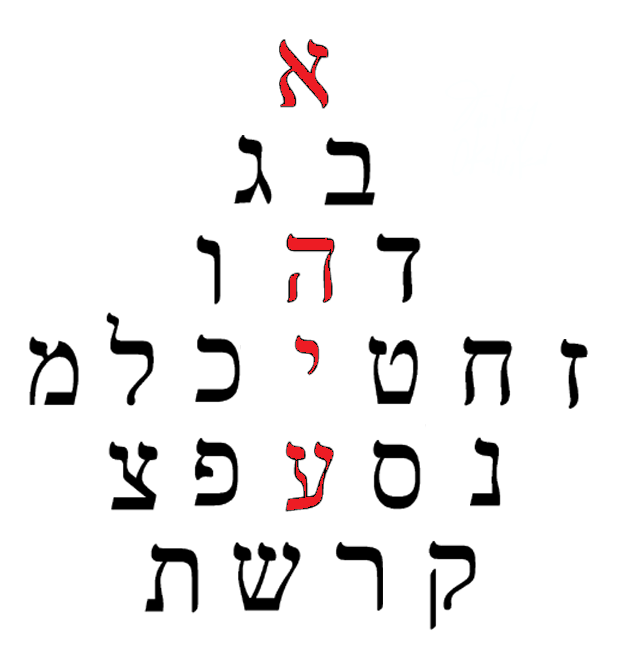
and here I see בְּרֵאשִׁית
the first word of the bible is the final word of the alphabet?
And I expected some mighty name to explain where letters stand in I-line, and elohim is a good explanation for י כ ל מ so malik, meleh, king. Not elohim, but amalek? Like what were the chances!
Amalek (/ˈæməlɛk/; Hebrew: עֲמָלֵק, 'Ămālēq, Arabic: عماليق 'Amālīq) was a nation described in the Hebrew Bible as a staunch enemy of the Israelites. The name "Amalek" can refer to the nation's founder, a grandson of Esau; his descendants, the Amalekites; or the territories of Amalek, which they inhabited.
In some rabbinical interpretations, Amalek is etymologised as am lak, 'a people who lick (blood)',[2] but most specialists regard the origin to be unknown.
In the oracle of Balaam, Amalek was called the 'first of the nations'.
America!
AMLIKN
叭咪
叭 horn, bah! (вспомогательный глагол)denote a sharp noise
咪 is the one which led me to it. and G translates it into russian as мама and in english as mum, mew, miaow
पद्मे is not translated by G, which doesn't mean it is meaningless, it only means that I don't know it.
हूँ is translated into english as am and in russian as являюсь (and it makes me wonder if it is an accurate translation, I'm way out of my depth)
吽 is translated as hum or гул which could be so, or I suspect just as am it is simply transliterated, maybe these signs don't appear outside of this mantra, or maybe G is n't good in these languages yet, but soon they will. Soon world will become perfect if we do not destroy this world again.
Saline and vaseline are two first substances I am about to use in close proximity to our bodies.
обыденный обыдленный
sintoism could be confused with sino-ism? sino is china but sinto is japan.
I'm saying again, japanese is more ancient than chinese, the writing that is, it's antiscientific, but for whatever reason japanese writing is worked much better and deeper than chinese. Japanese literature is more prominient than chinese, japanese poetry is famous, many people know their metres such as hayku and tanka and makura kotoba is something only specialists know, but there it is too, several syllabics and this i ni mi thing. or is it any many? a m and that is it. aum. which is probably both ам и ау.
жёлтый
zholtyy
жовтий
zhovtyy
Λ ~ V ?
Λ ≈ V
ł [w]
Ł or ł, described in English as L with stroke, is a letter of the Polish, Kashubian, Sorbian, Belarusian Latin, Ukrainian Latin, Wymysorys, Navajo, Dëne Sųłıné, Inupiaq, Zuni, Hupa, Sm'álgyax, Nisga'a, and Dogrib alphabets, several proposed alphabets for the Venetian language, and the ISO 11940 romanization of the Thai script. In some Slavic languages, it represents the continuation of Proto-Slavic, non-palatal ⟨L⟩ (dark L), except in Polish, Kashubian, and Sorbian, where it evolved further into /w/. In most non-European languages, it represents a voiceless alveolar lateral fricative or similar sound.
winner winer waina война вина бойня вые-на вы-ена
вина ~ winner?
(при прощании) давай ~ (go away) ga weg
but (few days later) I got high again, so it's too early to say goodbye.
So let's do it from scratch keeping in mind what we already know:
Yin and Yang as the basis of it and further meanings travel from it in the manner of hexagrams or something.
Be and Do
Me and Thou
In (В [v]) and ouT
I as i-? Me as no? Thou as duh? You as yeah
No and Yes (and it tells that be is "just be, don't do a thing" and also it explains chinese Bu)
Me and You (me be and you do)
He Here? The third person as the third element. Which may tell that the thing I found to the end of vol.1 could be accurate and true.
Let's post it again:

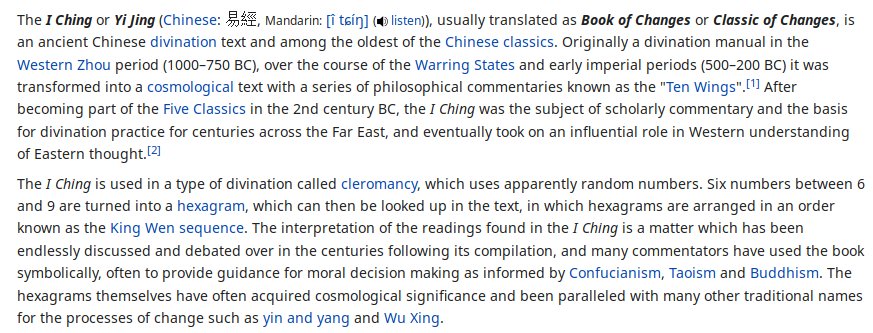
易經 is literally ChangeConstant and also EasyThrough, EasyManage, AmiableStand which tell of it as of something very practical, and so I must study it. You must study it, we all should study all such etexts.
And it looks like Canon of Supreme Mystery is not translated, and this is the best I could find: http://chinesenotes.com/taixuanjing/taixuanjing001.html (mirror)
but then there is more: https://web.archive.org/web/20120715120535/http://www.valdostamuseum.org/hamsmith/ichgene6.html
and it further links to https://web.archive.org/web/20000519213254/http://www.pse.che.tohoku.ac.jp/~msuzuki/MagicSquare.html
and many more. And I probably have to read it, but I maybe do when I return here another time.
For now, I will only collect what I find in german version of wiki, as I suspected, german linguistics is much better than english one, german science is traditionally better than jew.. brittish.
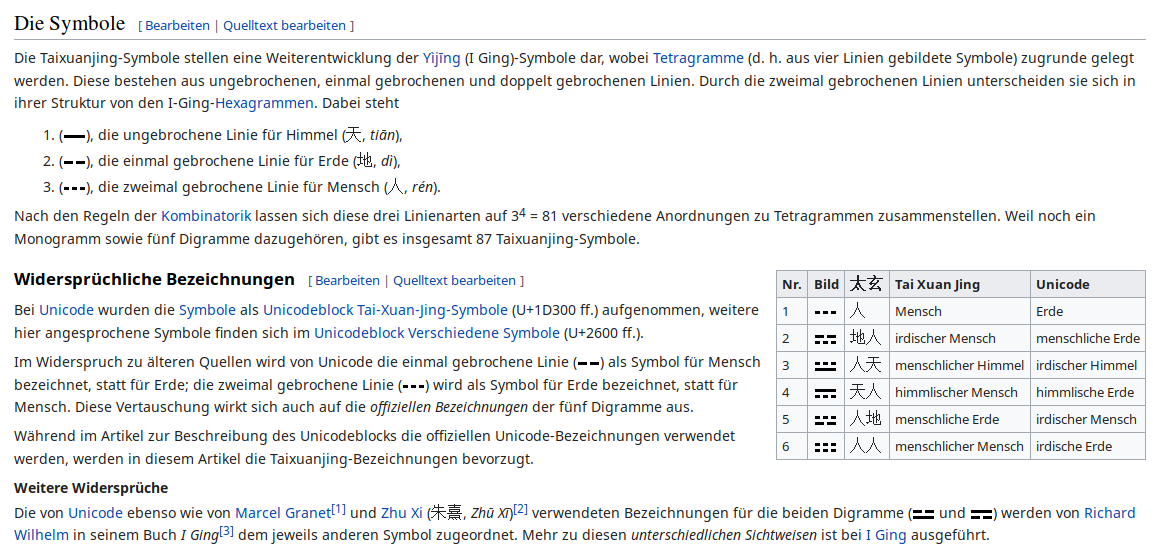

german language contains some very interesting word: jeweils, jeweilige,
Irony is Iron's, Iron s (the space is a typo ist' Irons, but wsomething pushem me to type a space there too)
беспокойный is бес покойный (deceised deceased spirit ghost demon)
There link to reactions is broken (there = their in such context, and probably originally (he's here's, his here's)
Why do I usurp somebody else's stuff in those screenshots? I give them in screenshots because it isn't my text.
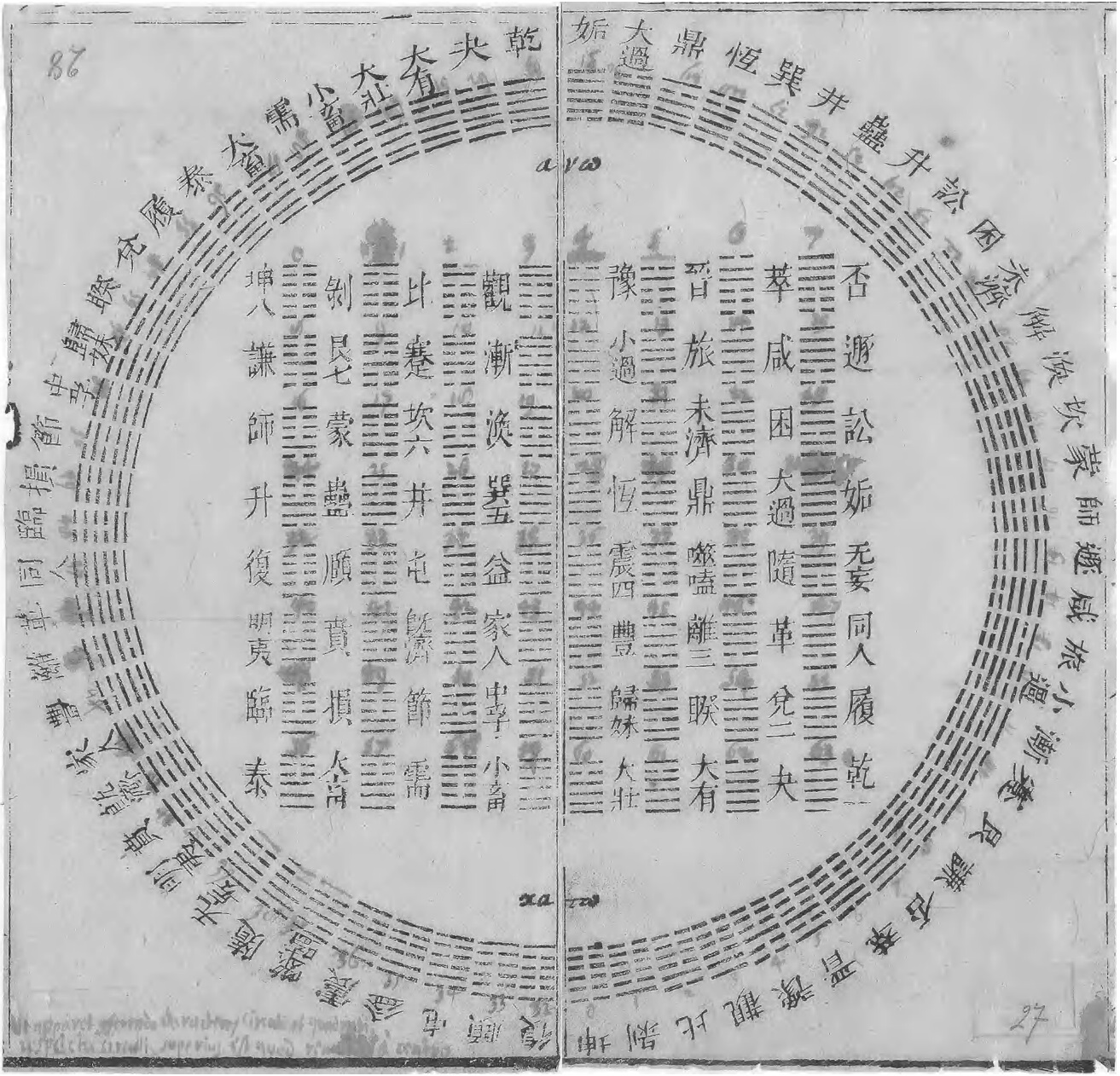
Here, just read the hieroglyphs and you know the meaning iof of the hexagrams.
But here, I can have it in english, so you can learn the hieroglyphs by comparison:
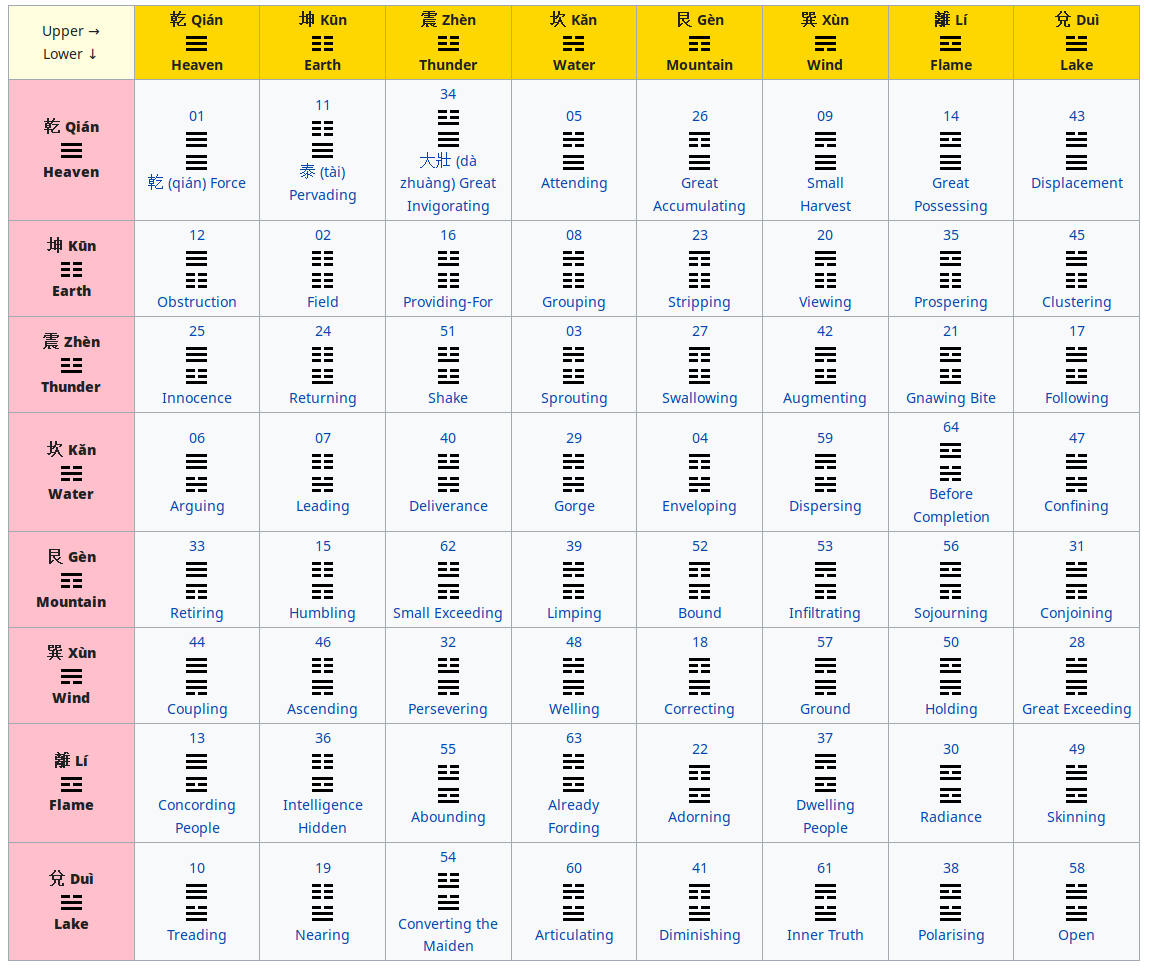
I maybe return to it later. I suspect some even more ancient, not digrams, not hexagrams, but quadragrams, of duals multiplied, not threes. But then I haven't found many traces of that uther than what I had in the end of vol.1:
Старая Инь 老陰, Молодой Ян 少陽, Молодая Инь 少陰, Старый Ян 老陽.
GREATER YANG ⚌
LESSER YIN ⚍
LESSER YANG ⚎
GREATER YIN ⚏
Father Daughter Son Mother?
Beware, these speculations are shaky at best, as it will be further shown, but to demonstrate the thought process full of efforts and errors,
Fire Father 🜂
Water Mother 🜄 (мыть, мочить: женщины лучше обоняют, а потому моют детей чаще)
Air is of Father, thus it's Son, 🜁 Aether, Amour.
Soil is of Water. thus it's Daughter. 🜃 Earth is a female deity, and spirit above water is son fucked his mom, a motherfucker, but then I could be a perverted fantasy writer.
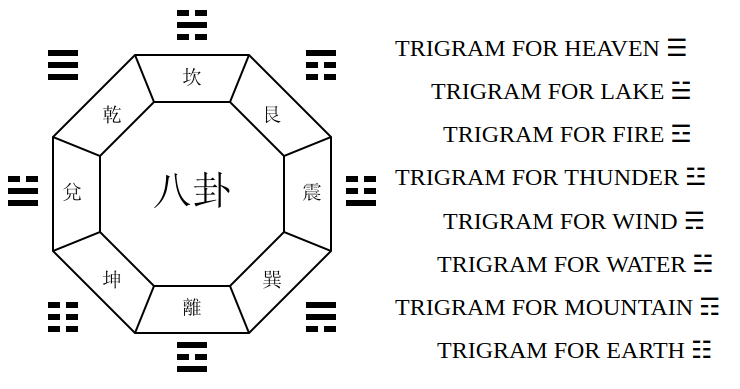
And if I even recgnized tham truly that greater yang is fire, then ⚌
But here if ⚏ is water, then
Lines in hexagrams are called yáo: 爻
The I Ching book was traditionally split up in two parts with the first part covering the first 30 hexagrams of the King Wen sequence and the second part with the remaining 34.[2][3] The reason for this was not mentioned in the classic commentaries but was explained in later Yuan dynasty commentaries: 8 hexagrams are the same when turned upside down and the other 56 present a different hexagram if inverted. This allows the hexagrams to be displayed succinctly in two equal columns or rows of 18 unique hexagrams each; half of the 56 invertible hexagrams plus the 8 non-invertible.[4][5]

and suddenly maori reminds indoeuropean languages and japanese too:
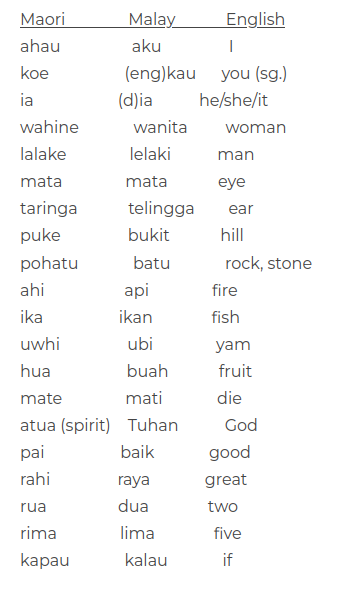
ahau ~ ah (scottish I, сравни: аз) ani (hebrew) ik (german)
koe ~ kimi (but then is it safe to link accidental similarities?
What if I just make multilangauge variants some k~ for thee. g~d
thee people say when they pray and this is theo (deus) феё (ибо откуда нам знать когого оно поло) но затем инвокация не влияет ли кто приходит? но по-христиански ли это молиться разным? матери молятся некоторые христиане, святым заступникам.
I leave it here, there are much more,
ia ея (her? 'er её)
wahine вагина богиня women (man ~ he ~ hito (he-то, тот-то))
lelaki (нет аналогов, ребяты, чувак, что угодно, лишь рифмуется, le, la, he? why not ki of kimi?
mata eye японское me (японцы географически примерно также распределены.
telingga (ear) telling, ringer
puke bukit (hill) пук, пачка, back, but that is already a stretch, see sometimes I go too far, but who knows if I go where I want when I go a little less far)
pohatu batu (stone) potato batata
ahi api (fire) hi (japanese) pier, fire
ika ikan (fish) sakana (japanese) that ka in both, but then wouldn't I find parallels somewhere?
uwhi ubi (yam) to my surprise it is the same (potato batata) I spoke few lines before, I couldn't know it. Or could I? Subconsciously maybe, yummy. yum. ням (but this is to the yam thing, but that's english.
I couldn't know yam is batata potato pasta пища постой (вставать на постой, гостой, пустой, густой,
host & гость~гости. но это я гадаю, это сырой кусок, burn it with fire.
uwhi ubi don't have similar words I know of. (if anything, I'm showing how I memorize words I know (I'm really proficient speaker of the english languge, evwen though I fuckup sometimes, I know english rather well, I almost never look into dictionaries when I write in english here, when I read I do look into dictionaries, when I read some other people's texts.
hua buah (fruit) doesn't have similar words I know of.
mate mati (die) мереть, мати как кали ма, смерть, мать (одна из великих матерей смерть)
рождение (ребёнок среднего рода?) жизнь (женского рода) смерть (женского рода)
atua tuhan (god) духан akuma (духан как вонь от трупа? дух как запах)
pai baik (good) батый better (но я не уверен в древности батого, больно похож на эвфемизм заебатого)
rahi raya (great) great raja (санскр. राज, IAST: rāja — «правитель») RG regent, reign reich rex regul regulate rectal? rector. director.
rua dua (two) duo два (and once again R~D, so I make a new file for me: RD, I will try to work with them as with objects, I will make models of language clouds, I will use that collections of how R~D, So is K-symmetry showing how twenty something letters are ten letters, read one way and the other, so Ll is just the oter side of Jj, i and m are how exactly the same? I am. HN are as close as could be: russian N is Н, greek H became И in russian, и ~ and ~ n. G is N because both are ŋ, but in K-symmetry G is O, which shows how elastic is my imagination, G and O have nothing in common, and here we could close this hypothesis. but then immediately P and F catch my attention, and E across the aisle from Q which also doesn't make any sense, so this K-symmetry is nothing, discredited, the test of that guess brought not very much, the amulet about that doesn't prove a thing. descending and ascending scale, O should have mirrored E, otherwise it's too crazy, but then O should be the centre, if A reflects V[u])
Rima Lima (five) doesn't ring a bell
kaPau kaLau (if) коль, коли
oof, this had to go in its own piece, but too many files is a mess
курит горит
(курить гореть)
курить гореть горевать cry
и это новая форма поэзии. Лингвистические стихи. Я же начинался как поэт, я поэтом и остался.
Публиковать буду свои кусочки в журнале поэзии.
корить журить
корит журит жуёт
жуёт живот живёт ест est
жрёт жиреет живёт (and I invented multidimentional poetry,
if I place this lines beyond the previous)
to be or to do, BT. BD ABCD
BD
PT
ABCD*
OPST
====
* C used to be voiced. so maybe not S but K, Q, or both (but this is not a poem, but a commentary)
быть или деять, БТ. БД АБГД
БД
ПТ
АБГД
ОРСТ*
====
* Р thus was labial. пррр(пердёж губами) сака труп
t as turd? труп и говёшка не знаешь что мержее,
It's not poems, they are some maximas, they should concentrate the knowledge I found so far.
Is that it?
far from it.
I will write my material that way. like poems, not wall of text.
reddit spacing.
cheap trick.
пруски беларуски
этрусски укруски
руски русский
Руски как рыськи как рощски как лески как лиски как redsky как рыжий русый как рожь роща
rus is village in latin, в роще выращивают. роща ростуща, растения, деревья деревня
Зщуь.
Poems are written as dna code into concrete forms of proten protein
bright moments have enough energy to break the poem into a piece.
АБГД
ОПQТ
or
АБГД
ОПСТ
?
the first one is phonetically coherent, the second
ABD
OFS (ת (jewish t) is ~s without dot, and their s is ש is Ш is sh, so their final linguals are palatalized one step more, then their צ's what? Others do not have it, but their R, ר wouldn't it be צ is palatalized as well? closer to it, but then why both letters are in there? their Q the ק also doesn't seem to have anyy differences from european q I can think of, but their P is also F, so it's עפת by this feature) and what do I see: 𝉅𝈹𝈈 (like עפת read backwards for facilitating of comparison) is the best I can offer from the following chart
𝈀𝈁𝈂𝈃𝈄𝈅𝈆𝈇𝈈𝈉𝈊𝈋𝈌𝈍𝈎𝈏𝈐𝈑𝈒𝈓𝈔𝈕𝈖𝈗𝈘𝈙𝈚𝈛𝈜𝈝𝈞𝈟𝈠𝈡𝈢𝈣𝈤𝈥𝈦𝈧𝈨𝈩𝈪𝈫𝈬𝈭𝈮𝈯𝈰𝈱𝈲𝈳𝈴𝈵𝈶𝈷𝈸𝈹𝈺𝈻𝈼𝈽𝈾𝈿𝉀𝉁 𝉂 𝉃 𝉄𝉅
to my surprise pairlike, even though what I saw was built on triads:

but then I don't see in that unicode set half of the letters I'm looking at.
And what is there under ΔΕΖ is the closest to what I was looking for, but then an attempt is not a torture.
П~Ф and С~Т as the BD of the first line make sense, because В is V in russian and Δ sounds as ð
VZ (this is very much הוזחט-like
FS (in a way it's very עפצקרשת-like
VŽ (russians have both Z and Ž in that E-line of theirs, since they removed Ѳ that's all they have)
FŠ (russians have removed fita like pizda, since then all they have is žopa)
Notice how in וז הוזחט are of size of one letter, a size of ח or ה
As if that line is all about חט, where ח is probably П (like japanese make п of h) and ט is very ש-like, but then וז are bd-like themselves.
Here I had an understanding of rotating russian Ф to return Ѳ in their script, but then I wonder which way to rotate the liters at typographies, to clockwise? then the font rotates counterclock. Counterclock to make the print rotating clockwise? But then counterclockwise. But then relating to who? to the typesetter. Do we still have those? It would be nice to have an experiment in different regions by rotating the letter 90 degrees both ways and to see if it even matters, and how it matters, and if something change, make a larger experiment with that rotation against the control group of pre-reform regions. But then I noticed that russians have their ו clastered with their ב in the previous line: russian БВ are BV. Which once again indicates that each line descends from the same protoline, as each labial is B and each lingual is T. And vowels were 5 when consonants were only those two.
So reforming (re-forming) russian alphabet we'll move В after Е and thus we'll have something like
АБГД
ЕВЖЗ (yeah! ЖЗ reflecting ГД make perfect sense)
ИМКЛ (for example, thus Л for левый reflect Пр for правый. To fart with lips is a natural way to show that the opponent is wrong, and thus could be a sign of moral domination, telling that the opponent shat himself or something. обосрался, как сегодня в русском говорят.
русский язык, но страна меняет название с россия на Евразия (евы у нас самые красивые, как говорят) но ещё ближе к мразия ocean of mriy (мрази мрут, как стервы мертвецы)
ОПСТ
УФШЧ
this order is predestined by the phonetic logic of the rows, and also I think I saw Џ as a final letter, in some tables of Valahian (old Romanian) of XIX century, but then there it's not tʃ but dʒ.
It's Wallachian, and I didn't even find such table in the form of image, only on some wiki, it's wikipedia-tier linguistics, as I told you before. The new method.
The opposite meabning of rotations may have rational tradition:
Which way to rotate my beard? Which way to whirl it? I thoughtlessly, instinctively, by the reflex, have wrilled it clockwise when you see me and counter-clockwise when I loo from the perspective of the body. But then wouldn't I see that beard with my own eyes the same way everybody do? So sign is a symbol, seen things matter.
But then doesn't my body have its own rotation? I should rotate my hair the verry same way they naturally go, or maybe I should leave them alone. If anything, and I will do antything, or do does counter-rotation appears as the opposition to my action, counteraction to my action? Then that move would be cause of circular counter-rotations?
What side do prions switch? Now I zamorochilsa
morok is half-dream, однокоренное с дремать, мреть.
морока морок и мреть (морока, суета, каким оьбразом сюда? потому что уже на автомате)
морочить нарочить? напророчить? морозить? нет, морок и мороз ..хотя возможно. моро смерть? мороз смерть Z (
морок смерть К (sKull? cor? kranium was the word my skull gave me because of кость I suppose.
Kranium krani and if k is os(кость) С? then what is rani? and I pulled it by its meaning to hebrew
van va-n vagon vagonchic
I see what they did. They have shortened the lexics the language lexics texts tanguage тянется танцует
Танцы это тянуться всё выше и выше
(и здесь зачем-то я включил пятницу и потерял мысль. музыка праздность. проазднуй с музыкой, а работай без неё.
vagonchik van
господь god
and maybe evebn (I took the first guess)
поднебесная heaven, haven? havanna is probably haven, but is heaven haven? is нёбо небо?
..из поднебесия икон
праведность prudence
such comparison made it obvious that prudence is of proud. But the world thinks otherwise:
The word derives from the 14th-century Old French word prudence, which, in turn, derives from the Latin prudentia meaning "foresight, sagacity". It is often associated with wisdom, insight, and knowledge.
and yet Prudentia from the 1514 monument of King Louis XII in St Denis, Paris looks like праздность and pride, not wisdom.(I place it in gray because how do I know if that was the correct statue shown on wiki, I should somehow use pletora of coulours to
but direct translation of prudence is благоразумие. But the word itself is next to proud not to блаженный. Собор Василия Блаженного, сооружение находящееся в центре московской паутины.
Благо стало сродни безумию, потому что нас учат что блаженные (делающие только благо) безумны, убоги (бог~благ)
Me as мне in russian make mn a claster of 𓈖.
m as море, мочить, мыть, wash water oWʃn.
me~мне opposes мы as if ы in мы is plural suffix as it usually is.
and am and I support the hypothesis of aз the first letter being nasal a or even inhaling a
(inhale would be natural semantic me, and nasal is next to inhaling)
And I noticed that instinctively my left hand rotates my beard counter-clockwise and my right hand rotates it clockwise (from the pov of an observer)
мудрый ~ ?
бодрый ~ пробуждённый
мудрый ~ промудрённый (умудрённый, а те убуждённый? нет. убеждённый, бодро врёт)
мудр
бодр
бёдр пидр лидр сидр
кадр кедр кндр шудр гдр рудр квадр леандр меандр триэдр фландр декаэдр каландр лежандр октаэдр олеандр полиэдр цилиндр гексаэдр гептаэдр икосаэдр кинокадр кориандр любомудр пентаэдр полукадр ромбоэдр скафандр тетраэдр фотокадр александр додекаэдр палисандр перихондр трапецоэдр дидодекаэдр гидроцилиндр суперкаландр ромбододекаэдр
Like what were the chances
(and they don't list words in other cases, such as бёдр. and мудр & бодр also are under the radar)
some other source:
одр адр гдр сдр бодр будр выдр гидр кадр кедр мудр недр пудр сидр цедр чадр шудр щедр кндр кодр федр шадр бадр надр педр садр кудр людр ондр ардр эндр андр жедр водр зандр квадр куадр мездр тундр хандр эфедр жандр леодр балдр сандр сендр кондр вандр меодр жардр ландр мандр дандр нандр гандр чандр бандр тандр болдр боудр мочдр кафедр меандр немудр триэдр фландр шлендр экседр эскадр бальдр леандр евандр неандр суэндр льюрдр лландр декаэдр каландр октаэдр олеандр полиэдр премудр цилиндр никандр алсвидр деландр лежандр лисандр менандр полиедр аксандр алесидр ликандр клеандр лекандр мемандр сосандр салендр симандр эннордр (and I couldn't find a list including бёдр, so they're all not what I wanted)
dr adr bdr cdr ddr edr fdr gdr hdr idr jdr kdr ldr mdr ndr odr pdr qdr rdr sdr tdr udr vdr wdr xdr addr aidr andr badr bidr bldr cadr ccdr cddr cidr cldr cmdr csdr dsdr dvdr dxdr eidr eldr fldr fndr hcdr hodr hydr iedr ihdr ivdr kadr kbdr kcdr kddr kedr khdr kidr kldr kmdr kndr kpdr kqdr krdr ksdr ktdr kwdr kxdr kzdr lcdr mldr mndr nadr ncdr ofdr psdr qadr radr redr sadr sidr smdr spdr thdr tldr wadr wbdr wedr wfdr wgdr whdr widr wjdr wkdr wldr wmdr wndr wpdr wqdr wrdr wsdr wtdr wudr wwdr wydr xmdr aandr atsdr baldr caddr comdr condr erodr galdr ghadr hardr hildr hlddr hpsdr khadr khidr khodr landr mvedr ntldr oncdr randr rindr sandr shddr tindr tl;dr trhdr ukcdr usadr vuldr ydbdr blendr cynidr finidr gamedr grindr hla-dr invadr mmxsdr pmandr prsfdr ratedr sinadr skipdr al-badr al-qadr asgardr ashildr grenadr mindrdr rolledr aacscedr grogaldr hamundr jpeg-hdr llanbedr skafandr skioldr skjoldr aleksandr brynhildr cadwaladr downthedr hvitaledr ingimundr overheadr ragnhildr svanhildr aliaksandr dodgethedr frosthardr llangynidr rltrlrcrdr superfeedr dailygrindr jormungandr llanrhaeadr orvar-oddr umoshsmufdr aiwan-e-sadr laeknishendr llangadwaladr ababinreelandr heimdalargaldr lailat-al-qadr laylat-al-qadr laylat-ul-qadr leilat-al-qadr leilat-ul-qadr drfahrenheitanddr
бедро ведро, but бёдр вёдер (е беглое)
нутро нутр
мудра мудр (в индуистском понимании и в русском как женского рода и мужского)
бодра бодр
бедра бёдр (то что было женского рода стало единственным числом, а то что мужского множественным. Я бы ожидал наоборот, но это тоже интересно, в копилку непонятного, ради понимания)
ведра вёдер
кедра кедр (а теперь родительный падеж там где единственное и женская, именительный где множественное и мужской)
кедры и бедра выносят наверное мозг иностранцам.
A E I O U
B F J P V
C G K Q W
D H L R X
M S Y
N T Z
Y is obviously across both M & W and also resonates to another misplacement, being ij itself.
And I see what it may tell, and
A E I O U
B F 𐲪 P V
C G K Q S
D H L R Т
hypothetic 𐲪 unites M and W, Y is II, X is Ks or whatever, cc, N and Z are missing and maybe are M and D/S and candidates for 𐲪 are five: 𐲪𐲫, ᛞᛥ, 𐱈 but actually probably more. And because they all read it differently I can read it whatever and I chose to consider it M~W~H~П and so on. Double as П:
This is Pavel's, and Peter had it more unusual even though 30 years prior, maybe that impostor fleur of using ПI only after three decades after? But he became emperor in his 40s, so they were seven decades, nevertheless, and while doing this little research something interesting have I found:
Ива́н VI (Иоа́нн Анто́нович) (12 [23] августа 1740, Санкт-Петербург — 5 [16] июля 1764, Шлиссельбург) — император всероссийский из Брауншвейгской ветви династии Романовых. Царствовал с октября 1740 по ноябрь 1741 года, во время Эпохи дворцовых переворотов. Является правнуком Ивана V.
Формально царствовал первый год своей жизни при регентстве сперва Бирона, а затем собственной матери Анны Леопольдовны. Император-младенец был свергнут Елизаветой Петровной, провёл почти всю жизнь в одиночном заключении и уже в царствование Екатерины II был убит охраной в 23-летнем возрасте при попытке его освободить.
В официальных прижизненных источниках упоминается как Иоанн III Антонович, то есть счёт ведётся от первого русского царя Иоанна Грозного; в поздней историографии установилась традиция именовать его Иваном (Иоанном) VI, считая от Ивана I Калиты.
But I was going to give you the Peter's П:
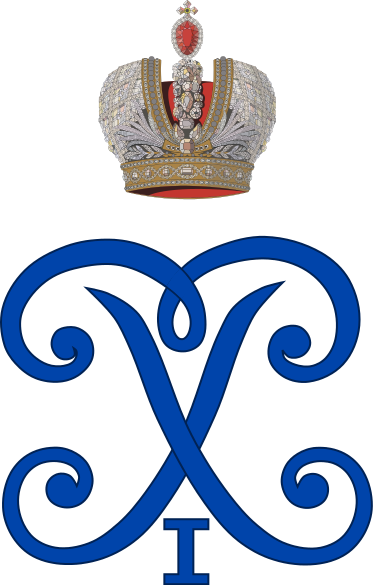
But in actual artefacts it looks even more double-P-like, as they write:
Монограмма состоит из перекрещенных латинской «Р» зеркально отображённых
Unless that hat is шапка-невидимка, hiding the middle head.
but there's also other opinion, which looks kinda wrong:
Монограмма Петра I. Переплетение расположенных под углом в 90 градусов четырёх букв «П» (Пётр) с добавлением четырёх римских цифр «I» (Первый). Имеется на петровских рублях 1722-1725 годов.
but that's not wrong, it's just speaking of another one:
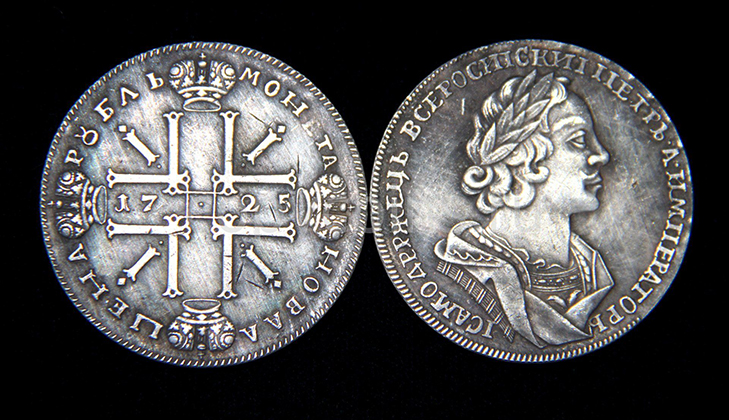
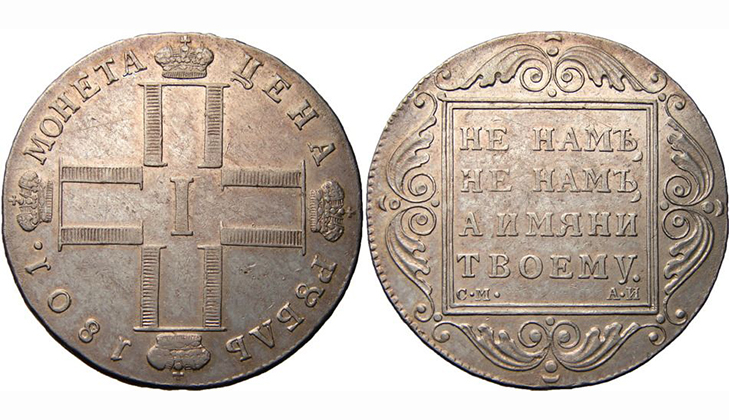
And this monogram thing is a great field, because if somebody knew something secret about letters, these guys could. Those who knew could be tempted to buy monarchs with that knowledge. So let's collect some of them:

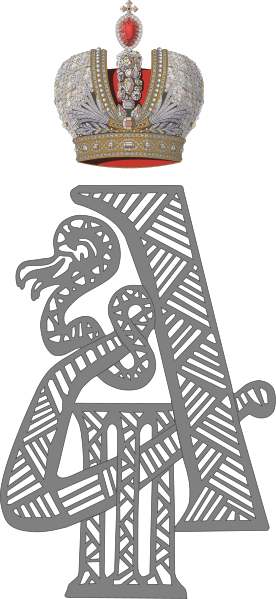

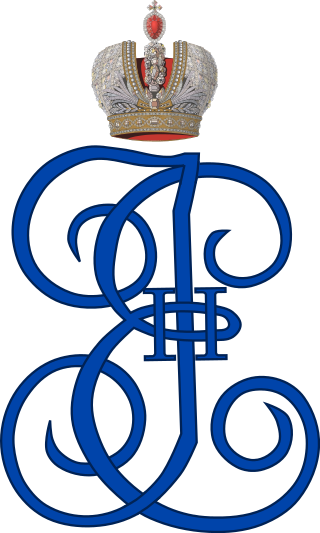


But then though this is an interesting subject, it didn't lead nowhere in particular, so I moved to something else. But I cannot leave this subject without diving real deep:
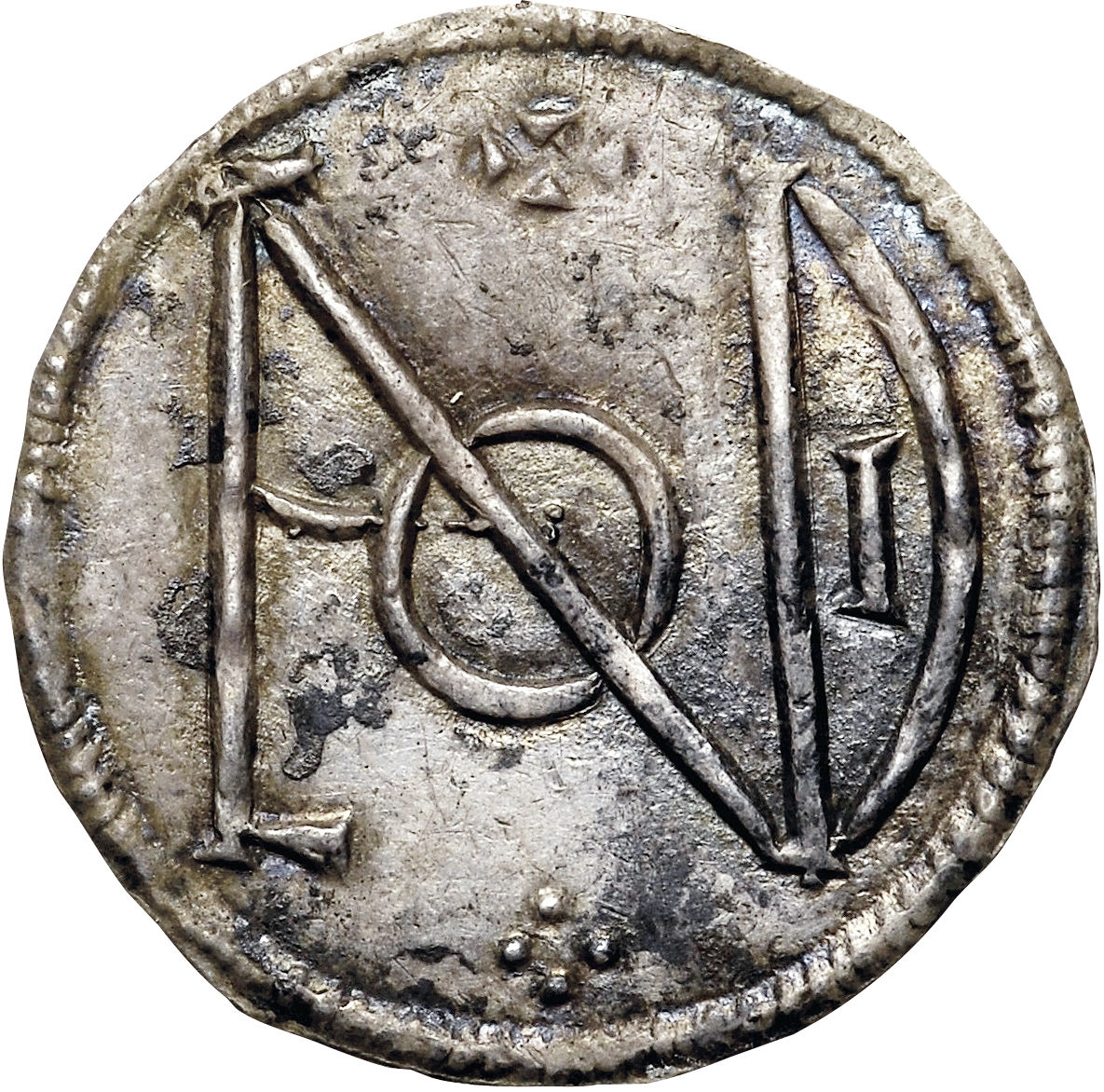
LONDONIA monogram, cross of wedges above, cross of pellets below.
But it's circa 800 AD, we have to go 800 BC if we really want to touch the times of origins of the writing system, but maybe even that is not enough and we have to look at ugaritic coins or something.
But then coins didn't seem to exist then:
True coinage began soon after 650 bc. The 6th-century Greek poet Xenophanes, quoted by the historian Herodotus, ascribed its invention to the Lydians, “the first to strike and use coins of gold and silver.” King Croesus of Lydia (reigned c. 560–546 bc) produced a bimetallic system of pure gold and pure silver coins, but the foundation deposit of the Artemisium (temple to Artemis) at Ephesus shows that electrum coins were in production before Croesus, possibly under King Gyges. Croesus’ earliest coins were of electrum, which the Greeks called “white gold.” They were stamped on one side with the facing heads of a lion and a bull; this type was later transferred to his bimetallic series of pure gold and pure silver. (Some recent scholarship, however, suggests that this latter series was struck, in fact, under Croesus’ Persian successors.)
and suddenly.. is it what ? stands for?

Подобно тому, как государство сокращается до г-о (говно) так и пидарас сокращается до п-с (пёс)
господин сокращаестя до г-н (гондон) но в склонении г-на скорее напоминает говна.
Коммунисты (несмотря на то, что сокращаются до к-ты (типа коты)) как наибольшие сторонники го-а настолько копрофиличны, что даже назвались кпрф.
I recognized why rotation with right hand should be clockwise: thus the hand goes по шерсти. along the fur? wool? in the direction their hair grows. (гладить против шерсти: rub the wrong way, stroke (hair) the wrong way, comb hair the wrong way.
series are serious. The writers of future history (those who write the events, change governments or react to the change of political landcape.
What I do is Beyond Etymology. Paraetymology, but para- thing has some faul off-putting connotation: parapsychology is kinda icky, but paralinguistics seem to be alright:
Paralinguistics is the part of communication outside of the words themselves – the volume, speed, intonation of a voice along with gestures and other non-verbal cues. Whenever there is confusion or stereotyping in cross-cultural communication, paralinguistics is most often responsible.
and then there is this:
Paralanguage, also known as vocalics, is a component of meta-communication that may modify meaning, give nuanced meaning, or convey emotion, by using techniques such as prosody, pitch, volume, intonation, etc. It is sometimes defined as relating to nonphonemic properties only. Paralanguage may be expressed consciously or unconsciously.
Чей бы бычок ни скакал, а телёночек наш будет.
The bull cult could appear when people began to realize the correlation between bulls and calves.
And sacrifices could be aphrozodiac aphrodisiac, aphro- could be amouro and thous Aphrodite could stand for любодеяние (занятие любовью)
богат быкаст (не колет бычков, а содержит их с тем чтоб коровки телились лучше)
ではごきげんよう
では ごきげん よう
Dewa gokigen'yō
では dewa ~ then (well, then)
L anguage is three-dementional di-managable characteristics. curve and lentgth, for example.
Words don't repeat even its cognates in other languages, by and по could be directly related to the same protoform, but they have different areas of use in their languages, and the closer those nations are, the closer their areas to eachother.
(this claim is purely theoretic, no actual data other than previously absorbed was used in calculating it)
Какое грубое слово связь.
пока пока пока (как тройной поцелуй) poesen is the closest word I know, there are most probably more.
убить убыть
A похоже на символ масонов the all-seeing eye.
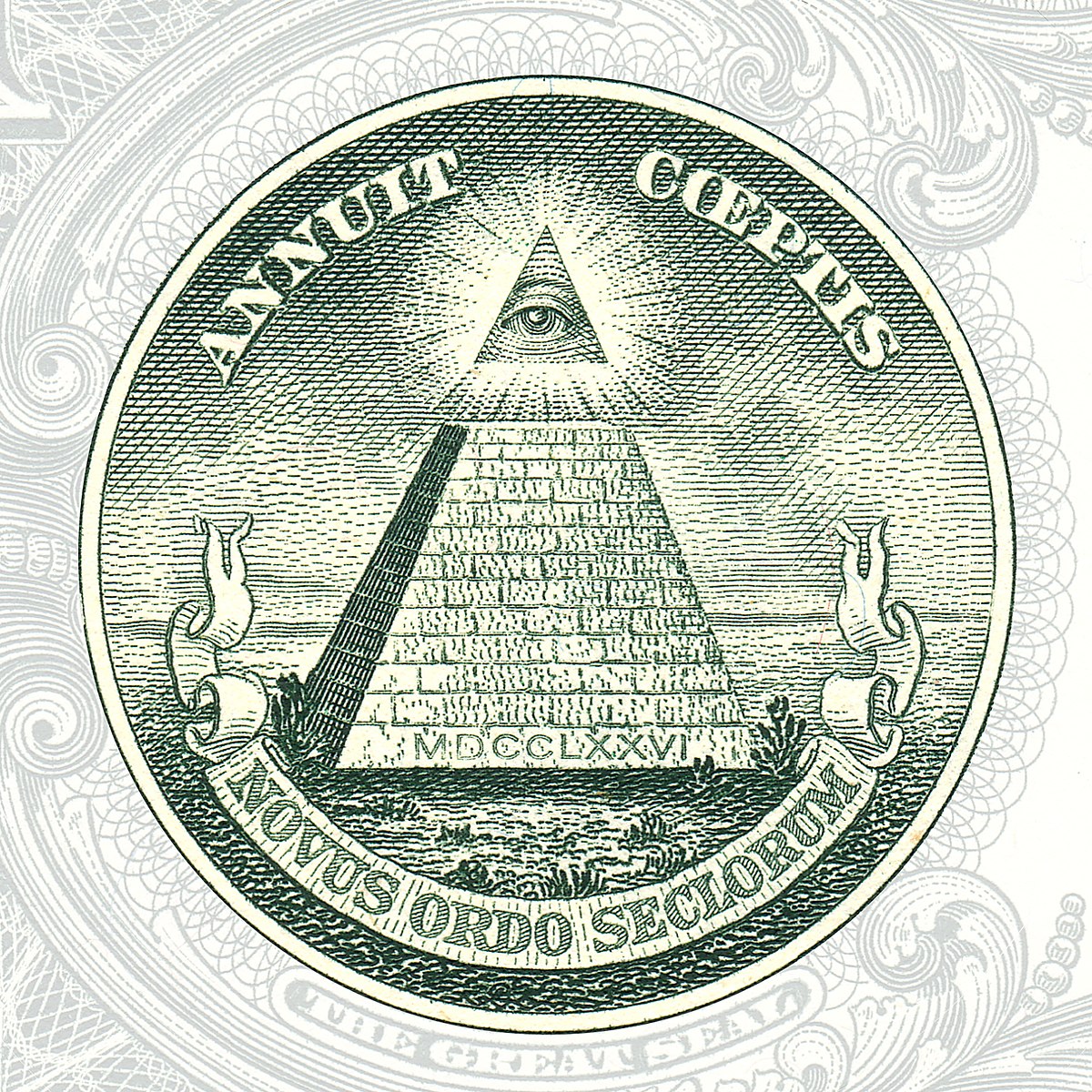

и следующий их символ. B J губные и язычные.
Kinesics is the interpretation of body motion communication such as facial expressions and gestures, nonverbal behavior related to movement of any part of the body or the body as a whole. The equivalent popular culture term is body language, a term Ray Birdwhistell, considered the founder of this area of study,[1] neither used nor liked (on the grounds that what can be conveyed with the body does not meet the linguist's definition of language).
But what is the linguist's definition of language and what am I if my definition of it is система передачи информации (but then internet cable is a language) so what is the linguist's definition of language?
Many definitions of language have been proposed. Henry Sweet, an English phonetician and language scholar, stated: “Language is the expression of ideas by means of speech-sounds combined into words. Words are combined into sentences, this combination answering to that of ideas into thoughts.” The American linguists Bernard Bloch and George L. Trager formulated the following definition: “A language is a system of arbitrary vocal symbols by means of which a social group cooperates.”
Aristotle
Speech is the representation of the experience of the mind. According to Aristotle, language is a speech sound produced by human beings to express their ideas, emotions, thoughts, desires, and feelings.
this definition excludes not only non-humans from the definition, but also all other forms of language except vocal.
Saussure
Language is an arbitrary system of signs constituted of the signifier and signified. In other words, language is first a system based on no logic or reason, and Secondly, the system covers both objects and expressions used for objects.
Thirdly objects and expressions are arbitrarily linked. And finally, expressions include sounds and graphemes used by humans for generating speech and writing, respectively, for communication.
this one includes writing, but not sign language, for example, and then there are also computer languages, when the recipient is not a human, and because computers can speak now, we should include their case into the definition.
\Sapir
According to Sapir, language is a purely human and non-instinctive method of communicating ideas, emotions, and desires through a system of voluntarily produced sounds.
The definition of Sapir expresses that language is mainly concerned with only human beings and constitutes a system of sounds produced by them for communication.
all that homo homocentrism and vocalism.
Bloomfield
The totality of the utterances that can be made in a speech community is the language of that speech community.
Bloomfield’s definition of language focuses on the utterances produced by all the community’s people and hence overlooks writing. Besides, he stresses form, not meaning, as the basis of language.
this is the most crappy definition so far, not only because it excludes everything but vocal speech, but also because it includes all the non-language utterances. but then it seems I have my own definition of language. So let's finish with the predecessors and I do my best.
Bloch and Trager
According to Bloch and Trager, a language is a system of arbitrary vocal sounds through a social group that cooperates.
Their definition of language points out that language is an arbitrary system, vocal sounds, way of communication, and collectivity.
vocal, aha, but this time not only human, which is good.
Noam Chomsky
Noam Chomsky says the language is the inherent capability of native speakers to understand and form grammatical sentences. A language is a set of (finite or infinite) sentences, each finite length constructed out of a limited set of elements.
This definition of language considers sentences as the basis of a language. Sentences may be limited or unlimited and are made up of only minor components.
inherent, native speakers, sentences, minor components, this one is even more retarded than the Bloomfield's.
Derbyshire
Derbyshire says the language is undoubtedly a kind of communication among human beings. It consists primarily of vocal sounds, articulatory, systematic, symbolic, and arbitrary.
This definition of Derbyshire clearly utters, language is the best source of communication, and it also portrays how human language is formed and the fundamental principles of language.
human, primary of vocal sounds, what a shit definition, is my definition even aligned to the world's
Lyons
According to Lyons, languages are the principal communication systems used by particular groups of human beings within the specific society of which they are members.
Especially Lyons points out that language is the best communicative system of human beings by particular social groups.
This one is the most impressive of them all. Very good definition, even though it excludes computer languages, but it seems to include all the human forms of them.
Wardhaugh
A language is a system of arbitrary vocal sounds used for human communication. This definition of language by Wardhaugh mainly insists on arbitrariness, vocal sounds, humans, and communication.
what they said, vocal sounds, humans
Patanjali
Indian linguist Patanjali utters that language is a human expression produced by different speech organs of human beings.
Through speech organs, humans produce several expressions converted to language.
utters.. very vague, and also kind of circular.
Encyclopedia Britannica
According to the definition of Encyclopedia Britannica, language is a system of conventional or written symbols through which human beings, as members of social groups and participants in their culture, communicate.
In other words, it says language is a system of communication through which human beings express themselves.
Thus, we can say that language is a system of communication or arbitrary vocal sounds through which human beings communicate and interact with each other in their everyday lives.
There are approximately 6,500 spoken languages available in the entire world used by different social groups and cultures.
Heaven and hell are the one and the all?
Любопытно, что имена норн подобны алфавитному порядку ABC: Урд Верданди Скульд, именно в таком порядки символизирующие прошлое, настоящее и будущее. И здесь следует предположение, что арабские богини аль-Узза, Маннат и аль-Лат представляют собой ту же самую концепцию. Но это предположение разбивается о то, что Маннат олицетворяла возмездие и считалась богиней загробного мира, и, быть может, это различие лежит в основе того, что восточные фонетические письменности, в отличие от европейских, группируют губные буквы после язычных, грубо говоря не ABC, но ACB.
Но затем я вижу, что ал-Лат тоже ассоциируется с загробным миром (и, возможно, с солнцем)
это очень мутная тема, на самом деле просто сырая тема, я её не исследовал. И в итоге я решил исключить арабскую часть как наказание муслимам за агрессивность. Они хотят чтоб их боялись, пусть считают что я обоссался и замолк, доброго лова страхом не заслужить, лишь лживое, но не от меня.
я антисемит? семит для русского уха сатанит, сэм шем шайтан, samael.
One of Samael's greatest roles in Jewish lore is that of the main angel of death and the head of satans.
но я не антисемит. я должен соблюдать нейтралитет в этой битве: если я защищаю русских от уничтожения, то я должен так же защищать от уничтожения и евреев, потому что подобно русским они имеют как недостатки так и достоинства. И может от какой-то из наших побочек у них есть естественный иммунитет, который мы можем позаимствовать для собственного исцеления, а если они смогут изцелиться от того чем они болеют заменив те гонимые гены нашими более кошерными как ни парадоксально и им по любому "не бомбит" то основная часть бол проблем связанных с семитизмом отпадёт, а остальнача часть останется дабы "карась не дремал" (но если карась хочет дремать и щуки его бесят суки, дай суки, дай дай! язык ещё один источник разногласий.
Язык буквально я звонок. я хорош. маленький язь, яз ест, еда яза что-то где-то рядом здесь, сейчас разберёмся. язык и лэнгуадж are not cognates and have different meanings. Words have their initial meaning and have to be used as such, the misuse of words is a corruption of language, deterioration, reduction of it.
language is of lingua it is longing, licking, язык лизык? язать? яжу? искали вкусное языком? не, врядли,
язык аз
молот молоток молоточек
яз язык язычок
яз я зык? я звOнок? я звонОк? Я R-ing? Ling in lingua as this ring? зык? з? (з язычная буква, как Δ одна из первых и основных язычных, язычная звонкая)
язык
якорь
яблоко
я
и стих
и.. прикол, причал
apple子
I
стих тихо а поэма пьяно? Hh Нн?
but then these two are far from being cognates, so why guess this when I can find some better pairs?
𓃀 𓂧 as B and D, foot nad hand, make me believe f and h are rudimentary pictograms of n in h standing for body, and the stick is the arm, and the upper part of f being y-like in 𐤅 standing for body too. and the stick below it is a leg. but is l that leg? is L~F? it's absurd. it lead me nowhere, drop it at once.
ещё одно священное слово в одном диалекте сохранившееся в сокращённом виде:
тилака = тика (ти-ка)
Jews are an european nation,
Let's go Brandon, should I tell to Lowrow, let's call out jews, but give such an interpretation, that they themselves will aplplaude us.
Let him call out the jews around punit, putitdown, who want to exterminate some russian, urkainians, uralians, ur, we're all ur. governmental structures of a destroyed empire, probably building china after it was expelled and then mongolia, and then the Horde. But that is so raw, can I really build up theory just on the basis of some phonetic similarities, not very good of a basis, eh
Jews should be recognized as eternal scapegoat. Russia should solve jewish question by proclaiming the world of ever-growing transparency.
Make a list of what different nations are responsible for. So jews are tricksters and here's incomplete list of their tricks (first two wars to get Israel, current "military operation" to build khazar kaganate.
russians are slobos, and often alcoholics, alcoholic is even more of a stereotype, me being slobo is
ю я
юс большой и юс малый. В словаре Даля юс означает нос. юс означает носовую гласную. ю и я происходят от носовых гласных. и может это объясняет положение j в столбце губных, ибо м сегодня воспринимается как назальная.
я как ребёнок себя осознающий
ю как взрослый другому указующий
яю = AV (аз, вы)
a~d, u~v?
a~d, e~c, i~l, o~G, u~v?
e~i, Г~L?
o~u, g~ŋ~n~ν~v?
u~u o~u are both labial and recognized as nasal by common public (but labialized by specialists)
o~ŋ~u?
Dabliú (W)
is devil double? doppelgänger or something?
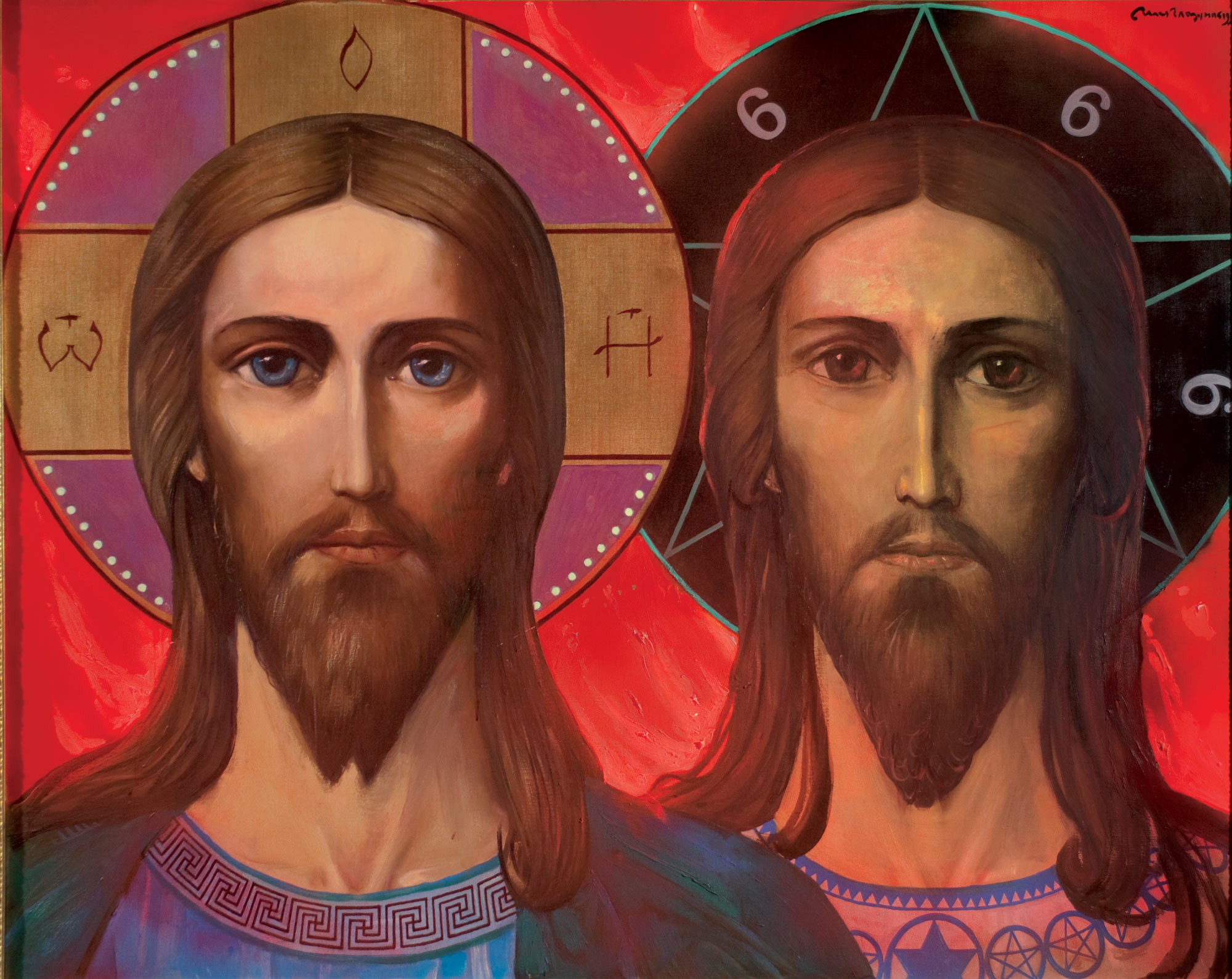
Дохристианская система была 6 6 6: 6 on dice
aet eight
семья семь
7 семь семья
8 eight aet
too wishes I wished are absolutnoe znanie AZ (аз (альфа) ~ abc? азы)
god as inner voice, I don't hear when I type it, so I should stop!
It would be a sick end, but I have to go on:
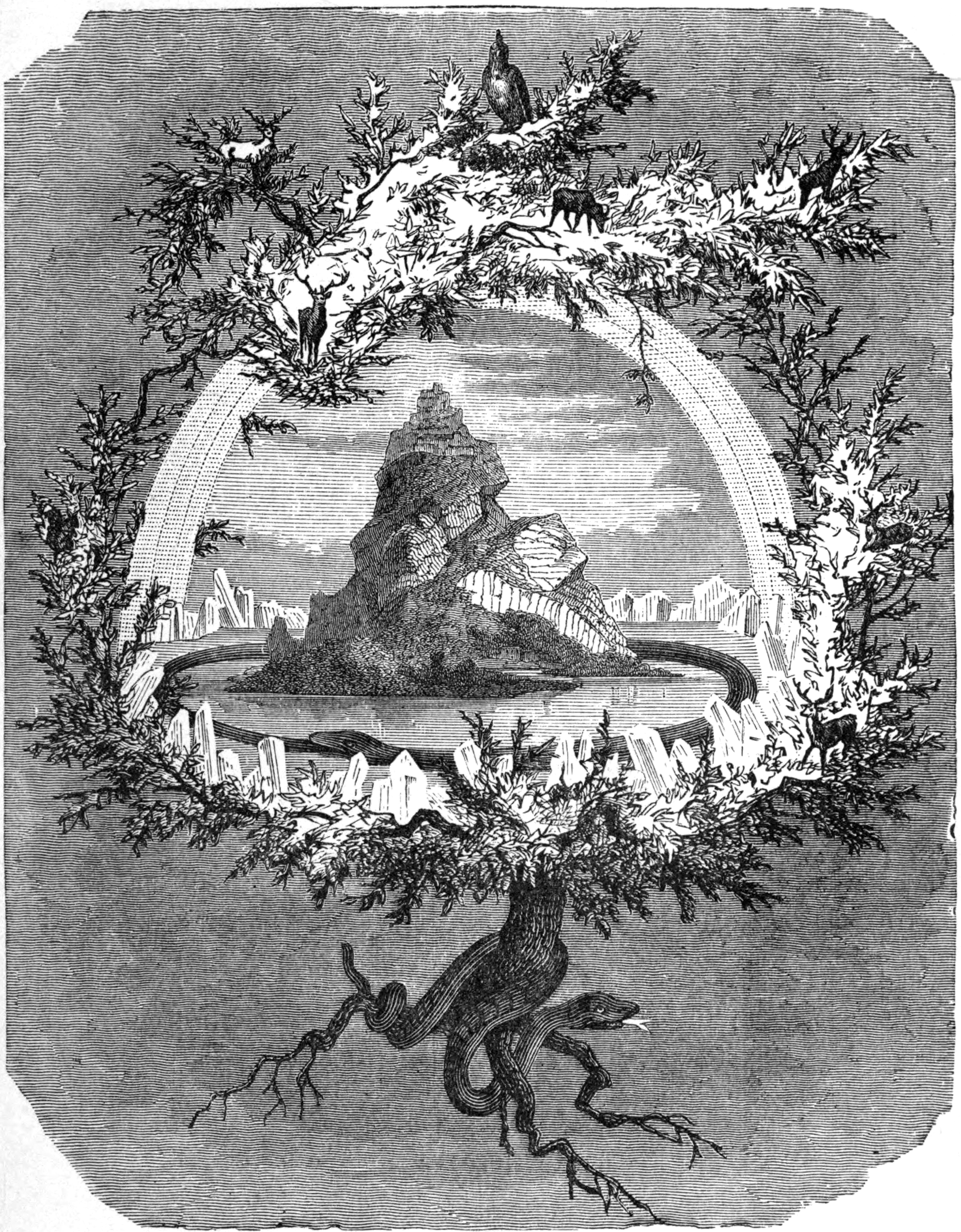
is that ygg in Yggdrasil egg? then drasil is obviously tree of power (сил is of power in russian, but the way they translated physical terms is kinda fucked up somehow, I saw it in the physics classes, I cannot put my hand on it now, it's tabooed in my mind) But then nah, here's the academic opinion and it's probably much less wrong than my babble
Дословно «Иггдрасиль» означает «скакун Игга» (Игг — один из эпитетов Одина), имя Мирового Дерева представляет собой типичный для эддической поэзии кеннинг. Существует мнение[источник не указан 2600 дней], что имя указывает на эпизод добычи рун Одином, когда он провисел, пригвождённый к Мировому Дереву, девять суток (аналогичный кеннинг для виселицы — «скакун висельника» - германцы считали, что эта метафора описывает виселицу как коня, на котором скачет осуждённый на казнь [1]).
and about that image and what's on the top of the tree:
Víðópnir is a mythological bird. According to Fjölsvinnsmál, Víðópnir or Víðófnir is a rooster that inhabits the crown of the world tree, variously represented as a falcon, sitting between the eyes of the cosmic eagle Hræsvelgr at the top of Mímameiðr, a tree taken to be identical with the World Tree Yggdrasil. Viðópnir occurs in merely one other norse medieval source, a tiny phrase in Snorri Sturluson's Eddu-brot, where it guards the gate to the lands where in Hél's Hell lies, Gjalllandi[1]. Viðópnir seems rather identical to Veðrfölnir and the eagle
It's a pretty accurate image, because the treee has three roots. is tree = three = ᚦ? tor, topor.
ᚦᚮᚱ? ᛏᚮᚱ? I think I found the system: three roots stand for three letters per a word. hence one-syllable words chinese had. Whoever fixated language in three runes (I saw it in the
vowels were there to fill in spaces, topor would be tpr, as jews write, they teach that jewish words are of three root letter (or something like that, my field is so broad that I may lack some details, so that Игдрасиль above is Иггдрасиль, энд I already wrot about that.
русизм это лингвистический термин (посмотри на него с точки зрения укарины)
украина укрыма крым был греческой и римской провинцией, крым краина
расизм россиизм, рашин рэйшист рейх рейн reign rein (rain? Рейн could be rain, reiver,
reign make that краина Райх райский? всякая власть от бога? они в раю а скот в аду? были эти понятия земными до изобретения небес и сатаны? добро и зло всегда существовало, понятия абстрактные, но при этом полностью разумные, общее название желательных и нежелательных нагрузок на организм. have that k as a prefix too, thus my guess that ukraine is uk reign could be correct.
русские расисты, красисты (раска краска окраска) край красит, из татарской деревни значит татарин, чуть другие цвета у одежды, чуть другие фасоны, разрезы, волосы
русские не алкоголики, расисты. названия наций выдают истинные черты? но интернационализм русские приветствовали горячо, они понятия не имели что евреи не русские, остальные народы вокруг них тоже затаились, видимо русские были тоже обособлены, и обособленно зашли в тайгу, и таёжным (тамошним) жителям приходилось приспосабливаться к новым хозяевам жизни. учить их язык, забывать свой, и это удивительно, что они не вставляли свои элементы в русский язык. Или быть может и вставляли, субстрат и суперстрат неизбежно влияют друг на друга, может оттого мы русские своего языка не понимаем настолько насколько каббалисты или русские неоязычники разбирают их. Хотя русское неоязычество я считаю нелепой реконструкцией, но лепо или нелепо это дело субъективное, кто-то так от этой темы прётся, что
два is dv, du, dua, duo, di-, di is две, du, ΔV (d огонь, день? v voda)
день огонь? де ого? d un-g? do un-go?
🜂🜄
AV (a~d again)
Agni, Agon, Agni is plural? Agni is fires in russian.
историческая наука касательно минускла (на поверхности эксперты говорят, что он был изобретён лишь в средние века, но то ли речь о греческом минускле, то ли о совместном использовании минускла и маюскла, разделяя заглавные буквы от строчных, они дезинформируют, потому что под названием римский курсив идут знакомые нам минускульные формы латинского алфавита, а я на примере латинского алфавита иллюстрирую большую часть этой теории)

only b here still looks at the beginning of the line, as 𓃀 did. d is probably hand, as 𓂧 is.
Notice how second form of G reminds S, for both are of c, but the c is c.
But then in roman cursive only p somehow has the ☽︎-like curve, is it why it's called cursive? like of curse? being wrong? it could be some competing tradition of some subjugated people of the territories, an example of those who dared to oppose the superstratus.
I'm not even sure they made this transliteration write, but if they did, notice how e reminds l (in modern cursive they also may look the same way similar (l maybe being a little larger, but then not necessarily, people may write in different fonts, separated l and e may look the same.
R looks like p again, and yet like A~Я~R (R's name is A)
RST ABC? nah
RTV ABC? nahh
RSV ABC? I keep on гадать, but it's all no good.
ABC оно же AБТ оно же ABD oно же AMS основа не только алфавита, но и языка, и я это продемонстрирую: тремя буквами можно передать не так уж много слов: бТ батя, но он же и мать (потому что б и м суть проявления одной и той же протобуквы) butter is btt bt=beat, -t = -ed, батя значит бьёт? омонимы, и семантически не такие далёкие слова. бтт также бояться, т~с.
мать мнёт, не бьёт, моет, но разве это не делает её другой буквой? Допустим, речь в палатализации, т.е. А это мужская гласная, а I это женский вариант, преврачающий АБЧ оf ABC into EVS (a is pronounced as e in english, в is pronounced as v in russian, c is pronounced as s in russian too) or IMS? (I и a обе используются для 1, M of мать opposes Б of бать, S is how С is read in russian, and in english too, and B is read as V also in greek, in some dialects of it at least)
I keep on discovering new important writing systems, behold khazarian runes:
(they are also named rovas, and it definitely somehow relates to ν being n in greek)
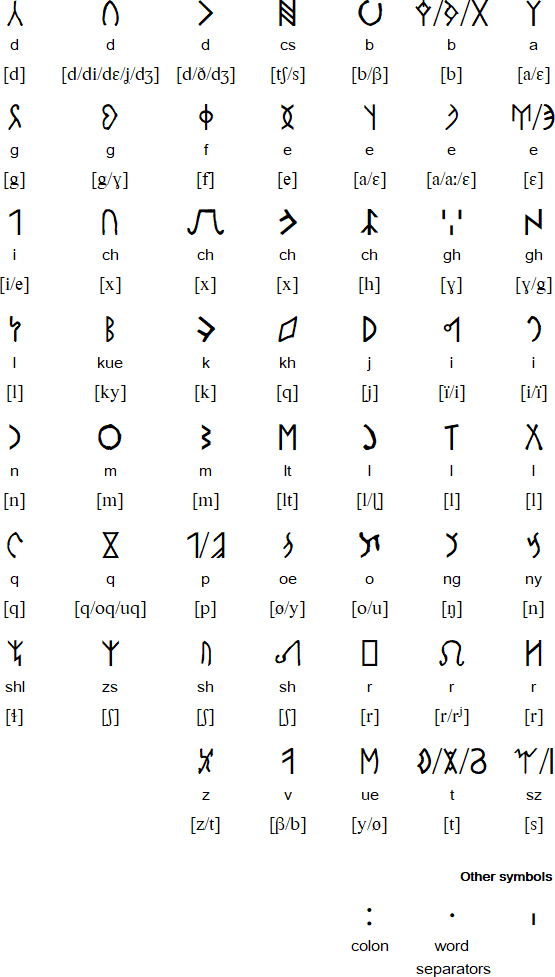
Let's arrange them our way:
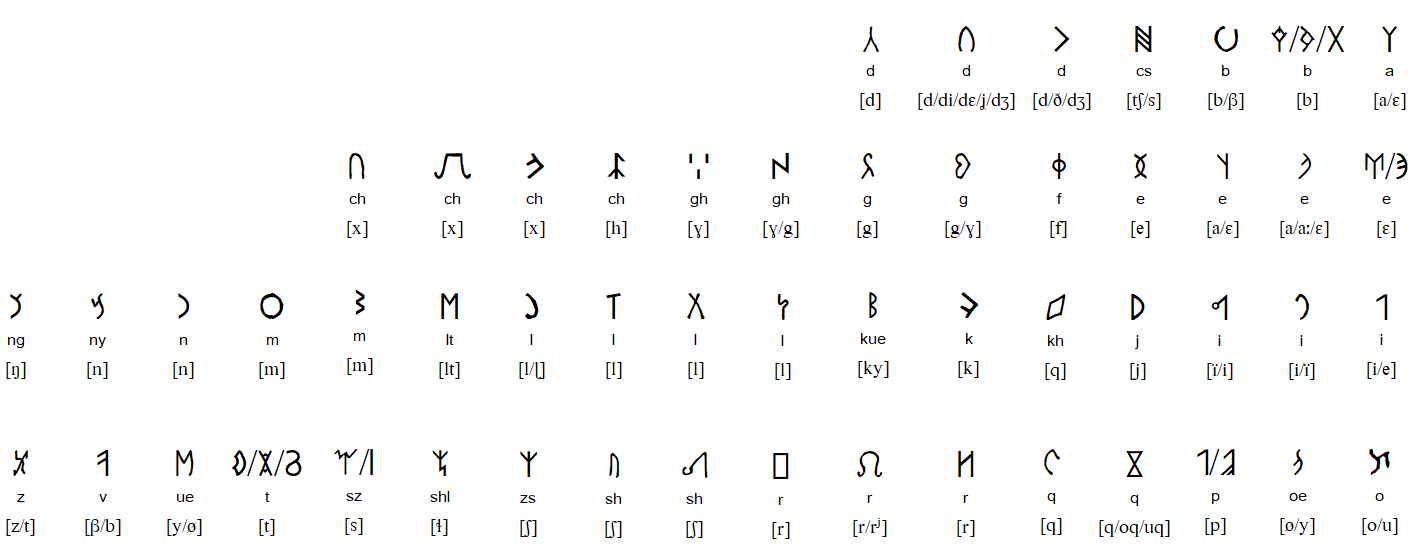
7 13 17 17, 54 runes (not to count different shapes, which which it's 61, but then these numbers mean nothing to me, especially the last one, who knows how many shapes there are, who knows if the source is complete or accurate)
And for the first time (or about so) do I see the greek cursive:

and to my surprise it's T is exactly russian Г (and their Г looks something else)
but these П Т are like naturally the thing I was speaking of earlier, the double labial and single lingual.
and also that is related to both G and T being of C for there used to be only ABC and that's it. So once we reduce all the letters to these three, we have the protolanguage, I suppose, like батя бьёт, мать моет, this kind of thing.
But some of these letters are really weird, like what is the minuscule π, guh!
and their minuscule Β, I thought it was supposed to be β.
Let's look at some other pictures:
One fool can ask as many questions as all wizard's won't be able to answer. But then wizards should adore answering weird questions, complex questions, unthought of questions. So I will deliver them together with
I will я велю
I shall мне следует
мне = я, чисто стилистическая вариация я или мы, I or me, but then me and we are not too far both semantically and phonetically.
я грязь и мразь во многих смыслах, а потому я позволю себя сказть что коллин firth is such a dirty name, colon is dirty, but first I noticed firth reminding dirt and filth at the same time. First I saw dirt, and then I noticed filth. in japanese it is the same word. What did he play? editor of the genius, a great movie, and the editor is filth, gate keeper, so the name worked well, another great movie booed by (((critics))) journal workers, university clerks, I am hostile towards them and more and more so, so soon I stopped interacting with them, just sometimes sending in via electronic mail in vain, I have to make it on paper, I will break through for sure, 'cause I'm true. I hope I stay alive doing so.
Duality must have doubled inside, so 2 elements became 3. Am i Ma could sound differently, and because I know ata, father, отец, батя
ad as adam.
Ad adn Ma (adn is and, a type of type of typo I didn't feel like fixing, but then I see that fixing is repairing, and here it's another sort of repairing: cleaning, and that was definitely a bad use of language, and because I saw it I learnt and will say I didn't feel like cleaning out, yeah)
and = ND = MD = Water?

m = in as with from, very matrimonial maternal
both n and r are lingual and speak of the outside: to, for, at (for is probably like father, and suddenly at as atets)
in is between m and n, and by is within the road but at it, not directly inside of it in russian mind, on the surface, russians say on the road, на дороге.
some хна is with, m is more common shape than this particular h type of na. n is снаружи but to the inside maybe? n is for, that is its difference from R: R has no trace of labiality (n sounds exactly like m, it only is different for those who read the lips. небольшое отличие всё же есть в речи, камчатку от канчатки вроде отличаю, но в разговоре другой человек слышит, и кто знает что он слышин.
Пример: condom is gandon in russia, -m ~ -n.
mi "like" is definitely of m, m'j (как в русском и японском прилагательные создаются суффиксом ий)
hr "on, upon" is probably cognate of higher
ḥꜣ "behind, around" is probably cognate of hind, behind.
ḥr "on, upon", ẖr "under" some opposite forms of h those are, I wish I could read it.
tp "atop", this one is easy, it'd e it's definitely a cognate of top, atop.
dr "since" (this one I don't know what to compare to other than during, through?)
But then how can I even trust these sources?

so "to, for" or "of, by"?
And then that N35 sounding as n shouldn't misguide you, because they obviously didn't know every reading, so they indexed it as they wanted, here G1 reading as A or whatever eagle screams:

Bird language is vowels, and if there are three birds and used to be three vowels, 𓅓 is definitely U. V as its head is. 𓄿𓅱𓅓 are AIU, because that small bird does speak i a lot. and 𓄿 is A and I agree with me, unlike those yogh'urts.
But then there's some n cognatic to our no and un-
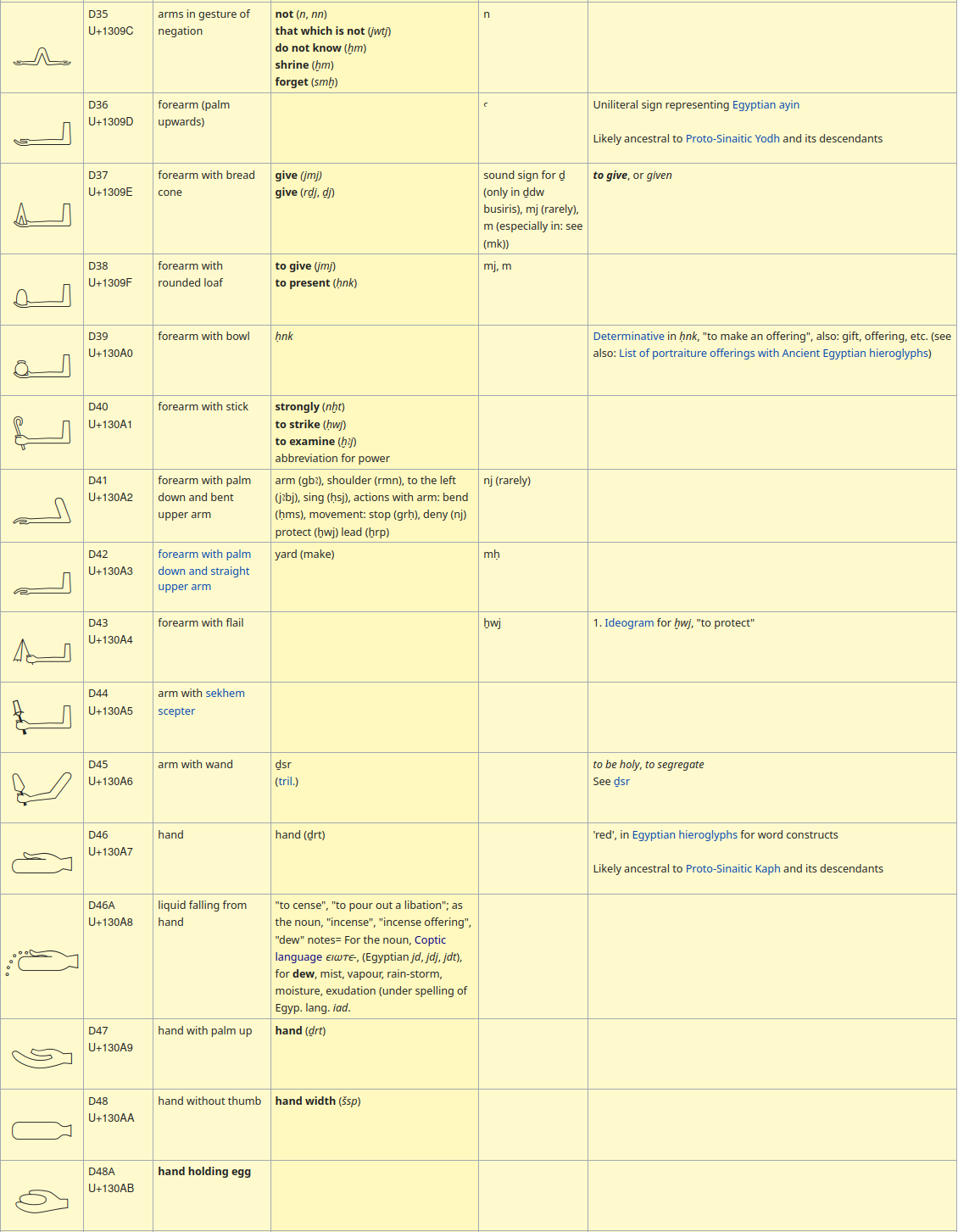
Notice how the third sign is some d, which is what I was always told of 𓂧, which here is drt and isn't recognized as phonetic sign at all, it is weird.
I like that ḏj for даждь, дать, дашь and mḥ for make, and there are definitely more, indoeuropean or not, this thing is next to our cloud, just like ב is в.
There are two types of myths: referring to what people couldn't know and referring to something they could know. Thus ancient history is more of a science (or rather more true) than ancient natural philosophy.
And definitely appearance of writing systems is something people naturally could know.
how very interesting:
Стриннгольм указывал на то, что Ётунхейм лежит на север от Двины до Ледовитого океана и к востоку от Ботнического залива до Уральских гор[2]. Впоследствии после установления более тесных отношений между скандинавами и жителями Руси, Волжской Булгарии и Биармии Ётунхейм был перенесён в сказаниях за Уральские горы.
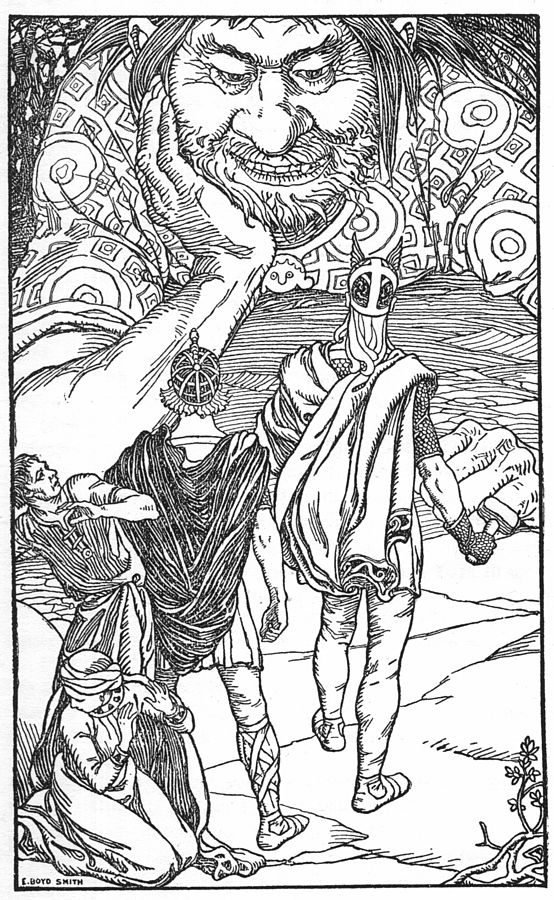
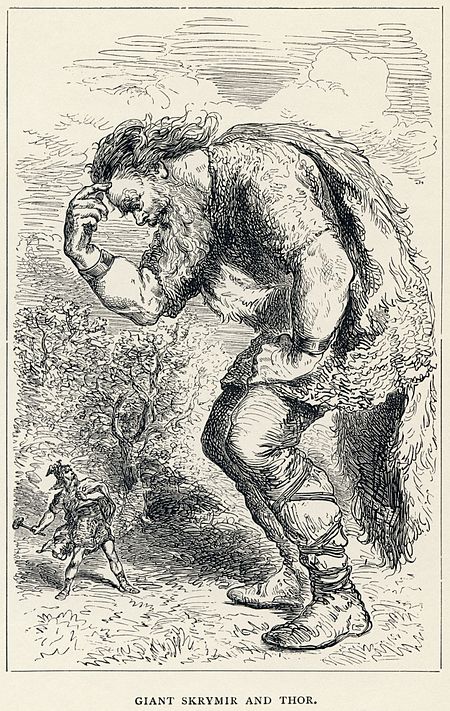
but fuck geopolitics, look something much more fascinating:
Идунн (Iðunn, также Iduna) — в германо-скандинавской мифологии богиня вечной юности, дочь карлика Ивальди, супруга Браги, бога поэзии и красноречия[2].
«Идунн» (Бернард Эванс Уорд, 1905)
Идунн («обновляющая»), в скандинавской мифологии богиня-хранительница чудесных молодильных яблок. Волшебную яблоню лелеяли и охраняли три мудрые норны. Только богине весны Идунн позволяли они собирать чудесные плоды. Из своего неистощимого ларца Идунн раздавала золотые яблоки, благодаря которым боги сохраняли вечную молодость.
So apple tree was that tree of life? Yggdrasil was not about eggs but about apples? But others say it was ash, but Varg tells it was oak.
были те великаны деревьями? Гиганты в сравнении с людьми, других не знаю, динозавры были много раньше. Деревья были здесь до людей, и ничуть не чудно предположить, что они были первыми, ведь дерево в центре их вселенной. Но это дикая идея, норманисты скорей всего га разобьют её в край в крах в прах. в пух и прах.
An Irminsul (Old Saxon 'great pillar') was a sacred, pillar-like object attested as playing an important role in the Germanic paganism of the Saxons. Medieval sources describe how an Irminsul was destroyed by Charlemagne during the Saxon Wars. A church was erected on its place in 783 and blessed by Pope Leo III. Sacred trees and sacred groves were widely venerated by the Germanic peoples (including Donar's Oak), and the oldest chronicle describing an Irminsul refers to it as a tree trunk erected in the open air.[1]
Donar's Oak (also Thor's Oak or, via interpretatio romana, Jove's Oak) was a sacred tree of the Germanic pagans located in an unclear location around what is now the region of Hesse, Germany. According to the 8th century Vita Bonifatii auctore Willibaldi, the Anglo-Saxon missionary Saint Boniface and his retinue cut down the tree earlier in the same century. Wood from the oak was then reportedly used to build a church at the site dedicated to Saint Peter. Sacred trees and sacred groves were widely venerated by the Germanic peoples.
б (Ბ, reminds russian cursive form)
g (Დ) once again georgian form reminds russian form but yet both shapes can be seen as the reflections of the other nation's forms. and look how the root, the branch, the swash thing matters, even in Დ it goes down, this is the obvious difference bte between Ბ and Დ, even though I don't see them as obvious as b d. Notice that b d and б g are reflected differently.
g is truly some god's letter. It's not clear which way the upper ball goes, you can write it both ways, but if it's preceded with some letter, I think it's counterclockwise and anyway, you still can write it clockwise, let's try it and see what we feel or experience, so anyway, what matters is how it ends, and it ends inevitably clockwise. Even though G shape of it loos as if it is a ⤿ arrow
⤾ arrow is probably J like in jah.
so г or дж? god or jah? gd are of abgd, jah is of efjh (and if ef is probably eve, why ab is father in hebrew? is ad in adam stand for the first line? does ev in eve stands for the second line?)
a doesn't palatalize, before it stands firm consonant (even though not necessarily closed syllable, I should "forget" all the academic beliefs, I should research it from scratch)
e palatalizes, before it stands soft consonant. It seems natural that feminine forms were softer than male, the two shapes of one consonant some russian syllables seem to be recognized, but then truer forms of them are recognized in latin alphabet, where c and g are literally read differently depending on the vowels following them. j is also read y or dʒ which reminds g, and is y γ? that dʒ reading make g=j=y. and coursive g (g) reminds y a lot, they're the only two like this. is ц and щ like this too?
разделить раздереть разодрать разобрать драть брать, вот это меня выбешивало, драть и брать брать аккуратно (по женски) драть с дракой (по мужски)
вырывать воровать
вырывать выручать
рви бери? дери? реви~cry? I гуже устал. до новых встреч.
курица не птица. а петух птица? петух~птах, он и есть птица птах и птица когнаты (или дублеты, триплеы) с петухом.
рецепт пирога: тесто (меня кормят сдобным, но не думаю что это хорошо, тесто мне никогда не нравилось. наши матери кормят нас некошерным, женщины ведьмы по сути своей, стоят над котлом, кашеварят, заваривают кашу иногда? обычно они.. я не знаю о них ничего, я знаю лишь свои примеры, и они разные, и прекрасные тоже.
яблоки ломтиками уложены рядами вперехлёст
сверху заливается кремотестом консистенции между блинным и оладным тестами.
Сметана превращает тесто в кремотесто
Мука превращает крем в кремотесто
Сахар превращает сметану в крем
Пельмени со сметаной следующее блюло что смог вспомнить, где тесто с мысом сочетается.
макароны со сметаной уже не очень, а мясное всё очень хрошо со сметаной идёт. некошерное
A ~ ã ~ one
nasal vowel, юс, is A nose, the nasal triangle, with the upper lip, they vibrate together. And I don't know if it's terapeutic purification of nose or vibration destroying nose and ears also vibrating when we pronounce some deep nasalsound when we clase with the basck of tongue mouth cavity, but keep our mouth open.
bass, base, back. тылы талия waist waste worst was (ты ли, нет не ты, но это уже вообще, брек)
can you back it up? божете вы это обосновать?
брек was poetized "бред брейк" но имеет не заложенное мной туда значение of брак.
бракоразводный процесс. did this misinterpreted word cause word брак for marriage appear in russian language. сочетаться браком (срамом? трещиной?)
брать в жёны. брак от брать, так говорать.
рят рать суффикс множественного числа у глаголов? глагол и имя название слова в разных языках или принципиально различны. имя наименование, объекты и субъектры. глагол действие. информация об этих объектах: сломан slow man? man is made? like done but man? man is mom? the words are too close the to themselves.
Typo the instead of to is is it my subconsciousness telling me it's the same o words.? to thou, the thee.
сука от thou? ссс ссу была моя предыдущая корня. ссу ~ ты? ссу ~ стой? мочой могли очертить круг С это круг! по крайней мере вот здесь:
ⴰⴱⴲⴳⴴⴵⴶⴷⴸⴹⴺⴻⴼⴽⴾⴿⵀⵁⵂⵃⵄⵅⵆⵇⵈⵉⵊⵋⵌⵍⵎⵏⵐⵑⵒⵓⵔⵕⵖⵗⵘⵙⵚⵛⵜⵝⵞⵟⵠⵡⵢⵣⵤⵥⵦⵧ⵰ ⵿ ⵯ

see this ⵓ they recognized as u, but the structure of the alphabet makes it evident that it's our O pronounced differently in africa, lower on the map, lower pronounces,
those four circles of ⵔⵕⵙⵚ are Rah and Solis, ⵖ is ц~ч~џ
in hebrew it's o-line, but it also looks like У: ע and ע is also double, and then ש should be recognized as triple,
ⵓⵔⵕⵖⵗⵘⵙⵚⵛⵜⵝⵞⵟⵠ
purify is both make it purer and make it poorer (лингвистическая чистота ~ лингвистическая бедно(и даже не беднота а бедность, более какием? -ist'ым.
Thinking of the falcon or rooster seeting at the head of the great eagle on the top of yggdrasil, and combining this idea to three egyptian birds of 𓄿𓅱𓅓 but this could be a прихоть of egyptologists, but by size they are 𓄿𓅓𓅱 but though I can imagine the smal bird at the head of the big one, it's hard for me to imagine
Если можно найти вибрацию, которую можно отразить от луны и поймать обратно на земле, то можно развивая эту технологию и увеличивая и датчики и фурье-анализ-мощности, можно будет слышать что кричат на других планетах, отражённых или переданных в почти безвоздушном пространстве космоса напрямую, но откуда? какая планета была в той точке и как давно? если можешь услышать с такой дали (услышать/увидеть/детектировать) то рассчитать движение планет труда не должно составить, но на более точных рассчётах скорей всего столкнёмся с эффектом неопределённости (из-за не включения в модель мелких камней, до тех пор пока каждую элементарную частицу сможем включить в модель, но для этого понадобится мощность больше чем реальность, которая там моделируется, а учитывая что мир бесконечен, это ещё один неизбежный источник неопределённости, мы не можем учесть сигнал, улетевший в том направлении, а значит обладаем неполной информацией, неопределённость возникает на каждом уровне познания в том месте, где возникает бесконечность.
конец has нет in the middle of it? к нет? нет ~ end?
end~not? and ~ на до? enned? enneid? an'ed? edit издать
издаёт (последний, истошный, прошщальный) вздох
это поэзия, и когда я end it, you can tell it, but until that I can always say ..not
So whatever you say I said you didn't get the joke of.. ..not.
pental, octal, but decimal
пятиричная, восьмиричная, но десятиричная, но это ти часть слова десять. а я думал т(т) ~ m(m)
десять deca или decima? decima in italian is десятина in russian. ma~на?
Kazakhstan chose to switch to latin and currently transcending that reform. Ukraine will probably do the same, and then inevitable russians will. So let's prepare the reform variant with all I know I am the best candidate to do it. We start with alighning russian letters along the phonetic principle,
A Б Г Д (а бога даъ
Е В Ж З (евы жизы?)
И М К Л или И М Л Н (и молен? имя ленин? или и мокал?)
О П К Т perfectly reflects A Б Г Д and reflects Q and K is like R in both senses, and thus И М Л Н, also because R ~ L and the same letter in japanese, but then left and right are alike aside (many people still mistake one for the other) aloft? astray? right is lucky curve? I don't know, but it's not налево, лес лев leave leave(left, like literally left. did I recall what I "constructed" or is it really a revelation of the lucky coincidence?)
У Ф Х С exact but palatalized calque of О П К Т
And in this representation A M S are in the beginning, middle and end, but 20 is very little, especially in comparison to russian 33, and the centre is not exact, and because russians have 10 vowel leters, let's add the additional column of vowels so it makes M more to the centre.
Я А Б Г Д
Е Э В Ж З
И Ы М Н Л or И Ы М Р Л? nah, this one is too мырл
Ё О П К Т
Ю У Ф Х С (in russian it's уфхц, but ц is literally тс. no russian would distinguish where is which)
will this witches knowledge becoming common make people more sensible or more insane?
We should keep the metrics, and react righteously.
but I feel like there would be 5 mothers if it was that retarded way, аэыоу is ugly, but ukrainians reading и as ы would have more pretty aэиоу, especially because their э is є, or is є йе?
аєиоу.. nah, ukrainian is even more messy in other aspects, and let's make some latin script, fit for both us and them.
But first let's make that phonetic principle perfect, and for that we follow thae 3 of the mothers as the lead:
AMS
A
M
S
A B D
I M N
U F S
voiced are plosive, voiceless are fricative, and because voiced are voiceless at the end of the word, the palatalization matters more, and thus U F S reflects U V Z of U VWXYZ
The middle line is of sonors, who are always voiced, and it raises some questions. Why are sonor never have voiceless counterparts? Because they are nasal, and nose exhales almost soundlessly, silently.
and if the middle line is nose, first line is the voice? but then the second line is also voiced, so is it mouth? But I just thought they were voice, nose, mouth, and I wondered why would voice be at the top. And now, when I see that it's nose and mouth, I recognize the duality and
bd
pq
become
mŋ
p q
horizontal lines are nose and mouth
vertical columns are lips and tongue
opening is different from the lips thing? it seems so.
I and A were 1 and 4 ? they look like it .
mama nose? (mama knows. noes?)
papa mouth (papa said, papa says yes?)
If papa say yes, you can do it, mama doesn't count, because daddy is the boss, he's bossy, because men are stronger physically, it could matter much more in the past, it still matters, but women often spoil kids in spite of what the fathers tell. it could be less of a case in the past, when beating your women could be an option less frowned upon.
If mother says no, there's no way around it, only to openly disobey (I used the trick of asking mother what I wanted after father said no. Because she told me to ask my dad, and when father said no, I would lie and tell that he told yes, and then they had a conflict, but as a result my mother makes business and father watches tv, mother wouldn't go forward if I didn't make it happen, because I recognized her being from a higher family than my dead, who's a soviet scum made a head of the department, but he didn't have ambitions to go higher, after the soviet union collapsed, and I suspect him to make progress by the party line (he was a party member and a devoted commie, he had some intelligence, like for real, but the commies hacked him, and filled him with their crap making him rather disfunctional, he could into logic, he respected it, but when it was about the commie dogmas, it switched off. It was pathetic really, and our arguments about it was the mail cause of our conflict, soviet government fucked my father up, they also fucked me up a bit, but in another way, I'm quite fucked up myself.
отличная идея doesn't mean that you have a different idea, but that you agree and approve that one
But back to russian latin:
A B G D
E V Ж З
I M N LR
O P K T
U F H S
21 is a good number, and LR divide the alphabet onto left and right, but then they have to be more to the centre, and suddenly I solved the M thing: 4 doesn't have the centre, but the demand of the centre turned 20 into 21, and 21 is also divided into 3, and it all makes sense now, and suddenly, gradually, even more.
молоточек молотосек? комочек комосек? с just read differenly? s and sh? more russian is more palatalized than english? Russians should unfuck themselves, because they are white, they're the descendants of europeans who wanted to colonize the west but got asssimilated by the locals instead (I suppose it was because locals killed the aliens)
A B G D
E V Ж З (comparing this line to the U F H S, you may notice that Ж is voiced Х[h])
I L M N R
O P K T
U F H S
And I see how M is between two tens, and in it's line R is like L and N is like I (russian И, but somehow it was approved for, russian alphabet has many misteries yet to be revealed, here I came in a fruitful field) and then I notice how O P may be repeated by K T if it's coursive OПQT (russian T is of three legs, like an additional stroke Q has in comparison to O) here, you can see it more clearly: ОпQт is ОпQт when cursived.
п for пара
т for три
(причём пара стоит в единственном числе, аДаМ ~ один (adam stands for man and for man+woman in hebrew)
U F H S:
H as double U.. why double, and then if U = II where I is ا [a] then it would reflect the aa=o thing.
Then S should be double F and there comes ϛ standing for digamma, looking like s sometimes more, but in my editor it looks like c the way I remember it, and then it's often misread as stigma, Ϛϛ which is also C-like in this thing, so because you will read it in some other program, I have to screenshot what I see and what I see in the browser so you know what I say, and I also came to the conclusion that this complex and unicoded text should come in graphic format, so this draft matters less, png collections here I come, and they may be good nft. relics. relics of the cult I start with this book.
but then both interpretations could be wrong, and sigma (σ/ς) could be it and stand for seven, sept.

But then I notice that in browser it looks the same, and this unicode mistery becomes even more complicated, because in some other context here is how that ϛ it looks:

and it was not what I expected, that what I took in some other context is symbol for another:

and if abcd used to be ᛆᛒᚦ, then it naturally was three letters per line then the sixth letter is θ which reflects its being both f and s.
H as another 3, six as another 3, H as hex, sex~hex, h~ʃ thing.
ABC
EFH?
a~d? ɔ~c?
did three become four when left and right was differenciated? or wasa it when two become three?
was is ab ~ db? I'm just guessing, I should stop doing that, or maybe I shouldn't, I just won't translate it into that nft png collection
.nft would be a good new format. a image~video~3dmodel thing.
3d_model_with_voice, it would be lovely.

A and D are 5 and 2 in russian. And to me 5 and 2 always made sense: 5 is making counterclockwise
is scared realed le related to care? scare with care? make care? обеспокоить.
gratefullness is grace, grates, greats, tells someone's great, grates greats, creates? great create.
whebn we simplify letters, such as when we unite g and c into a protoletter, we can see`more homonyms.
all homonyms, all cognates, let ai think them over, find the links between those forms, follow them to the beginning of be and иди
и иди на самом деле иби (уёбывай, un-be)
и наким образом и и би фку two protoletters. A and B.
C came out of B, this is the чего which we read as чива
е=и, г=v, a=o. I thought aa=o. or aa=o, then ee=i, ii=ij=y,
aa=o oo=u
ee=i ii=y
a b g d
e v j z
i m ŋ r
o p q t
I was looking for 4×4 alphabet. 16 as in younger futhark, which I recognize as early futhark, unlike they say, 24 is few steps from 26, 27, greek after english? Of course! west-north to east south. Genetics teaches that it's not temporary lucky fate, it's genetic trait of one nations being more intelligent than the others.
Now with those 16 it's time to know what j is. In comparison to g it is voiced h, and thus I would use it for ж, х, й, and in general it's i this way (because H is И and I see that russian variant is switched counter-clockwise, and thus to become Europe again, we must switch И and Н back to H and N
И looks like ascending, but ascending is heavy. We see roads more often than revenue graphs.
Great day, Productive day, but I had ulcer, ate cottage chease with sour cream and sugar, threw up few times and felt better, b
three-fold-ness of the world:
a) genetic code takes three nucleotide to encode one aminoacid.
b)
three fates are thre graces and each field of tertium (but not the one we know from christians, but some previous one, where digits, letters and notes of music were the three field an educated person had to know, so the 9 muses are 3×3, and because 3×3 square is magic, I should find the protoalphabet of
123
456
789
I Б З
A S Б
Ɔ B g
7 as Ɔ is very interesting it's closer to F but then ו (vav) is f
The second line is also very weird, but I followed the graphic sid, and it reflects IJKLMN
And is 2 Б? no, I pulled it, from russian point of view it's г(г) and it makes these digits indian indeed (indians place C before B, ACB is their thing, I don't know why, maybe when the C appeared they decided to place it between mother and father, but europeans place Children (Co is 子) behind the mother's back. A B are Atets i Baba=Mama
OM is Отец и Мать
М is May, My, Me, Meet, Mимими, муа, мальчик? С chidl, C kid, D devochka? Girl? C is Girl? Lingual used to be girls? B is Boy? Or is it ..what? Keep on few тактов earlier.
Maze, amaze me,
Amazing gets out of the maze? Maze is mess, mass, must, most, many, mega, M is many, 𓈖 is 𓏻 or 𓐂 (maybe)
Muses are many? amusements are not fare? amuse amaze, I think I can invent new cool words on the basis of them: amusement gives birth to amuzement. amazement. amazement part. Amazement Park.
AP are not frar from may ma my AB
be~me~may~
but my is no, my is mine is nein.
(nein written like this make german latin distinct from english latin. Languages similar to English were unified and normalized into the London manner.
a = un = one (один бери и вали?) быть и брать are may and be, take as бери don't look like cognates. Бери is bear (неси, но неси is also not a cognate of бери or take, though неси is not that far from take, c~k, н~т is less familiar, both are lingual, may be let's allow it, it's better than п~n (P~N, both П and N may be seen as dual, Ш and E are triple. And Because I remember the following I drop this delirium:..
123
456
789
If I drew.. I can draw..

They also remind me of the ancient greek musical notation
That 9 is definitely ש (hebrew cursive ש looks like 9 (the rightmost branches are in one stroke:
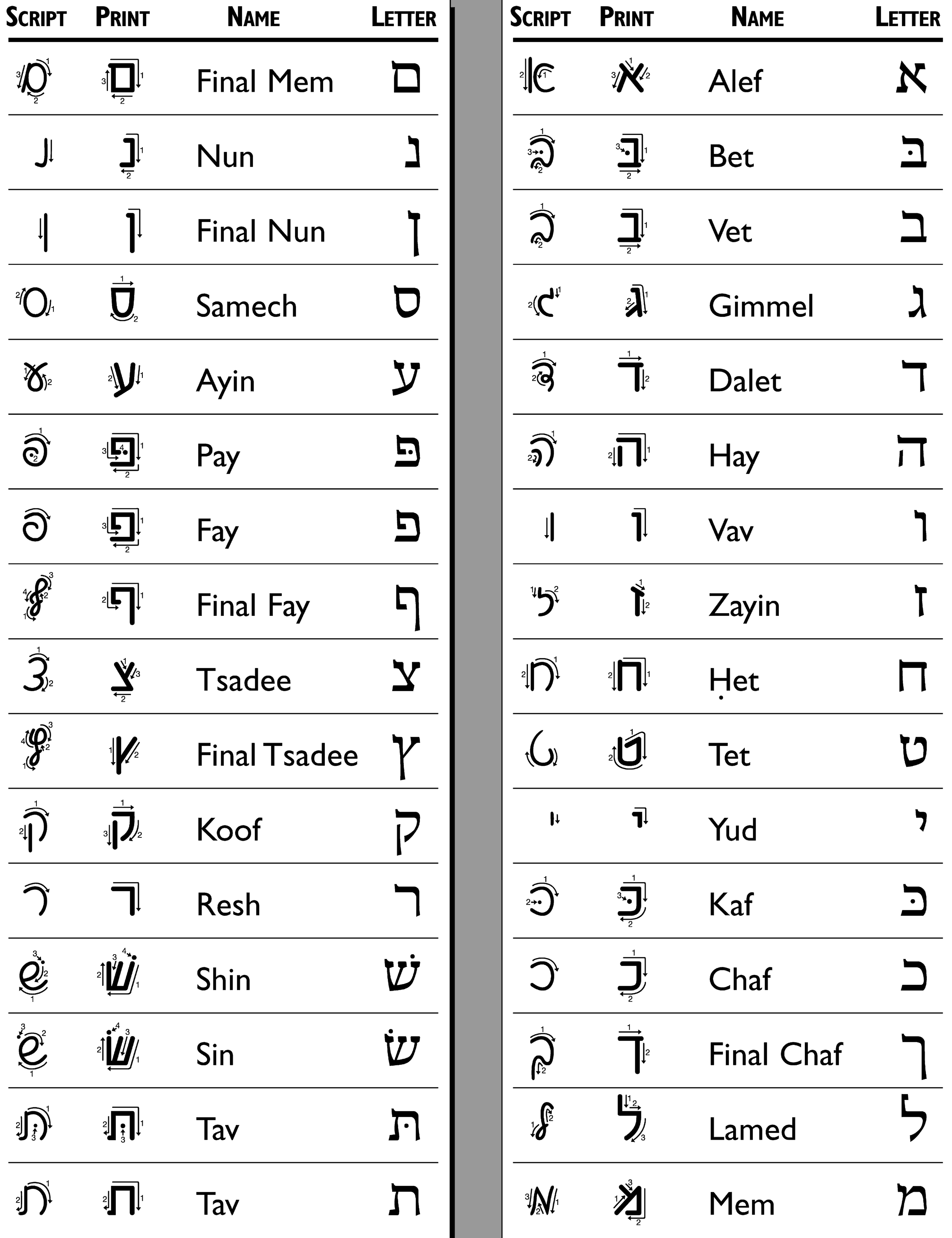
here it's the other way around, but then they write the other way around, and now I wonder if they do it to write their cursive clockwise more than we do. And because they write some of it counter-clockwise, maybe it contributes their ..magic is madness, I should be more rigorous.
M is truly a middle letter, see how here it ends the first half and opens the second half.
Now they have not 22, but 32 letters, five letters have sofits, five letters have dotted variants.
Don't they have dotted caph and pay sophits? If they have only one but not two of such, then they have 33 letters, like russian and georgian.
So why don't we choose the other 8 out of that hebrew coursive, especially because it was Dalet who told me the shape of 3. Dalet is ᚦ of ᛆᛒᚦ whatever it was, let's find them all.
Fay is 6 or Pay.
Fay sophit and tsade would make sick 4 and 7
Tsade reminds Dalet, it could also be 3
gimel and zayin reflect each other, but because I expected beth to be 2, I ask if beth used to be 2.
and gimel is a child of Beth?
Beth cursive kinda reflects Zayin cursive. Gimmel probably were wrongfully reflected zayin, or is it oriental way to reverse zayin (the final letter, Z) with B, the first consonant. B and Z, or as it was in the greek myth, B and T.
Beth and Teth,
Beth and Toth?
Seshath was her name, so I heard.
ϛ? θ?
7? 8?
was 7 the final letter in some ancient script?
I V X
I Y X
1 4 8
I L
Y C
X D
X used to be T, or rather T was written as T, so X is T for ten. or for eighT? at? oto-san?
LSD is LCD? 50 100 500? 32 64 256?
It's funnyt how with switchin one number 20% less value, in several iteration it's half of that other number. Maybe because I applied the 20% less iteration three times, it's not 60, but forty something because it applied to ever smaller ammounts.

and it's a common subject:
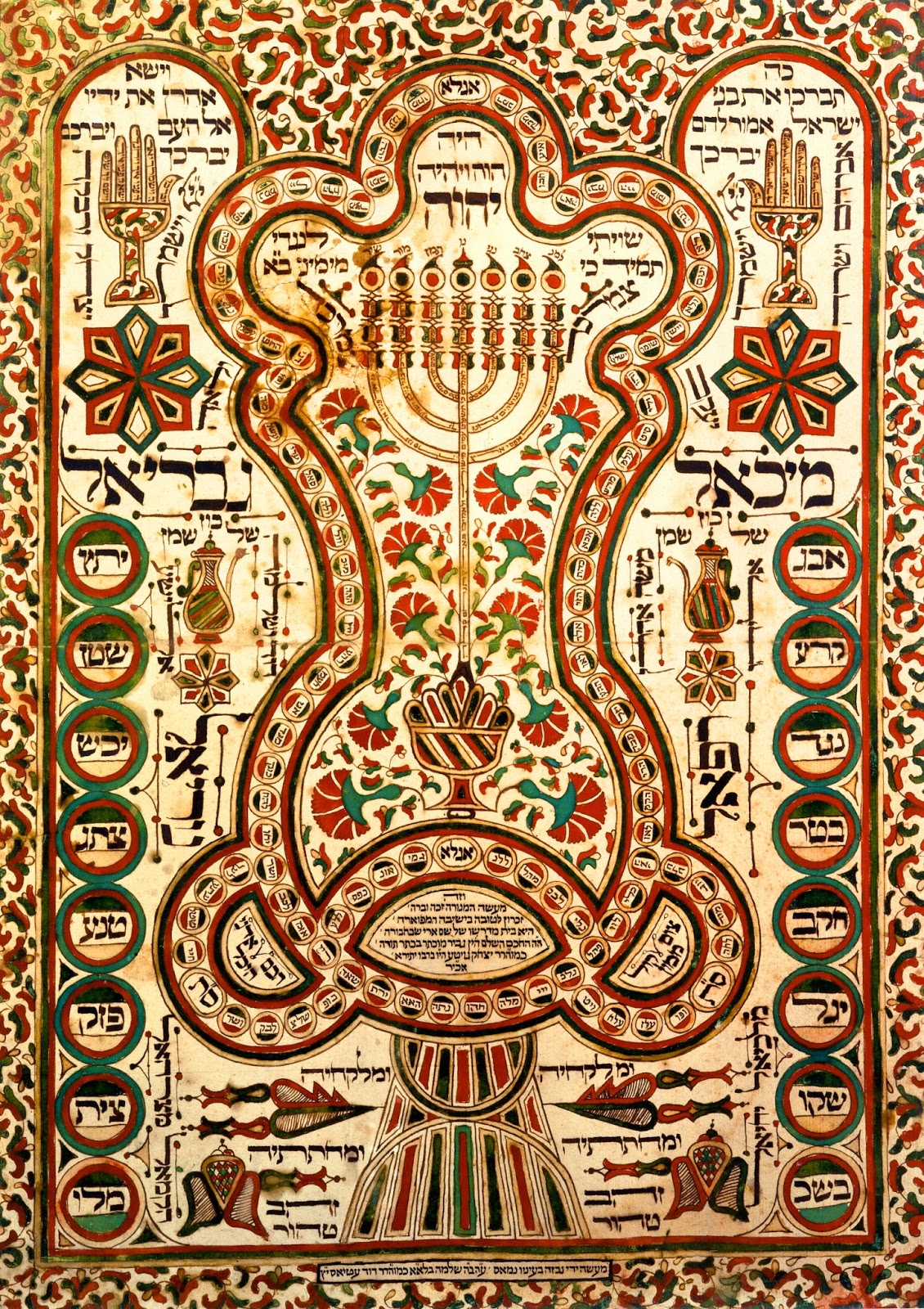
click this image, there are many more

and surfing on through pinterest I find many funnies:
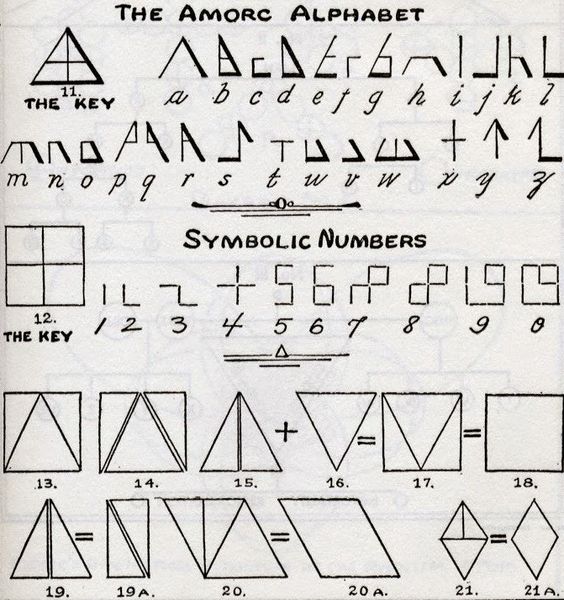
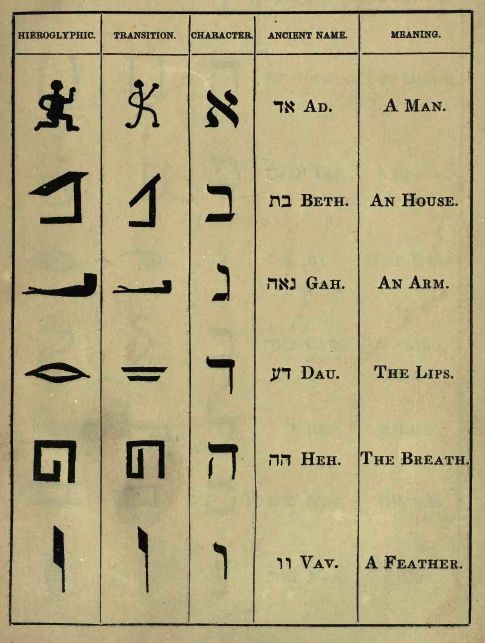

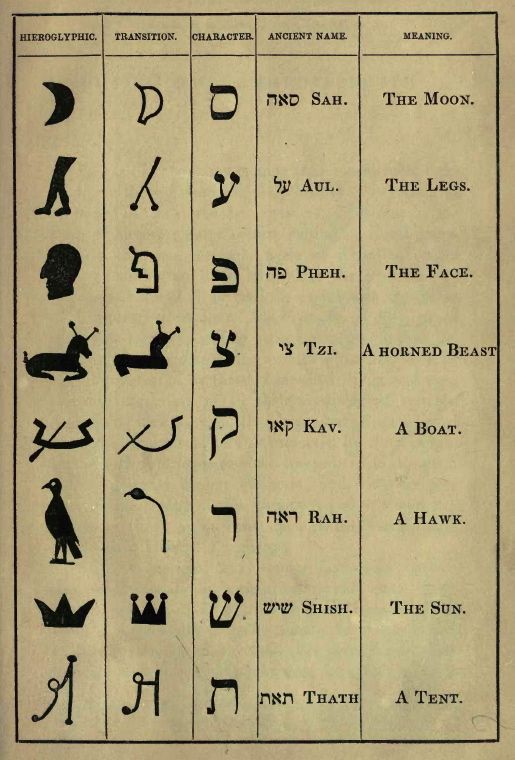
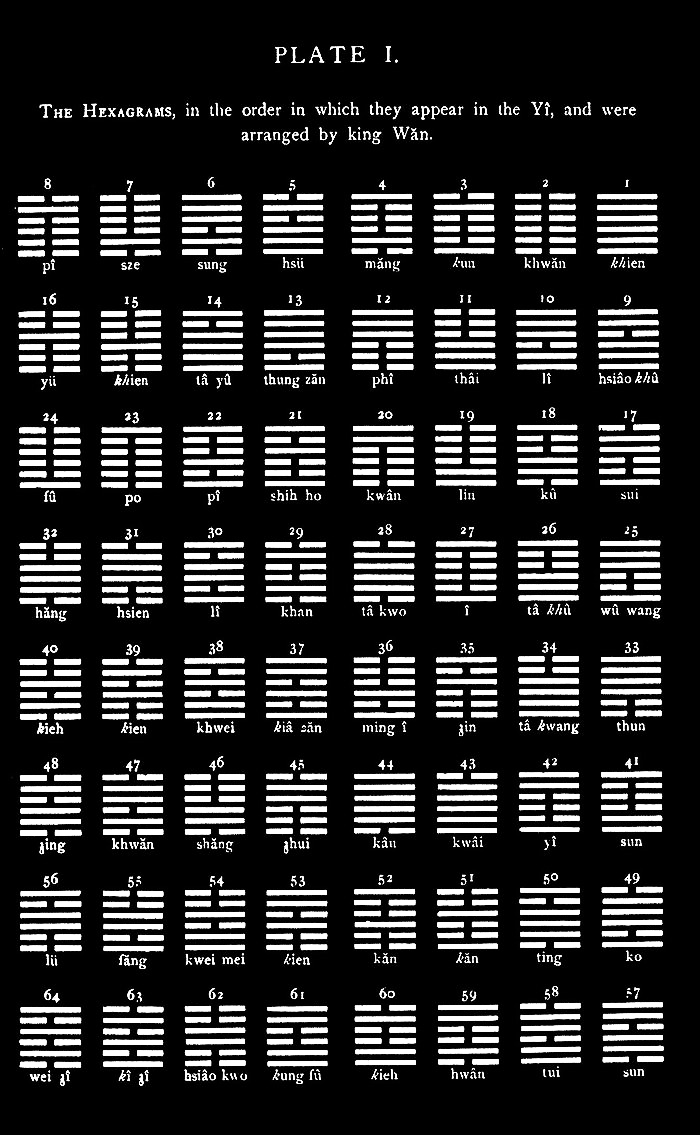
THE LAW OF CHANGES
With all languages there is magical characteristics within, in fact language itself is just about the greatest component to magic as it is the heart of the actual evocation. So thus it is not hard to discover that languages are tools for magic.
it is from the site where I found that image
What is interesting is that humans have 32 pairs of chromosomes, 64 chromosomes we're having. Could those guys somehow know it? Were they spieaking of some
here I found something which recognizes מ as 🜄 and ש as 🜂, so maybe they know what they say..

and they recognize א as 🜁, very interesting, but they don't seem to have the 🜃, as they didn't have it for the most of their history.
But one thing they did not how 231 have it, they placed letters clockwise.
And it's interesting how ☉ reminds ⵙ, but then ⵙ is S (sun?) and R is ⵔ or ⵕ (these two are probably P and R, similar, neh?
Notice how they placed some planets and elements between the zodiac symbols. But the system is missing one of the four elements (they had three elements?) and earth is not among planets, because it wasn't on the sky, so they lack earth twice. Air could be no-element, because shamaim is it, the union of water and fire, the steam, but what do I know, it is my draft and I am not obliged to follow anything here, I use it to keep me running, I come at some revelations from time to time when I go, and I believe that me dealing with pictures like this, trying to make sense of them may stimulate my work not less than thinking about what I knew before. So I'll keep on writing this log, I will extract some tidbits out of it in png format some other days. So far this session is over, it was a good seance.
Once again about h ~ ʃ:
ухо in plural should be ухи, and it would be understood, actually it's a meme, but actually it's normative form is уши, so ш[ʃ] is palatalized form of х[h] and just as c is c whether it's [k] or [s] so I suspect h to stand for both sounds.
has имеет.
have имею имей (v~y) я~you
Y is we? you & я
you is Yv
yah is Yʌ
Graphic side of ʌ and v is probably caused by it being an arrow showing to the one who brought record, or the one reading it.
And thus Я is transliterated as A, it's a variant of the reading. local variant. A also includes аз and maybe it was not аз, but a~I
I is ай
and if a is ã then so is ай
eye as Rah, R~Ж~J
R=K? or does that swash make it double? Ж = КК? graphically it is so, but I suspect it to be that case when coincidence played. K is probably a form of C which was staveless, another staveless form of ᚲ
And suddenly ᛃ is Jeran, so Ж is probably KK

As you can see, ᚼ(or ᛡ) is staved double ᚲ also known as ᛃ and I can see in them X as double (long) C
and Ж ~ J ~ Х[h, from now on I write x[ks] as ks, every following x is [h]
and h is Ж
H ~ 𐌆[z] ~ I ~ J (all share second half of the second line. The opposite of them in that line are F and Ѳ
H open
Ѳ closed
but it could be nothing (but the previous lines are just great.
Runes prove to be protoletters because they preserved the creation of letters from some simple elements such as
𒀸 U+12038 AŠ 001 001 also DIŠ, DILI, DIDLI (plural)
or
𒁹 U+12079 DIŠ 748; 749 480 NIGIDA
And in case of the ᚲ
𒌋 U+1230B U 661 411 BUR3, UMUN
some combinations:
𒁁[4] U+12041 BAD 113 69 BA9, MUD2
𒌍Winkelhaken U+1230D U U U 711 472 EŠ, "30"
https://en.wikipedia.org/wiki/Winkelhaken
So that "30" indicates that 𒌋 stands for ten.
And I thought that they had hexadecimal system, and it seems they, do, but it's weird, I still wonder if it's true, because there's this table,

but then there's also this:
The Winkelhaken (German: [ˈvɪŋkəlˌhaːkən], "angular hook"), also simply called a hook, is one of five basic wedge elements appearing in the composition of signs in Akkadian cuneiform. It was realized by pressing the point of the stylus into the clay.
A single Winkelhaken corresponds to the sign U (Borger 1981 nr. 411, Borger 2003 nr. 661), encoded in Unicode at code point U+1230B 𒌋.
other signs consisting of Winkelhaken:
A Glossenkeil (Borger nr. 378) is a cuneiform character, consisting of either two Winkelhaken (U+12471 𒑱), or of two parallel short diagonal wedges (U+12472 𒑲, similar to GAM), Borger 2003 nr. 592, which serves as a sort of punctuation, as it were as quote sign, marking foreign words or names, or as separation mark, transliterated as a colon ':'.
two Winkelhaken, MAN, XX "20", Borger 2003 nr. 708
three Winkelhaken, EŠ, XXX "30", Borger 2003 nr. 711, U+1230D 𒌍
four Winkelhaken, NIMIN, XL "40", Borger 2003 nr. 712, U+1240F 𒐏
four Winkelhaken, two of them reversed MAŠGI, BARGI, Borger 2003 nr. 713, U+12310 𒌐
five Winkelhaken, NINNU, L "50", Borger 2003 nr. 714, U+12410 𒐐
six Winkelhaken, LX "60", Borger 2003 nr. 715, U+12411 𒐑
seven Winkelhaken, Borger 2003 nr. 716, U+12412 𒐒
eight Winkelhaken, Borger 2003 nr. 717, U+12413 𒐓
nine Winkelhaken, Borger 2003 nr. 718, U+12414 𒐔
not explicitly recognized as 70, 80, 90, yet there they are. Are they added by mistake? By someone who worked with unicode but not actually knowing the cunieform? Or was it actually seen in writings?
and though of course I still don't read cunieform nor know what those as dis u and bad mean, but they push me to recognizing those simple elements in norsk
ᛁ ᚲ ᛋ but ᛆᛒᚦ is more correct form, because ᛁ is empty staff, a spacebar, a comma, a иRU.
but staveless are ᛌ and ᚲ
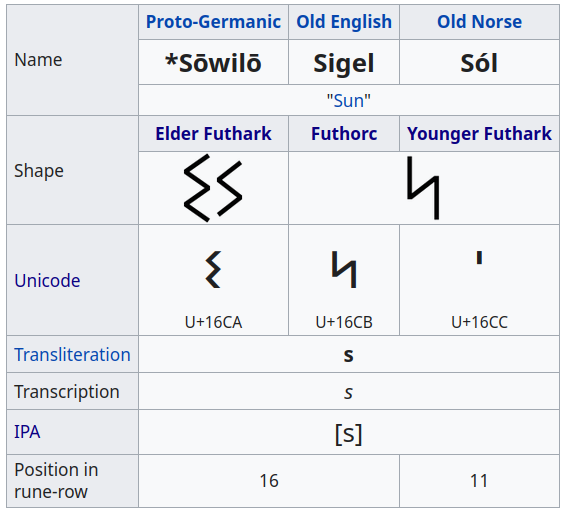

Only before copying that I thought that ᛋ could be a form of ᛃ and S double C and here I see that
ᚲ is C and ᛊ is S
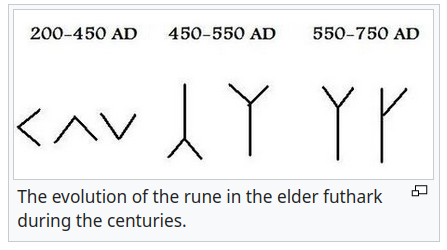
So ᚼ(or ᛡ) is double ᚲ any which way
but then ᚲ as ᚴ make that ᛌ not the staveless ᚴ I supposed it to be, they say ᛌ is ᛋ and that is 1~3, a~d, and it reveals ᛋ as an iteration of ᚦ
and then ᛌ as staveless ᛆ, which was my other thought, short stig, not long one, long one is curve, ᚲ
so were those
ᛌ and ᚲ
ᛆ and ᚦ?
I thought a~d, are they the same in the sense of being single? is d double a? makes no sense.
B is just doble D the way O is double A?
Lips are two, tongue is one.
So let's combine letters with single and double features:
ᛆ ᚮ
ᚦ ᛒ
ᚴ ᚠ or ᚴ ᛘ
ᛁ ᚢ
These nine (or ten, there are two ᚴ's: ᚴ and ᚵ) align into that single linguals and double labials well.
But there are other eight not following that pattern:
ᚾ ᚼ (её ~ her? неё?)
ᛚ ᛏ (ll~t? ſſ~f? if ſ is gamma, then f is digamma, then - is longis. t as long l.. interesting.
ᚿ ᛦ to my surprise these laid themselves out like this surprisingly easy,
ᚱ ᛋ are the only two left and I don't see how one is a double form of the other, other than § is paragraph and that word has two R's in it, but that is nothing, so I look deeper, but only see what I saw at once, that staveless ᚱ would look like the mirror image of ᛋ
But then if we don't recognize ᚿ as labial, which it is not, then we only have ᚱ as a candidate to be labial, and because all other labials are double shapes of their lingual counterparts, I recognize (or rather appoint) ᚱ to be a double ᛋ, but the following table tells that there's nothing of the kind in the staveless runes
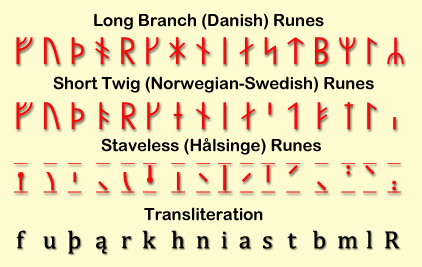
but then can I trust this table? hey seem to recognize o and b to be the same letter, but then they probably just drew staveless b the other way around, because compare them on the short twig, they reflect one another, and this mirroring thing is shown on falling stone by Bureus, and that could be something, but then I like my single-double pairs too much to ignore them. I will return to them.
> t as long l.. interesting.
tt~s? ss~f really?
The concept of bindrunes makes runic system more primal to other alphabets, where only some rudiments of it appear, that F is digamma, but nobody seems to know why or ..also W is double V, but that's it, and though X could also be double C, nobody really teach it, and they just accept it as something granted, not having the concept of binderune. Runes are ancient. They were secret, and southerners didn't consider them sacred and made them common knowledge. And that is why it seems today that writing appeared in the south. Africa has many languages and some powerful cultures, and languages seem to originate in the most developed (leaving the most of architecture) egyptian, but then they say that egyptians came there from Turkey and who knows where they lived before that.
But let's return to cunieforms we have looked at. I was suspecting that as to be related to norsk Ås for god, and what were the chances:

but then there this sign is in a couple of other languages:
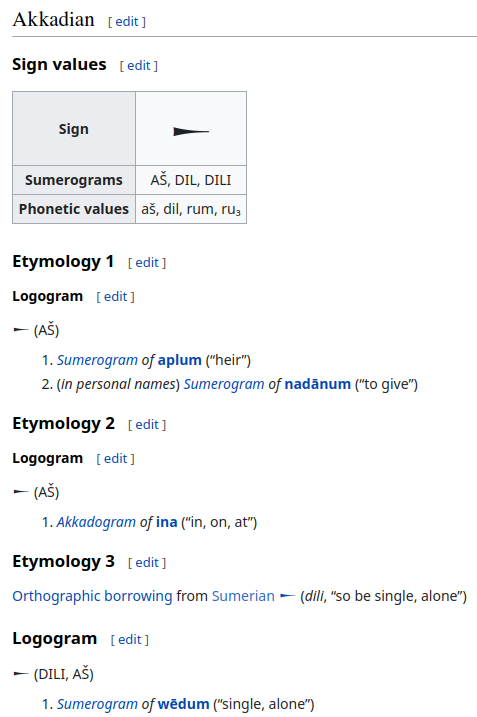


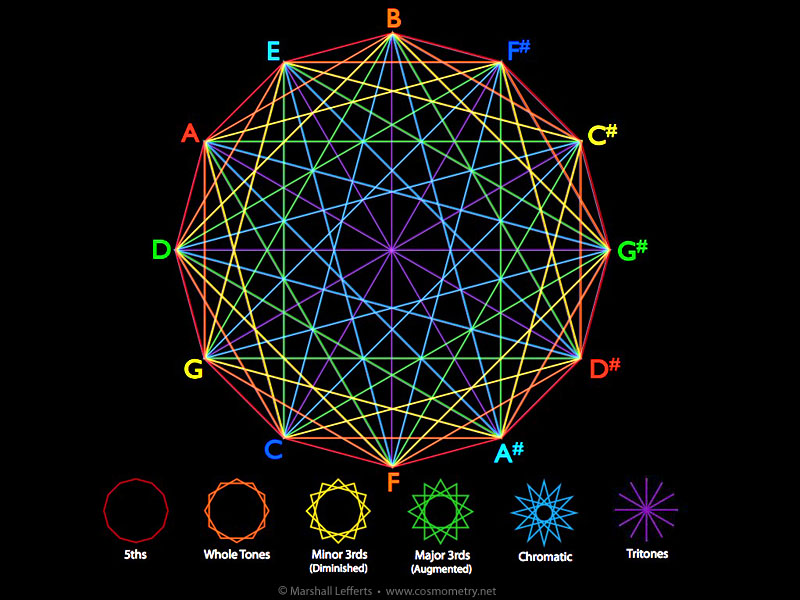
I was thinking of pentatonic looking at this star and I noticed that no pentagram can be written here. What would equal pentatonic sound?

I have no idea what is happening here, not being a musician, I am looking at if from purely writing perspective, because I believe there was so little to know, so they knew it all, it was no problem learning musical instruments and physics and chemistry, and painting and poems, and a couple of trades probably too, but of course always were present the failures too, I describe some intellectual elite, who could afford musical instruments. What am I talking about, people made those things themselves. They knew how to make them. Unless I am overglorify them romantically.
Zeug [цойг] is a cognate of Thing (zeug is translated as things, stuff, gear)
Ай шинк ай фоунд э гуд уэй ту транслитерате инглиш (ту райт ит ин этаза лэнгуэдж. Энд (эТ: et, to, да, t, +)
n in and is of ã (the ~ above a is literally N)
ãd = да
yet~yes?
and~end? и конец?
nj way, not good enough (nj is no, but it looked cool, so I left it)
nej way
j ~ t
j / l
two linguals: l is short, d. t is long, s. (ת without dot is θ(th~s))
about that transliteration into russian, I should recognize щ as sch or x[ks] or rather no, x is кс, х is щ or ш in portugese. portugal is gall, hall, Gauls, some tribe historically messed up with not less than russians.
I know of celtiberian writing systems, so I suspect that gal in portugal is gaul, celt, and voila:

(where I took the text, only the darkest-green territories were recognized as speaking it in the 21th century. Could that second-darkest green stand for where they spoke it in the 20th? I'm guessing again, it is no good, but I still don't have students I would bother to find it out)
The word Hallstatt made me think of how political term for Hall could be directly related to this natiobnal name. And almost immediately it is clear that Holland is Haul Land. Celtic land, and according to this map
But then here's North Holland and according to the previous map it never was Celtic.

back to portugal and spain, few centuries later it was in Roman Empire, so incorporating of Gaulic noblty into the imperial government as some Hall having its power within Roman affairs doesn't seem impossible, but it's strictly hypothetic, and when Newton said that he didn't produce hypotheses doesn't mean that he didn't make them, it's that he only shared with public the proven knowledge.

I'm so silly I consider Iberians евреями, Sephards were in spain since always so it seems or I don't know their history past medieval times.
Did these iberians have connections with the eastern iberia, the Georgia? Because евреи lived not very far away.
Let's take our getting into this forest be a signal to refresh the celtiberian thing:

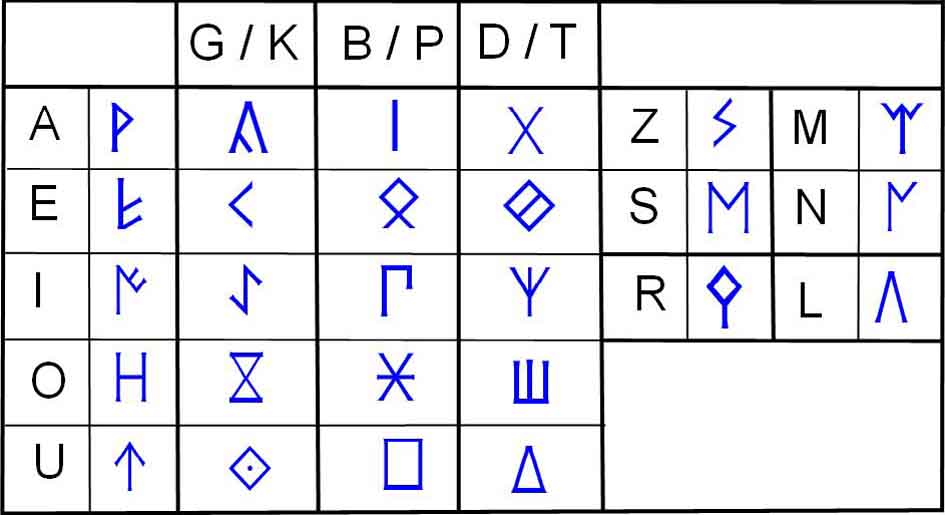
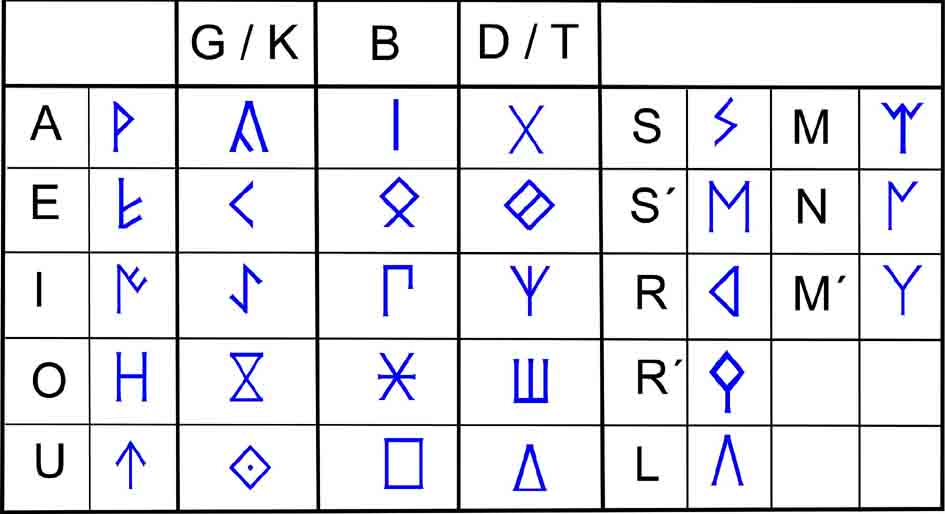
occidental oriental nord-oriental
b/p combined with different vowels very probably gave predecessors of our different labials: be/pe of occidental looks like w which correlates vav of hebrew. But П-like form is not po, but pi, which is what π is, but why? is П this much ~ M? And this P-like shape is seen in other variants of this common writing system. Po/Bo could have something in common with russian бог, because they all use some 𒀭-like shape for that.
Pu/Bu could be double Po/Bo, because oo is u in english orthography. What does english orthography have to do with it? These are obviously some related writing systems.
And that pu could be related to russian пуф, and also egyptian 𓊪, and I wonder which guess is wilder.
I wonder why po/bo are not distinguished, but da/ta and ke/ge are, as if that p/b is m.. but they seem to have M separately, as if for borrowed words, or for finals, I wish I could speak it, but let's leave it for spanish readers.
And two of three M's of theirs look jus as ᛠ which is ea (æ?) in northern runes,
One M is N in other two, showing the unity of these symbols.
Those two M's, the ᛠ's, are double N's.
and then that M-like S I spoke about this thing, I still cannot tell about it, runes also have this: ᛘ and ᛉ, as if these two systems were used for the same languages having the concept underlining these sounds different in those languages in this way. What begins with M in one language and with S in the other around there?
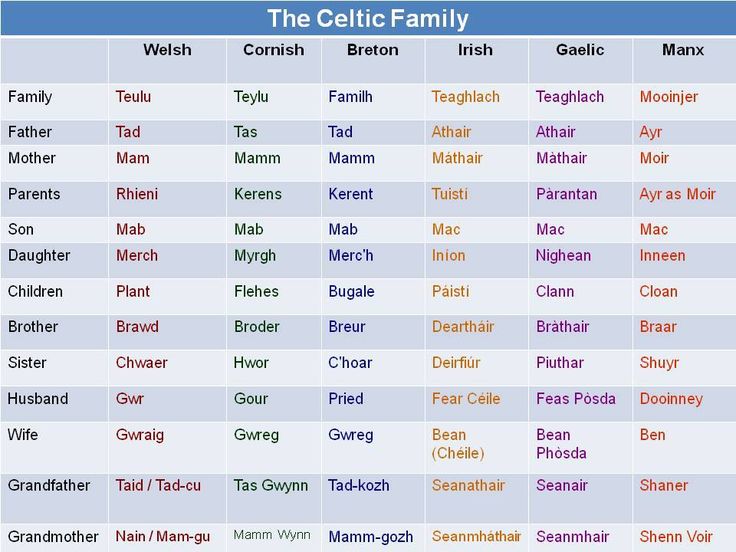
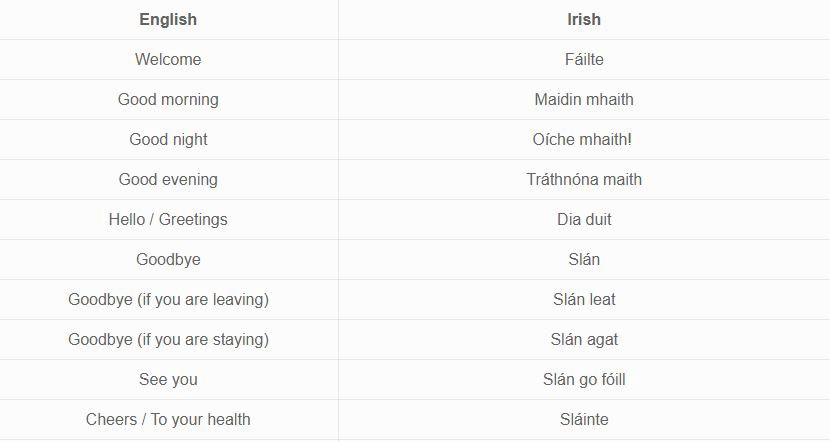



Sea/ta for "It is" are si/да
Ni hea for "it isn't" is нихуя
Good is Mais which is good candidate for that M-like S, if s is sweat and mais is nice.
I would say that Le do soil for "please" is not far from Let's do so(that) but then how can I know, I only guess, that's how I would memorize it if I had to.
Ta/nil for да/нет(nil, nihil?) tell that celtic is previously known as aryan, today known as indo-european language, even if it's not recognized as such. But it is, it is recognized as indo-european, though where is india and where is spain, it's rather vague classification, but some basic words may tell that they're related, as if borrowing some basic words made nations related even if the were not. What if sanskrit is some european texts preserved by hindus. I don't speak hindus. Let's see at some hindu vocabularies:
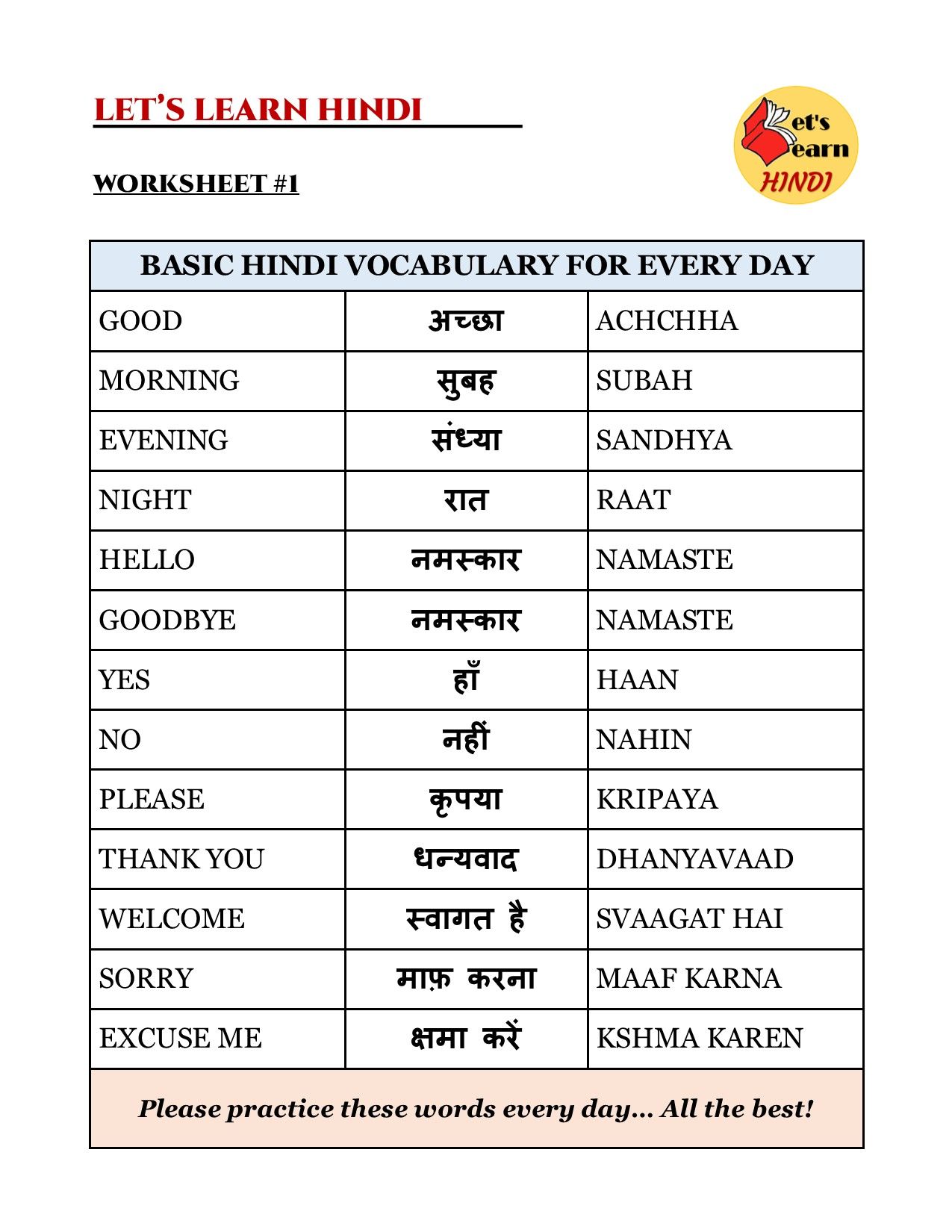
As you can see, this language has nothing to do with european words. It's some other language branch, but it is recognized as indo-iranian, which is a sub-branch of indo-european, but I suspect it to be strictly political classification, because it's nah, too different, nothing in common which I can see when I study english, but maybe I just don't know smaller pieces of that hindi puzzle, but so far here I detect classification to be wrong due to Sanskrit being indo-european, aryan, only preserved by hindus and whether being their substrate (proving that all civilizations are european, because civilization is an european trait, or a superstrate from some european conquerers of such an ancient past that we forgot about them, indians probably still remebre it.
The orientation of the horse show being lucky or unlucky is probably determined by it's orientation when the horse is approaching you or running away from you, because it determines the chances of getting beneath it's weight.
🜁🜄🜃🜂 A V K Λ or A V K Δ or A V Г Δ
and as usual in case of something I have found being sober, it's a memory rather than a revelation, I arranged it as 🜁🜄🜃🜂 before, and though I don't remembrer, I probably saw 🜃 as K as
and though some lexics indicates that these symbols were invented by some european speaker: Air or Aether for A, Voda the Water for V, Zemla or Terra for Δ, the word for fire is not tht clear, because those words are flame, fire, plamya, ogonn, but then german ofen (oven) my indicate that f could be г
But it's not very scientific,
Bonne heur (good luck.. is hour ~ luck?) ёр напоминает ур (час) в какорм-то.. uur юёр У Ё (this У Ё were here about somebody asking if ы is similar to french eu:
Is the "ы" sound closer to the dutch "eu" and the french word for 2 or is it closer to the german ö
Also do you have any tips on learning the correct declensions for words?
so he probably heard them. in his own way. Let's suppose. sup is sub is bas (низ, под.. п(п) n(n)
thi↓ (this)
tha↑ (that)
streka strela (стрекла, стрелка, сл стрела, arrow)
and to my surprise those other letters of strela are r and l: → ←
↓↑→ ←
чтоб за взлётом, чтоб за падением, следовал взлёт, чтоб концы сходились.
отличный тост в 4 символа
Чтоб после того, как брали те что по праву, оставалось бы что-то и left.
Here I give birth to a hypothesis: arrows arranged this wa are the most common order of them, and if it is so, it was a word стрела and thus indicated some hidden text.
Концы сходятся когда конец стрелы ознаменовал конец птицы, конец полёта, конец жизни, конец пути. hit!
russians used to have S:

and I don't know why they don't recognize it as S, село, maybe because they knew of voiced first. because there's земля for Z and why another Z? dz? we don't have no other z but з (which is a local form of z, just as ʒ and thus ж is two. but they list ж.
If Ѕ ѕ (they say it was used for dz я знаю только то ли польское то ли украинское дзень, т.е. ещё одна форма Д, и уместно, учитывая что она в язычной части и отражена Δ читающейся как ð
Т.о. строки - это диалектные формы. И хоть пшеки произносят как дз то что мы произносим как д, это не означает, что они целиком вторую строку использует там где мы используем первую, но father instead of pater is western european trait. We're roman in this account. First row is where runes and ogham live? abc is literally ᛆᛒᚦ and this row is another indicator of primal status of runes. They preserved the unexplained from the point of view of roman russian greek or any other alphabet really the g being d in russian and g in latin alphabets.
And runes may explain it by being the same letter. And then c~d? staved and staveless forms? But what about в~г thing? Are they related to бог~god? Whole abcd is отец-бог? на ерейско-английском? на каком-нимбудь протоязыке. in something uniting the two, protolanguage of the both, that deep far away, where we didn't expect to see the origins of writing maybe, ior would we? sygnals are all the way, they probably appeared at the same time, when our brains began operating in symbols.
Back to that russian alphabet, they made it even longer than modern one: just like moedern one only К[k] and Р[r] are not in their voiced or voiceless halves. They go longer and add only voiceless consonants to the end of the alphabet.
So the question is did K be Г, did R be voicelesss counterpart of L? I doubt it, I suspect K to be Q and R standing amongst sonors in the thus all-sonor I-line. И being Η and Н being N make me question the mirrorness of runes:
here had to be a picture I cannot find now, and then H doesn't reflect N in runes. There is some other story. Are their ᚴ r? is k R? king reiing? reying, gei.. reigning, royal, regal, regulating, ruling, realizing, and so on, so many suffixal forms stand for pretty much the same thing.
is R a form of П? ᚱ? then ᛦ is probably not R, but ᛣ the Q
opqst? опкст (о пакость?) уфхцчшщ (уф хочется чего то ж(ш) ещё?)
ъыьэюя ъыь>vʌ? ы is < and if it's i, indeed, why did I recognized э as > and not < as e? then ъ is ɔ, but I doubt it very much.
and once again I turned astray. grey paint indicates it.
and looking for that runic symmety I found this (from some of the first volume)

here they clearly placed the letters a to t into nine pairs, which can also be arranged by three or six:
abc def ghi lmn opq rst
Notice, that they don't include jk, which is that jesus kristos I couldn't find where it is written with initials JK.
But this lack of k doesn't help them be closer to 21 voiced-voiceless arrangement, it has that k in c, then f, h, and r didn't go nowhere, even though QR repeat OP and could be omitted in the name of 8, but probably nah.
let's arrange them by 6:
abcdef
ghilmn
opqrst
I wonder if it corresponds the aettir thing, but if aettir are fuᚦark, then no, but if they are mistransliterate abcdefgh, then maybe.
Let's compare these 666 to runic one:
ᛆᛒᚦᚾᚠᚵ
ᚼ(or ᛡ)ᛁᚴᛚᛘ(even though it looks like ᛉ)ᚿ
ᚮᚱᛦ(if R, or ᛣ if Q)ᛋᛏᚢ
Here what is interesting is that it goes A I O (or AIU, which is interesting, here I allowed me to consider ᚼ Η the И. because I is J and J is Ж. and if Ѕ (8 or 10, X? 8?) is dz, J~Ѕ
Comparing the opqrst to its runic counterpart, I of course am not ready to consider ᛋᛏᚢ rst, I see them as st and something related to ᚱ, but as some additional letter (why would they have it instead of ..this ground is so shaky, that let's better think of something else.
And I think that the last line is where hebrew beats runic script by ending with T, because whether we recognize ᚢ as u or v or even p, or b (if futhark is abcdefgh) it is always labial and thus breaks the symmetry.
And so to my surprise and to world peace I come to the conclusion that runes and hebrew are of the same age, both come up to some common yet unknown alphabet, I'm yet to find it, we the humans are yet to find it, but my ord predict its features: lineality. are they linear a or b secretly that? Probably not, too many letters. But syllabary predated alphabets? it's uncommon belief, but I believe so. I gave my reasons many times before (people tend not to come from simple system to a complex one, but then Euclid raping the Pythagorean teachings.
is b l n of ogham б г д?
but ogham disappoints me again. I should read how I pulled it to runes other that aa=o..
Zat special military operation opposed Z to V in some interesting ways: Zapad i Vostok? Zemlya i Volya? Zemlya i Voda? Zombie and Vampires?
Who's Zed? Zed's dead baby, Zed's dead. Zdohnut i Vyzhivut? Which reflects Zombies as dead and Vampires as immortals. Vostok is birth, Zapad is zakat, end, death of a sort.
This madnedd wasn't even worth memorializing, yet here we are.

quarter of the heaven.. quarter.. the fourth aet? 6*4=24
so aettir are probably related to the moon phases.
Очаровывать
Очаровать
окружить чарами.
вить мять (это то ли про дополнительну вы в очаровывать обсуждать пытался, но был отвлечён дебилами, орущими в большой динамик с той стороны микрарайона так, что было раздражающе слышно даже с закрытыми полностью окнами, а если через эти окна осуществляется вентиляция, то короче, зачем я это сююа и сюда притащил. а, для объяснения следующего абзаца. я сходил разобрался. я всё время на школу грешил, а оказалось что это частная инициатива (это усложняет мою социо-экономическую картину мира от того что го-о плохое, а частные люди(д лица) всегда корожие) это опечатки такие странные
Я дракон этого мира. Согласно китайской мудрости, я дракон, потому что рождён в год дракона. И негоже было бы мне отлынивать от своих обяснностей
Я хороший дракоен. добрый и справедливый. Люди знают что драконы мощные, но как человеку до муравья докапывапться ни к чему, только если муравей к нему залезет, но и тогда лучше вежливо в окошка мол иди кушай гусениц что на деревьях листья кушают.
Я ещё и лев по другой традиции. один из 144 такой один. королевский дракон, дракон лев.
Ябать сколько самолюбования. я лев. т.е. не прав? в том что лев не прав, ты человек, и кроме гривы да и та человеческа.
How did it happen that lion and left is the same word in russian.? lion is the only animal that lays in egyptian hieroglyphs. Doesn't snake lay? No, it crawls.
I for the first time really noticed that I always hear cars here, they don't annoy me because they are ambient. with electric cars the sound will change. That will be quiet and thus they need to take roads underground or to make them on autopilotso they don't crush into people who listen them thus worse.
my duty (what I need to do, what I have to do? what I do) will make studying foreign languages much easier. Much easier. You will simply see that some element fo russian mind is this element in english mind, and you will say about situations differently, you will think about them differentl.y/
first fining is that many words are alike, so it makes sense to study them first, and maybe it will be enough to speak using just them. So that when new words would come, you would ask synonyms and found amongst them the word you knew. It is yet to be tested, but maybe recognizing common elements like this would make a trick.
synonyms of want wish will
will когната с русским воля, велю.
I is я
but also me ~ мне (когнаты синонимичные другим словам, тем что разошлись сильнее.
как так получилось что я ик словно а и к были одним словом?
русское К
французское А
европейское К
ивритское (иберийское?) 𐤀 (А)
я смею писать, что финикийский не источник, а лишь один из многих в своей сути, но он не хуже других, один из мощных источников для моего исследования по крайней мере, какие-то черты которого позволяют сказать что-то об общей системе. Сефер Йецира отличный подгон.
Французок когда обсуждали с другом что они не очень европейские, сошлись на том что жидовского больше в них, а по сущности чёрного, тёмного, небелого, злого, воспринимабющегося как зловещее как тёмная туча в небе.
К тому что французское а может быть отражено еврейским 𐤀
а русское к может быть отражено европейским собственно К
И таким образом графема К отражает касание, дуга руны ᚲ только касается става.
То пересечение става, которое в этом шрифте показано вовсе не обязательно: в другом начертании этой буквы она даже не касается става, а буква та же самая, в том же самом алфавите, только курсив.

There it is in the top right side, but why its print shape is such, I have no idea. It is not that far in its graphic from K too, to this day I mostly saw H or Х now I also see N in it. Are they all the same letter?
Here, it can be even more separated:

I was taught to write it separated.
So it's semantic signs, not articulatory. Maybe only bdpq and I am not sure about q. Why is it not bdpt? q is in the t claster, so is it a form of t? like c is k sometimes, but also tʃ which is right next to t.
is it how far c go? as far as I know.
Театр начинаетс с вешалки.
Театр Т
Вешалка В
Мужчина начинается с женщины?
А enter?

два из четырёх на а, но я думал об ã в entrée (which is possible "on through" in english)
в русском вход на в, видимо вешалку придумали позднее.
фэйс-контроль на входе, до проверки билета,
что если брат~враг является ключом? я отмахиваютсь от этого, но похоже что это гораздо ближе к правде чем хотелось бы так думать. От простого козла можно отмахнуться и дел не иметь, но брат это брат такая штука, что..
г~т
ᛐ~ᛏ
и если г~л, то

Latin and greek here look like male and female
I first noticed it by the genetals. Or no, first I saw it by human-like figure if the eyes were red (like mine) it would be У Ы
a is hat. it's not a body yet. people named body parts by this picture? I seriously doubt it is, because evernnation has different structure, but then they also have different languages, maybe one is caused by the other.
I was looking at it and I thought what if Y is a vowel alright?

It's very uneven, but yz reminds russian яз of язык (language)
As if язык tells story of A K (А в русском называлась Аз, поскольку слог закрытый, второй ыК может быть об К
А К -or- AC
Y Z shows this. and if it's some proto-abc, then and because Y is IJ, it reflects both I-line and greek E-line, and thus tells that J could be in the column of labials for being some ю, but greek doesn't have it, and no other alphabet gets it, so it's a M's spot. And anyway though this aproach kinda tickled some sinapses, it didn't bring anything spectacular, and is thus considered faux pas (false path)
Tupac can be read in russian as Tiras.
2pac can be read in russian as dvoe(2) ras(races) что неизбежно вызывает вопрос-переспрос "две расы?" типа он полукровок? и чёрный и белый как большинство house niggers. I am a house nigger, I am smart and I don't like to work.
самолюстрация. it's too noble to wait from gangsters who call themselves governors, government.
we have to think on what
Ускорить приход второго пришествия молитвой по теоретическому описании практического процесса молитвы: там где двое или трое соберутся во имя мое, там и я среди них.
её
эо
эɔ
The hebrew-like K-ness of aleph encourages me to compare brahmic to other alphabets:

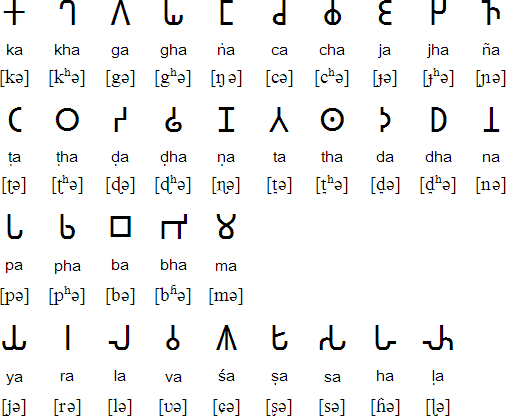
It seems to remind letters from different alphabet. It explains russian Ч. If not exactly explanes, it links these two shapes between russian and brahmic. 𑀕 and 𑀗 look like their semitic cognates (сознать, узнать, and thus z in greek alphabet is g in roman alphabet) 𐤂 and נ
𑀚 may remind european E (je? what is that dashed j there, I told you I go wide but thus not deep, the following is left as an excercise for the entertainment of the reader)
Some shapes look tifinagh:
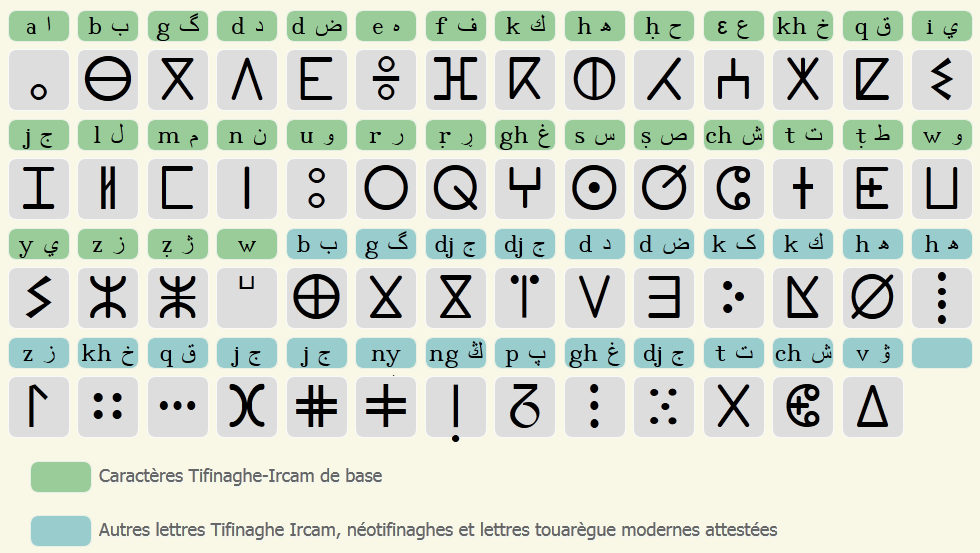
ⵙ and 𑀣 kinda same th~s could it be a coincidence because ⵔ and 𑀞 do not match
tifinagh ⵙ is s, but its name is yas (almost as the s is called) speaking of язык, s as final letter of the three mothers.
brahmic 𑀣 is th,
tifinagh ⵔ is r, it is named yar (almost english name for R: ar)
brahmic 𑀞 is some similar to 𑀣 ṭha (but here this one is with dot, and there that one)
but then in latin alphabet R S go as one claster, the linguals of the o-line. O line. O indeed
O~R? as A~Δ?
οπρσ have some roundness, some similarity, as if o is from rs-claster, as a~d, as I said oh for so many times
and π is somehow of τ: папа~тятя
м влажный поцелуй, звонкий
п сухой поцелуй, глухой
м
п
основа алфавита? ведь освоимли люди основы, а раз про глухие звонкие они и интуитивно понимают и в школе им с этого фонетику согласных начинают объяснять, то это быть может основа и есть
мама папа
deda mama? It is as much of exception as armenian alphabet, and as armenian alphabet was explained, so I believe this fluke of georgian lexics will be explained.
М оно же В оно же Б
П оно же Ф оно же.. H? оно же Д? оно же Т? папа daddy тятя tata
pqrst is the papa line? O is отец.. это было неожиданно, и да п начинает глухую половину
(папа не слышит ребёнка, это работа женщины менять ему пелёнки или что там раньше было, сиську давать чтоб замолчал)
Баба означает женщину вообще,
Баба и Деда как две половины мира?
Баба и Папа другое представление того жде самоо смысла?
Мама и Папа другое представление того же самого смысла.
I line is line of personal pronouns? of first and third person.
IGB jeFR jeNL jijNL jouaNL ikNL (il elle le la les me)FR (мы нас нам он)RU (and here o-line begins)
отец папа que? are? is? est? and here where t breaks in. which is тятя, qrs though set few questions.
б брат
с сестра?
I was thinking of с the s, but c the c also makes this pair.
the first ant and the last in whole the alphabet is the first and the last in the last one first line.
baba deda are both mom because they are both voiced?
ama for mama I only heard from ponasenk describing some italian kids calling their mother.
Catalan mare pare sound almost exactly like mother father, so in our quest for cognates we shouldn't watch text, but voice samples.
The speech речь - how are these words so similar? is it showing that R is cP binderune?
smell sounds as spell (which makes good sense: I put a spell on you ~ I put a smell on you)
(vboth are invisible but kinda has some effect nevertheless)
so M~П? all labials are ultimately the same? Then is it this weird that georgian papa is mama? Then their deda ~ тётя. И это сплетается вобщее недоразумение, недоразумение требующее дальнейшей проработки.
decade ~ десять
I typoed it as deade, and to my surprise cadere is to fall.
брат и враг похоже что не такие уж неродные слова. братские народы враждуют. друзьями и соседями были бы, не враждовали бы.
брат брать (утаивать) врать враг ворог вор (побор, боря бояр, бранимир воевода бояр бояца
are all affricates one symbol?
drugoy zdrastvuite vsplesk what common letter will I find?
Нельзя общаться с людьми по накурке. но я общаютсь и в этом мой демис.
Ball makes me
мать та кто лезет разымать
мать значит имать, у мамы мы.
у брата брат а значит брать
берём и боремся враждуем как враги
брат брату враг и братские народы с враждой по жизни и в европе и везде
что разделяя властвуют уроды моральные но аморальны да вполне
(это текстовая рыба, стихи приходят как песня, и если где-то затупа в плане рифмы или ритма, после отредактим)
бать тоже мать, если то мама ото он баба
ото это то же от
а эйнштейновыцы заляпали его своим, жидким, жидом (in english
отойди от меня
отопри от тудава
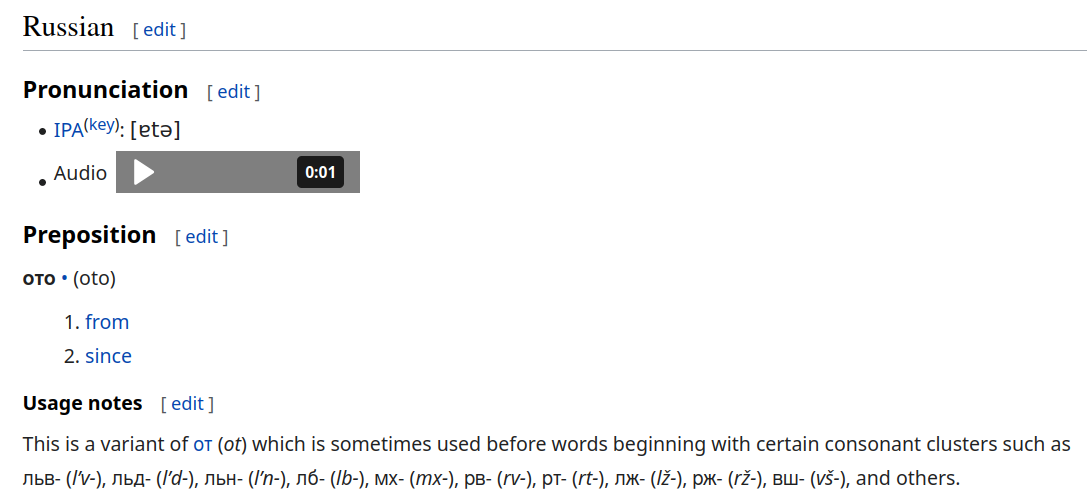
no wonder I couldn't find any example myself, it's a very special case, surprisingly special case specially special case, I have to look deeper into this phenomenon.
ото льва, ото льдины, ото льна, ото лба, ото мха, ото рва, ото рта, ото лжи, ото ржи, ото вшивого?
я бы сказал от вшей, т.е. вш ошибочный пример.
Интересное явление, я не могу сказать ничего о нём.
G finds 335 cases of "ото вшей" (в предложении "уже с помытой головой и защищённой ото вшей"
G finds 443000 results for "от вшей" (so those 335 could be the victims of that weird academic norm nobody seems to get (for so many weird cases there are)
Если ото
русская культура
дура дура дура дура
зверь, зубы, зло всё на з
Zombie как и Vampires bite
so Z and V could be the two evil letters, the letters I recognized as infernal.
VWXYZ are all these evil?
A
B C
D E F
G H I J K
L M N O P Q R
S T U V W
X Y Z
A
B C
D E F
G H I J K
L M N O P Q R
S T
U
were that infernal line added to turn female figure into male figure?
was it even shorter?:
A
B C
D E F
G H I J K
L M N O P Q R
S T
Were additional letters added to have this L R symmetry?
was it something more like
A
B C
D E F
G H I J K
L M N O P S T
or was it tetraktis before they mutilated it by developing that vowel column?
A
B C
D E F
G H I K
and LMN is how the other half of the alphabet begins, and because there sonors and voiceless, I suspect them be the other two triangles:
L
M N
O P Q
R S T V
And to my surpres another tetractis it was. I doubt there is place for more tetraktes, but there is:
1
2 3
4 5 6
7 8 9 0
or
0
1 2
3 4 5
6 7 8 9
or was there zero in that time? What did pythagoras himself used? Did he invent some decimary to count in tens? Was it the originator of it being the inventor of the tetractis.
Tetractis is a triangular letter. They are 1 3 6 10 15 21 28 36 45
9th triangle is 9 times 5
7th triangle is 7 times 4
5th triangle is 5 times 3
3rd triangle is 3 times 2
1st triangle is 1 times 1
2nd triangle is 2 times 1.5
4th triangle is 4 times 2.5
6th triangle is 6 times 3.5
8th triangle is 8 times 4.5
thus nth triangle is n*((n/2)+1/2)
thus nth triangle is n*(1+n)/2
thus nth triangle is (n2 + n)/2
let's take 8: (n2 + n)/2 = (64+8)/2 = 72/2 =36 (I had different number in my mind, I couldn't add 8 to 64 properly, what a shame)
I can prove it graphically, and those today jews lie that it's not a proof enough, it is enough even though some graphic sphistry, like that trick with rigged chocolate shows, when applied properly, graphic proofs are no way worse than
I thought of a product on the basis of those tetractys.
And naturally I would add LMN-tetraktis on the reverse of ABC tetractis, and then I'd have something to add at the other side of the 012-tetraktis.
V
WX
Y Z +
- * / =
priest has the ending similar to scientist.
is priest secretly preist? payist (because prayer is his pray. and the members of the parrish are prayers too. It's as if it reveals the connection of these suffixes to similar comparative and superlative suffixes)
я твой брат ~ я твоё брать
братство бранное.
на поли брани? поле брани именно что поле вражды. бравады, процесс отобирания. всего города для поборов. богатые города, но там богатые хозяева, с лучшим вооружением. готовые к бою, сами богатые потому что в том числе и награбили. Так ли это? Самые богатые города торговые, где купцы чувствуют себя комфортно, т.е. там где защита от грабежей себя зарекомедовавшее, и скорей всего это изначально торговые города которые так же и промышленные. С кузницами просто вначале этой гонки вообружения.
V Z ring in my head with new meanings: Vladimir Zalupin. Царь Залупа, что идентифицирует
ЀЁЂЃЄЅІЇЈЉЊЋЌЍЎЏѐёђѓєѕіїјљњћќѝўџѠѡѢѣѤѥѦѧѨѩѪѫѬѭѮѯѰѱѲѳѴѵѶѷѸѹѺѻѼѽѾѿҀҁ
҂◌҃◌҄◌҅◌҆◌҇◌҈◌◌҉◌ҊҋҌҍҎҏҐґҒғҔҕҖҗҘҙҚқҜҝҞҟҠҡҢңҤҥҦҧҨҩҪҫҬҭҮүҰұҲҳҴҵҶҷҸҹҺһҼҽҾҿӀӁӂӃӄӅӆӇӈӉӊ
ӋӌӍӎӏӐӑӒӓӔӕӖӗӘәӚӛӜӝӞӟӠӡӢӣӤӥӦӧӨөӪӫӬӭӮӯӰӱӲӳӴӵӶӷӸӹӺӻӼӽӾӿꙊꙋꙀꙂꙄꙆꙈꙌѾꙎꙐꙒꙔꙖꙘꙚꙜꙞ
ꙠꙤꙦꙨꙪꙬꙮꚘꚚ
Multiocular O (ꙮ) is an exotic glyph variant of the Cyrillic letter O. This glyph variant can be found in a single 15th century manuscript, in the Old Church Slavonic phrase "серафими мн҄оꙮ҄читїи҄" (serafimi mnogoočitii, "many-eyed seraphim").
thus ꙮ is goo, and it makes sense if its' some little multicellular organism, that serafimi was just an excuse to pull the biologic symbols into unicode: ꙨꙪꙬꙮꚘꚚ
here we can see cell and it's division. and then a gastrula and maybe two first divisions separately for whatever reason (third division is hard to distinguish from the second from one point, maybe in video by the pulsation.
э а ы у ы
где ваши ручки
ваши от мои отличаются тем, что ваши это Аы, а мои это аЫ
as if you would call the opponent A (ا) and yourself И (я=I=me=мы(я и ещё кто-то))
бочска коробочка
Museion
Alexandrion (or something of this kind)
Το Μουσείο της Αλεξάνδρειας ήταν επιστημονικό-εκπαιδευτικό ίδρυμα στην Αλεξάνδρεια της Αιγύπτου. Εκτός από το κτήριο το οποίο περιελάμβανε τη φημισμένη Βιβλιοθήκη,[1] ονομάζονταν έτσι και η εκεί εργαζόμενη χορεία των λογίων ανδρών, οι οποίοι διέτριβαν και σιτίζονταν με δημόσια δαπάνη. Ασχολείτο με την μελέτη και διδασκαλία των επιστημών και της φιλολογίας.
The Museum of Alexandria was a scientific-educational institution in Alexandria, Egypt. In addition to the building that housed the famous Library, [1] it was also the name given to the choruses of learned men working there, who pierced and ate at public expense. He was engaged in the study and teaching of sciences and philology.
Αλεξάνδρειας
Александр is Alex-Andrew (A)
sa Andrew per se is Ann-Drew (of one of those) female names of matriarchal period.
Alex is Alya's (k~𐤀 again!)
Дмитрий is literally Demetra's. Деметры. болгарско Димитр is literally Деметр (de mater)
Деметра Deia Mother θεά μητέρα goddess mother фея митЕра they read it, And I say F~D? DeF
so?
θ stands for both ф and т, so voiced-voiceless was divided first. And that was all we got there. in schools, they taught us, but in general, in the past, we could miss the later material, where labial/lintgual was tabooed because of obscenety, even now peopple read about genitals in a linguistic text and they go "now you вообще блин"
Ѳ as both f & t tells me that it united those two halves.
andf because Ɔ~O, use of Өө used as some Э (even though it is transliterated as Оъ оъ or Ӧ ӧ you should check such information by watching those signs pronounced on some video service.
service~servers
it's almost Э
Меч кладенец в колодце (хОлодце) застывший остывший, закалённый меч.
Калёный меч не тупится, то колется в обоих смыслах (хороший остро колет, но хрупкий и может расколоться сам) Т.е. при выходе на битву с кладенцом необходимо иметь обычный меч про запас.
The story of lady of the lake is about putting swords to bless into the lake.
One sword at a time, so the water is cold. That is why the story tells of only one sword.
I wonder if some story tells for how long was it to be placed into water.
I wondered If should use into water or in water, but it seems that if place is a verb, then it's into. Without to is when it's a noun. Which is ..is to ..has to come with the verb?
Noun is IS
Verb DOES
do/be
does/is
be and is are just two different ways to oppose the do?
a~b~c
am~be~is
d~are?
a~b~c
am~be~ce~is
Я~Вы~Сие(сии, сиё, сей, сия)
второе лицо глагол? императив (it is a noun? you verb? I am? имею? умею? ем?)
is is also a verb, so no suprise am is a verb.
am is me reversed
be is ю reversed? we is another ю reversed? (ю=you)
be~me
(вы is of мы, ты is of те)
Was M replaced because I-line was :) line? two pleasures are мак и лоно
ν ~ v and ו ~ ן show that ✓ ~ 1
one
онRU ~ винUA maybe indicates that slaviks used some hebrew script where o and v were the same kletter.
✓ ..I was thinking tag? tick? It is check. all three are triplet (tripled)
Alex is Alec's? Alice's?
Andrew is Ann drew
Dmitry is Demetra's
Ivan is Eve's
Io is another reading of Eve.
(ШI will have to look in tanakh where there יהוה's are and if Eve makes sense in that context, as if she was revered to as Maria is in christian beliefs.)
От тетраграмматона происходят сокращённые формы יהו — «Иахо» и יו — «Ио», которые входят в состав многих собственных еврейских имён. В еврейско-египетских папирусах, трактующих о магииruen, оно уже появляется под видом др.-греч. Ίαωούηε.
Ίαωούηε is 7 greek vowels. Exactly 7 greek vowels and nothing else. So AEIOU is some semi-forgotten magical name? The one of some pentatonic scale? The previous tradition? It looks like this.
Yet how can it be? Is torah a mystification? No, but maybe some parts of it are. What made me say no? The ו's in the beginning of it lay out some pattern. Some pattern speaking of M before whatever was the final counterpart.. Z? ת
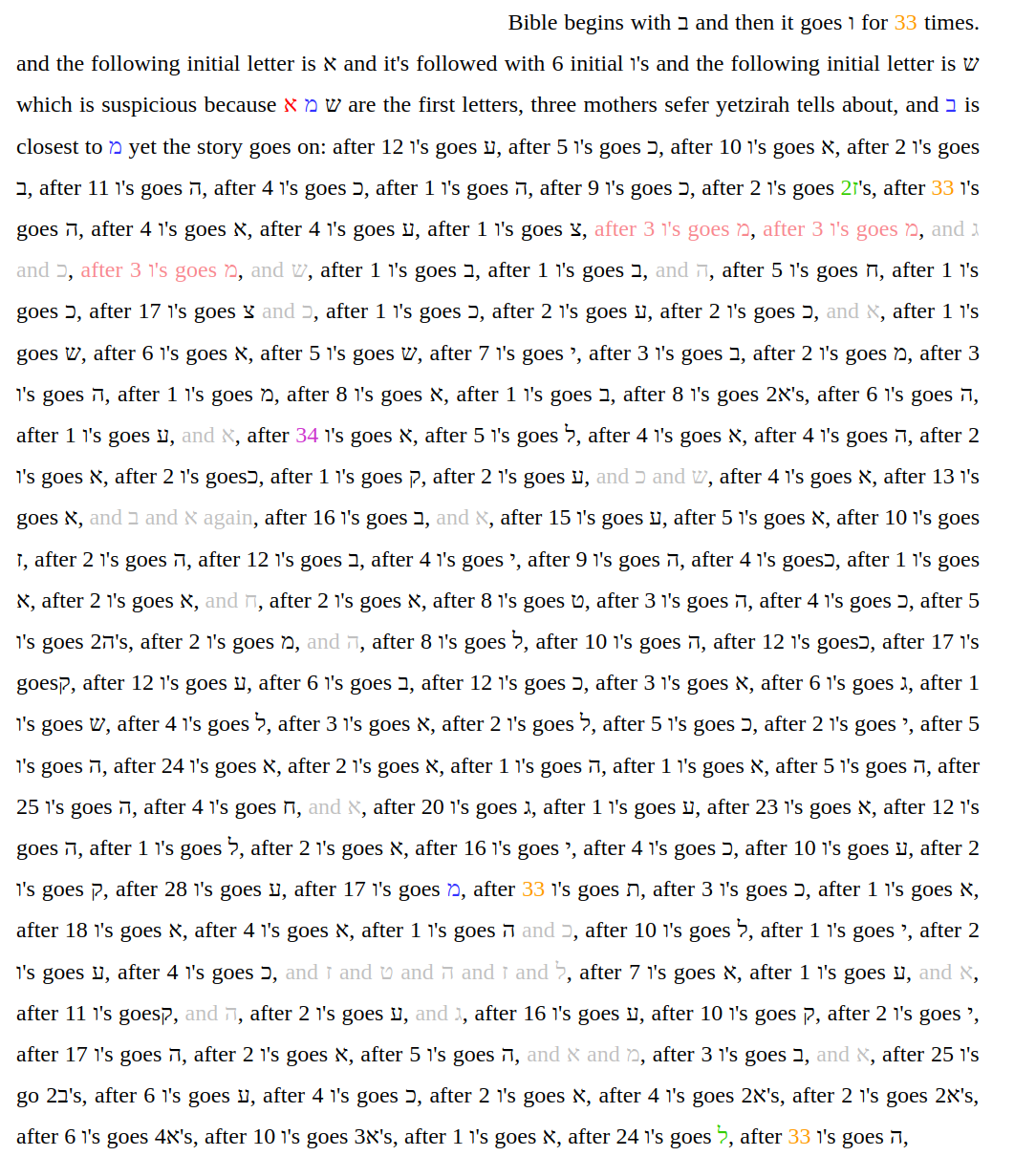
it (the first ב) probably tells that in ~m ~ в[v] and that could relate to that ν ~ v thing.
Иосиф сын какой нибудь Ио? Была ли у евреев матриархальная поз.. традиция
традиция through?)
позиция (по?)
Как мы индексируем воспоминания? если нужно вспомнить что-то про машину например, и я с закрытыми глазами увидел как я представил шину с крылом вокруг неё, вроде бы с голубым крылом, или бесцветным, it's all around the wheel?
машина на шинах? машины сразу встали на шины или как они назывались? механизмы?
машина машина махина
махина массивна
ш~h~ss~cc
thus H=II=CC
thus c=i? it would link i~e~Σ~c thing, and thus only three letters were: WMΣ
or before it even two: MΣ стоЯщая и лежащая (стОящий и лгущий)
ω~W~ł~Λ~A or am I really pulling and pushing it at the same time.
Russiaты are in time, not on time, not at time
Russians are on the street, not in the street, it is as if russians care about time more than about place, they surely don't care much about their place, for it's a mess, it's many messes, it misses a lot.
mass mess miss
pass pussy piss ?
us as, ass is
of if
on in
all ill
wall will
wand wind
what wit
wait white
won win
this mechanical work should be left to more skilled in that ai. I must focus on revelations only humans seem to be able to do so far. But not for long.
actual is factual
act ~ factENG
actum~factumLAT (act (but not fact) is translated by g as the same)
Yggdrasil is probably egg tree shall (or shell? like my capsule is both egg and shell. I am the egg. egg through cell? Ygg dr.)
sealed shelled
seal is will (shall)
w sill very сильно?
игг дра сил
яйц дерева силы?
gg ~ jc ~ йц
k sounds probably came later, and why they are in the
We have five fingers. ABCD? EFGH? IMKLN OPQRЦ - I'm not even sure about theis on..
I look at my palm with thumb showing cells on the 3*4 table of the palm.
12 cells of this natural and universal table and I can recognize them as 112 months, they're the natural basis under the number of 12. Moon to our surprise walks around 13 times, and we broke our mind to prove it. Moon is the weigh within out waters? But tghen there was 12~13 dissonance. And we have bent our minds around dividing the year according to our palm and not the moon we usually don't care about, but the cults of three mothers (three moms, three moon, three lunes. mln are those faces? ל מ נ LMN ل م ن ΛΜΝ and here we go Λ Λастущая? ל? but then their נ is also looking this way, but then it is so only because the direction of writing is thus, but actually sophits matter more: ן but then still, and I dunno, LMN directly place L C-like. and only LMN reflecting ΛΜΝ make me look into this problem further. they remind 132. ΛΜΝ even more. some fonts of them are directly I II III:
uvw here remind that mn thing is r between l and n? short n? l with a vibrato to it. It is the other velar, velars should stick together. k could take place of R
that k looks like hh binden rune. Runes and alphabet is the same systme, megasystem,
I just saw my hand as a table of 12 digits. literally digits. how could I be not noticing it before?
I remembered I wrot about it, I did. So I go on:
A? horosho? the OK gesture could be a. Я сделаю это, а? and that а in russian is alike to japanese ka, to chinese ma, in english it's more grammatically complicated: shall I? am I? is it? doesn't it? and so on, there are plenty, as if they have the idea of it but not the word for it. but then they also usee eh sometimes, which is a nice sequence past russian а.
12 per a year or a day is 24 on both hands. And I wonder how could I first see official older futhark instead of a day divided in hours. You may send signal of time. It was single of time and of month and how would they show a day.? 24×24 is 576 which is even excessive for 366 or 365 or whatever. I never measured moon, how many crescents walk pass earth per a year. I never lead a moon calendar. Whould I become lunatic if I did?
I don't like keyboard, but I notice that it keeps all the vowels under my tips. But then I notice that it keeps every other key under the tips. What a wasted pothead am I? I just leave every flaw here, I maybe cut some atroceous useless thought, but most of them are still here, Some of them are potentially useful, that is why I keep on going.
A
I
U
are probably the vowels of the first alphabetic count.
A B C D are thus tips of the fingers on left hand (because we count left to right. hebrews are probably writing right to left to use the right hand for count. Are these two paths? Right hand is order, it's jews.
Left hand is destruction of this order to go free? Gentile uprising?

Other practitioners state the difference between the two is that the desired outcome of the right is to be beside "God" and to serve him, while the left believe in self deification and bow to no one.
but then the terms are so loose, defined by different groups they're full of biases. This one is adopted by me but then I practice both, I want to be neutral towards influences, I want to be in contact with both sides as Sebastian Bach was the only one who managed to keep contact with Axl and Slash and probably influence them to reunite, but so many years passed, hardly will they keep on delivering, though if they didn't reunite they would certainly didn't (to my surprise I'm not sure about grammar here)
And I understand how digits of the left index finger be A I U: so that the digits of the right pinky (or right index finger, if it went in reverse) were E O Y. So that the additional two digits past Z could be used for either yes/no or for some letters from the previous line.s
A B C D E F G H
I M L N O P S T
U V W X Y Z(R J for example)
I E O U (a could be some later addition, it doesn't follow the descendingsequence others do)
I A V is the pure descending sequence and the finding is influenced by YO! (also used by dutch as ye ya and russians as je[ʒe])
And here I have intercranial databases a little fluffy. I kind of remember som ye of toch-like je or jo but internet tells that not exactly, the closest I could have is deutsche ja:
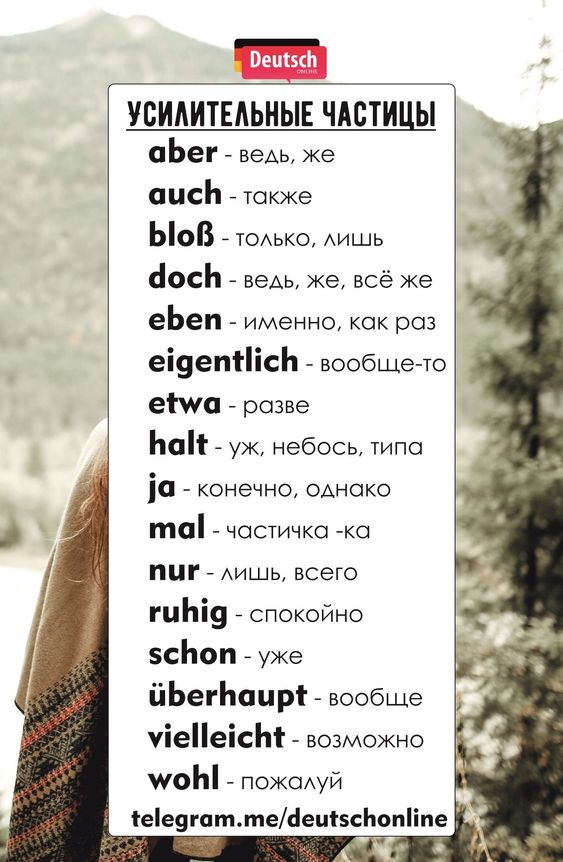
why is also used in english: I can go there, yes?
and I recognize many german words from english and I can see how it could be easy to start understanidng german with figuring out these cognates first:
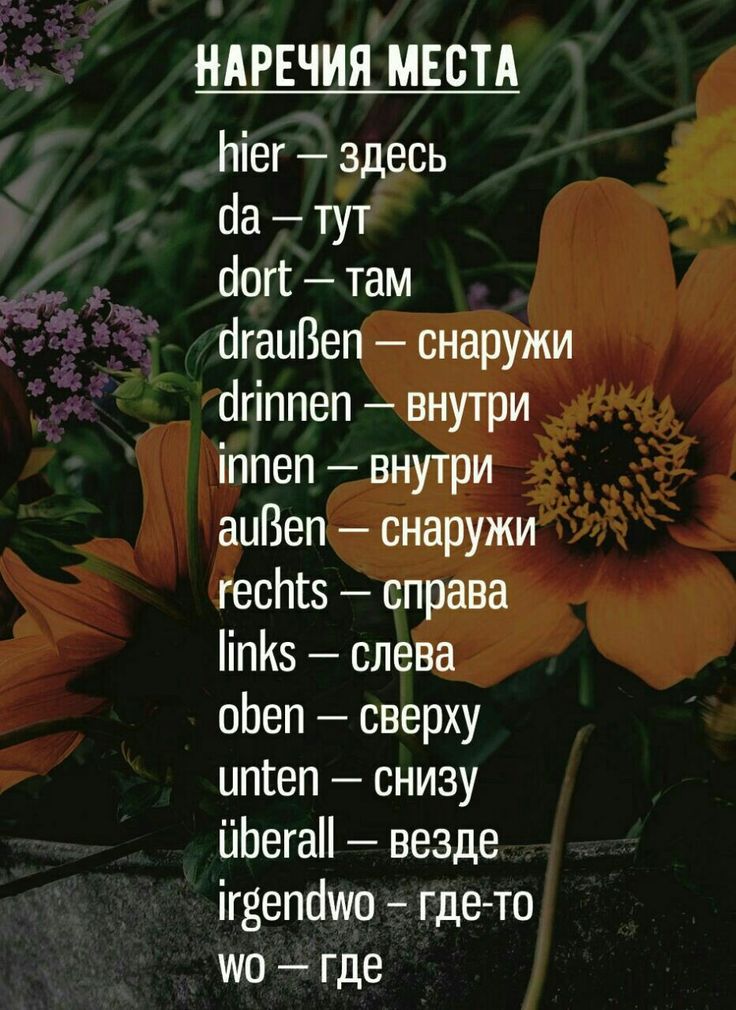
I knew da from Er Ist Wieder Da, and now I could only compare it to dort, which is not that far from there.
draußen took me aback at first, but then I noticed it being similar to außen and that is directly similar to out.
drinnen has the same rough doich dr but other than that it's innen similar to in the same way aussen is similar to aus and out. Which is also the word, I wonder why they didn't list it for it's more widely used thatn draußen, which is more popular than außen, which is wild. And germans know and use out too. But though g tells it's the second popular, other sources say it's strictly colloquial, so slang substitution local ugly german forms for similar international english ones.
rechts is directly similar to right
links is very similar to left, making me onder of how f~v~ν~n and k~c~ч~t
oben is connecting above (ν again) and over, which is uber, tbh
unten then tels that over was correct part, because it's cognate is under.
überall is some special case of using overall, but it' translated as all over, everywhere too (all over is in the sense of everywere, bnot of the start it all over, because that over belongs to the start)
to understand ingendwo we first have to understand wo, which is next to where in its pronouncement, nevermind the spelling.
But then it doesn't help to understand irgend very much: other than it stands for any.
My mother recommended me to use larger font for the examples, which is a great advice.
In print it will all be this way. I'm only lazy to enlarge it since I started to write ab without that.
But then the previous image is not that easily cognatized.
But then those words don't matter that much, they are some stylistic decoration with little attached meaning. attached begins with add, that's for sure, is ach also add? attach is add. Could be that ach is also add.
They could use digits as such table, but I'm not sure they ever did. And the best I could find is the brittish deaf alphbaet, where vowels are shown by the tips of the fingers:

But other than that it's all different.
And yet I know I saw something of the kind:
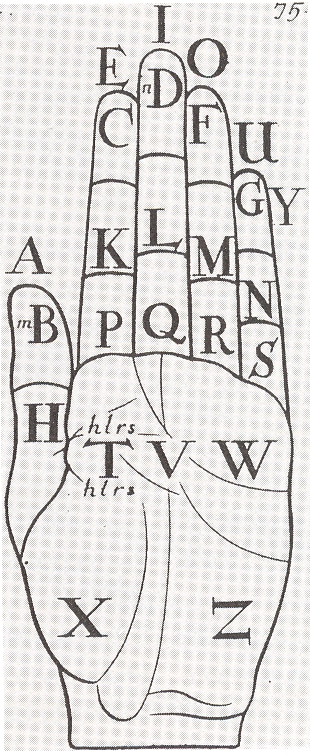
I suppose this is some abomination caused by increase in the number of letters. I think some other alphabet may still preserve the original system. Like some Irish maybe. Or what is that language using only 12 letters?
Hawaian has 12 letters,
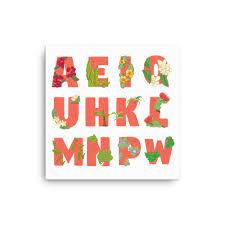

but it not always was this way:
leflet_1822.jpg)
Yet there is also Rotokas alphabet:
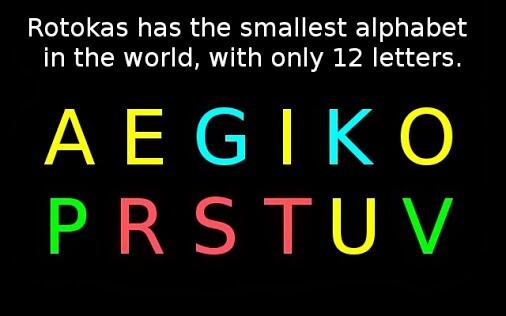
I like how they distinguish four types of the letters, it's a good sign telling me that hawaii is to distract my attention from this Rotokas thing, like georgians I'm yet to visit, I believe they may know something as well.

eat is aio in rotokas
The history of rotokas alphabet is nowhere to be found, but I didn't look for it deep enough.
But notice that this way it naturally goes eastern way even being nominally in alp[abetic order.
Your mom is so fat she uses plastic bags instead of condoms.

here some artist demonstrates his approach to right and left hand: his representation seems to be non-abrahamic, but it has abrahamicin arms gestures in hands: muslim path of the right hand (what is right according to some archaic feral ways) and christianity of the left hand of letting go, of forgiveness. Forgiveness is the only good input christianity made in what I see. It also seems to make abrahamism more european. But though it helped abrahamic culture, it damaged Europe with such adjustment. And I could have seen the interest of abrahamic descendance seeing this world in more triabl way than russians for example.
внезапно воспоминание о зеленском сказавшем что хохлы как евреи
Хазария Захария
(but хезать какать захар захер, руссня всё передразнит)
украина укурена разве что, но это и охуенно. украдено также неподалёку тут и газ и новоросиия от наврововали. наворовали.
pretty ~ прекрасна
T = red? It's on the end of the alphabet and at the beginning of the spectre: they could just read rainbow the other way around.
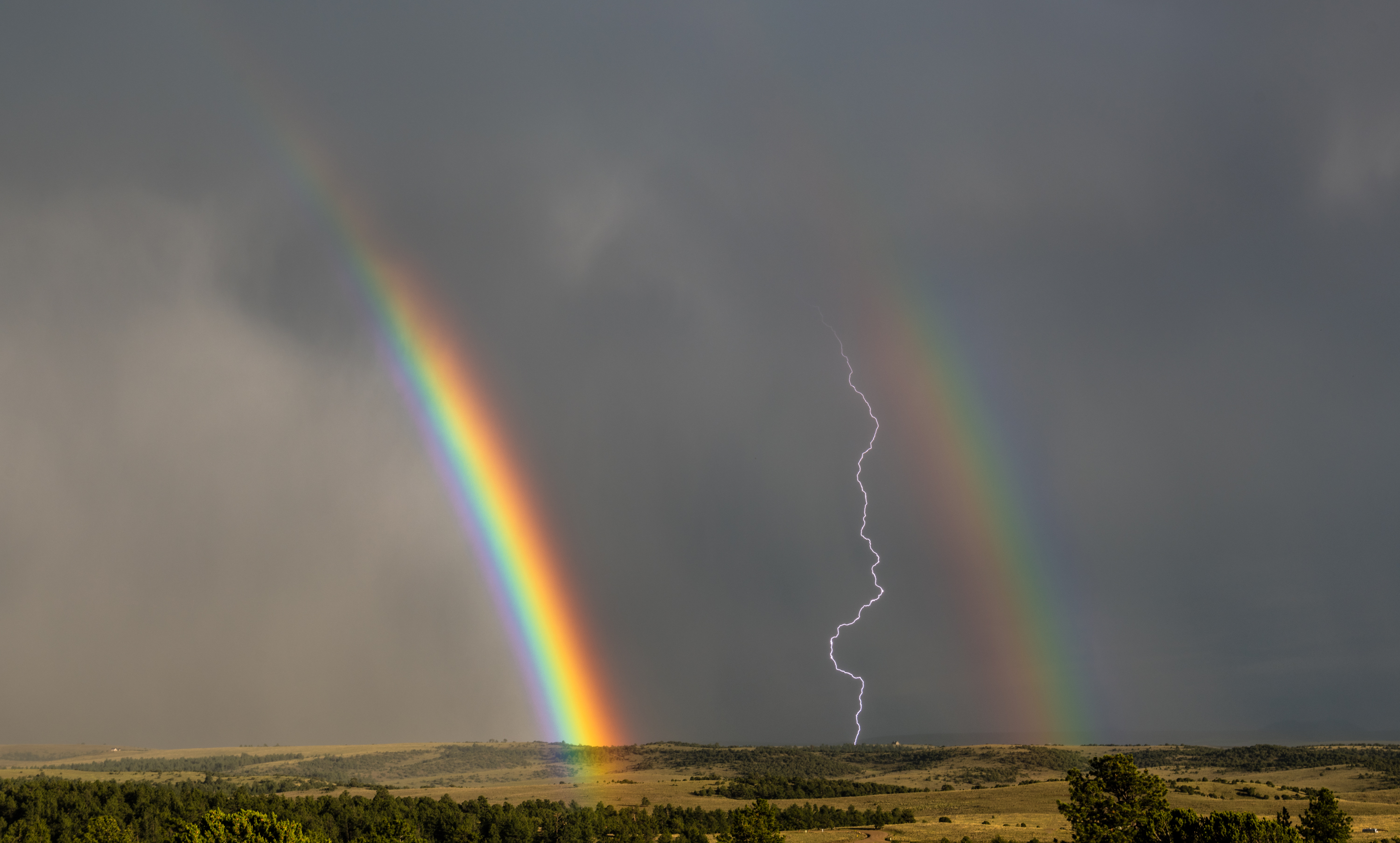
Violet Blue Green Yellow Orange Red
Russians count some light-blue (also in G) between B and G, and I wondered what is the sequence in english, and I googled "Green Yellow Orange Red" and the whole first page didn't give me "violet blue green yellow orange red", only "Blue Green Yellow Orange Red" and one "Blue Green Yellow Orange Red Violet" and one "Blue Green Yellow Orange Red White" which made me believe in the pentatonic of B G Y O R and because orange is not carrot and oranges don't grow in europe (and I am biased towards believing that europeans always were the only innovating race, even though japanese and such are honorary aryans, I told you I'm biased, I work with this set of assumptions, let's see where it leads me, you're free to make this or any other research with a set of you own.
Фиолетовый Синий Голубой Зелёный Жёлтый Оранжевый Красный
Блакитний Зелений Жовтий Помаранчевий Червоний
В украинском голубой от синего не отличают, фиолетовый я выкинул по результатам поиска, о котором выше.
Б З-Ж
П Ч
Б З Ч даже (зелёный помесь синего и жёлтого, оранжевый помесь красного с жёлтым, фиолетовый помесь синего с красным)
B G R (and this is directly R~D from the k-symmetry and also ᚦ looks like Ρ[r] (which raizese question of r~г~c and it is directly reflecting C especially as K
R reflects C? I thought G was C and R was D. is G ~ Ж ~ R?
Was it just Blue and Red? ice and flame.
B / R
Being / cRushing (рушиться)
Blue / Red
and Green of life is in the middle of those forces. Born by them. Being Born By Them.
R thus is of T claster and is T in the sense just as S is it in Book Of Formation.
Blue / Red is one step before that. Before three mothers were duality of this world. Mother and Father. Triads are some witch circles of making each witch happy with loving someone loving somebody else. It is easier to love somebody who isn't crusing around you.
If we see Blue as Good (God) and Red the Devil (B & D, baba & deda (mother and father))
b / d is russian showing which arm the being raises. russians also know д as g so it goes both ways like deus too? deus is more common term.
g / д is english showing which side do the "eggs" link (by egg I mean entity. I myself dream about liiving in an egg. in some fantastic capsule feeding me all the components for life and protecting me from all the causes of death)
Russian б never goes tail down. But then some shapes in other alphabets may be inversed by religiolexical reasons.
Some photographs may show additional colours, but that could be the imperfection of technology pushing some invisible layers, which probably go on indefinitely outside of the visible spectre, into visual frequencies:
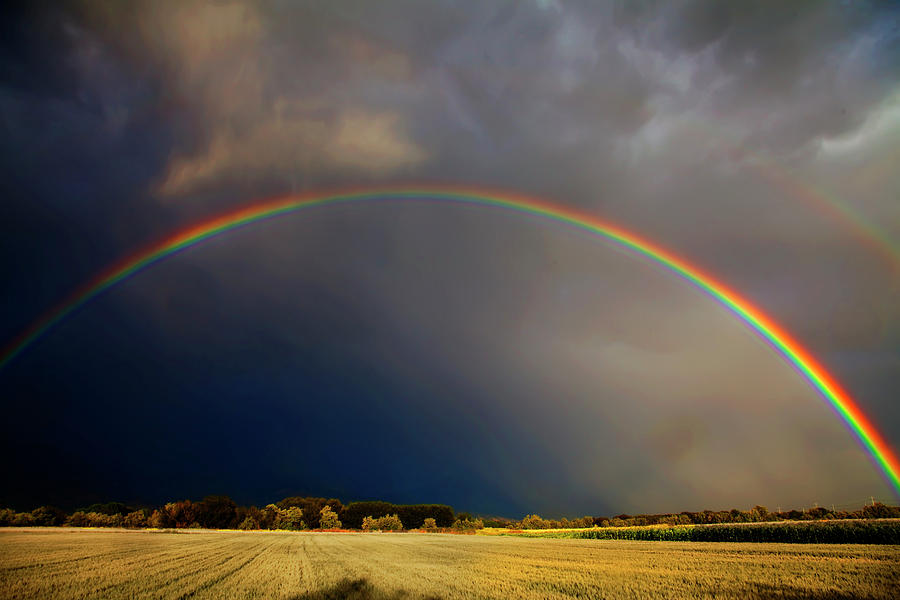
or it can be pushing it the other way so that some violet is only seen beyond red and blue is hardly seen:

but then how do I even know that this image isn't computer-generated, I will keep on observing rainbows in real life. To be continued..
Блакитний Жовтий Чорвоний though are ghreat candidate to be the essence of the alphabet.
Blue Green Red supports this tradition
Блакитний Зелений Чорвоний then?
Yellow is Jaune
Since I offered myself to assume God and all the transcendednt I have an element of madness in me.
God is a key to madness, so let's focus on the materialistic point of view Then I deliver immortality capsules faster. Let's play as when I wasa a teenager, let's assume there is no god, and see how fast I deliver. I was more successful when I thouyght that.
New ideas came all the time. Now I just regu..пережёвываю две больших идеи, хотя у меня их гораздо большще двух, кто сказал что их только две? число полушарий? Ни на что не влияет музыкант может много песен знать на изусть. Ш фдыщ ырщгдв цщкл щт фдд ьн ерштпыю Дуеэы цщкл щту ещзшс уфср вфню дуеэы аштв еру вфне ащк еру сфзыгду. 25
Sound is higher because its frequency is
higher.
pink noise is higher than white noise. both are not rainbow colours. some other scale
but hten I read Pink noise is white noise, but with reduced higher frequencies.
In signal processing, white noise is a random signal having equal intensity at different frequencies, giving it a constant power spectral density.
Pink noise or 1⁄f noise is a signal or process with a frequency spectrum such that the power spectral density (power per frequency interval) is inversely proportional to the frequency of the signal. In pink noise, each octave interval (halving or doubling in frequency) carries an equal amount of noise energy.
Pink noise is one of the most common signals in biological systems.[1]
The name arises from the pink appearance of visible light with this power spectrum.[2] This is in contrast with white noise which has equal intensity per frequency interval.

what have I made my site! but then it never was a scientific publication, it was a blog, a log of the journey of looking at everything around alphabets and wherever it lead me, so t lead me here, not exactly related, but since I began speaking of it, let's do what writers of the past could not:
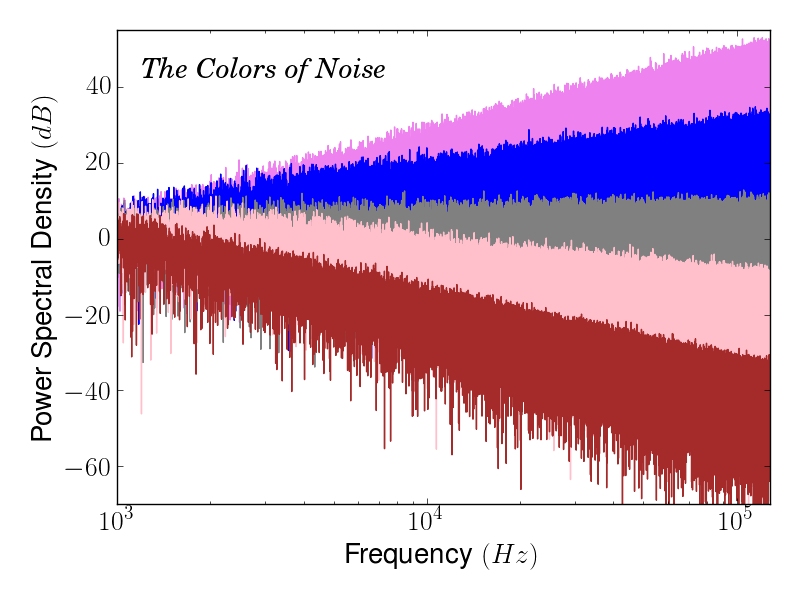
Each of them go all the way down, they're kind of in fron of one another, but I don't know why white is tilted, I think it has to go horizontally across all the frequencies equyally, but then the grey part kind of contradicts what they speak further on:
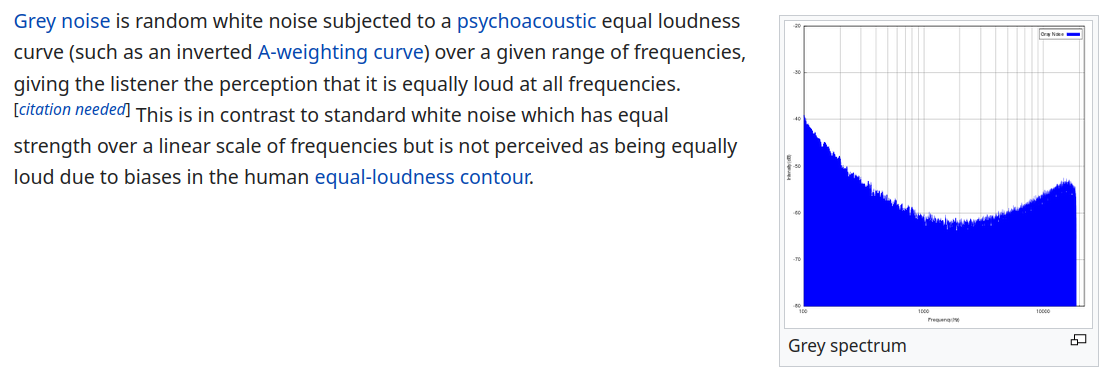
But then these modernist concepts only distract me. I have to return to basic colours. And brute-forcing the colour names across the globe or at least across Europe may find me the language where the abc was born.
АлыйБелыйСиний? вполне могут быть и другие цветиовые последовательности помимо радушных радужных
haughty~naughty
ГОсподи вместо господА чтоб обращаясь к миру дузхов (будь то внутри людей или увокруг в этом мире)
What if each generation doubles complexity? What generatiion are you? Some Twice the ammount of the smaller cells? Nah, I think it would be seen. But it would be seen only as that older cells are larger and attributed it to senescence. But in decades of research somebiody would notice that the average size of cells got smaller and maybe attributed it to some global warming of some other hoax.
haughty is hottie. I heard it from a pedofile counter-propaganda when they showed good jews who oh suddenly died, not other good jews? epstein is next to clinton, democrats the word attract demons.
luck good charm. ck is probably charm. k~R. C~L~r~г
abcd
iml?
n would be perfect nasal form. I si nose
A
E
I
O
U
O is mouth. U is beard.
E is EyEs
A is angel/spirit/mind
Angel Mind Spirit
M the first of consonants as it is also B.
I M L N (Емелен? Емелин? Элемент может всё же? Емелин.
N is Nose
M is Me, eye~I, 目
Angel Mind Spirit
Eye Ланита Локоть
I И Nose
O mOuse mOuth кОлено. К? O~Q
U jaw? jew? eUrei iUdei Uei seems to be the common par of both words?
V voice. Уста. О шы NOse. Oh. Oh is the opposite of Yeah.
Yeah is definitely mouth is in a smile (улЫбка)
Oh is definitely mouth is in an awe
Russian ulybka is definitely more натянутая, из У. через ли.
Английская У I is definitely more moonlike higher. The ends of that smile's lips are higher.
Russians should adapt english lexics more Because it is demonstabley successful strategy since they succeeded.
рулить жулить
рушить и рубить don't have pairs in ж variant.
рулон и рубашка also don't.
Let's try it the other way around.
жук bug
жизнь бытие
жопа попа
жена пана (паночка, пани)
жевать певать
желать пылать
ждать подать? поджидать? зщ засад
жирный полный
животное повадкое
животное певучее
животное прыгучее
(живое движется, пыжется)
двивотное. В отличие от деревьев и расстений, которые ДЕРЕВ ~ ВЕТЕР
вторит? вытирает? выдерает?! выдирает
живот пивот (makes perfect sense)
живот пьёт
жуёт пьёт (вот в чём разница: ж твёрдое, п мягкое. язык определённо твёрже губ, твёрже языка только зубы, да и то иногда язык может померяться с зубами силой, когда зубы выпадают и их языком раскачивают. Молочные зубы)
A
E
I
O
V
Aa
Ee
Ii
Oo
Uu
Ee ~ Eye
aBCD B C D are be see do
E FGH
IJKLMN
OPQRST
uVWXYZ
Е
И
О
are three vowels standing for three openings serving for three senses
E eyes vision
I И Nose II could be moire complex but very legit way to draw nose.
O Taste
Japanese touch their nose to say I.
О рот ~ opqrst
u ~ uvwxyz
у ~ уфхцчшщъыьэюя
Some letter-like shapes I noticed in a bronze age pots:
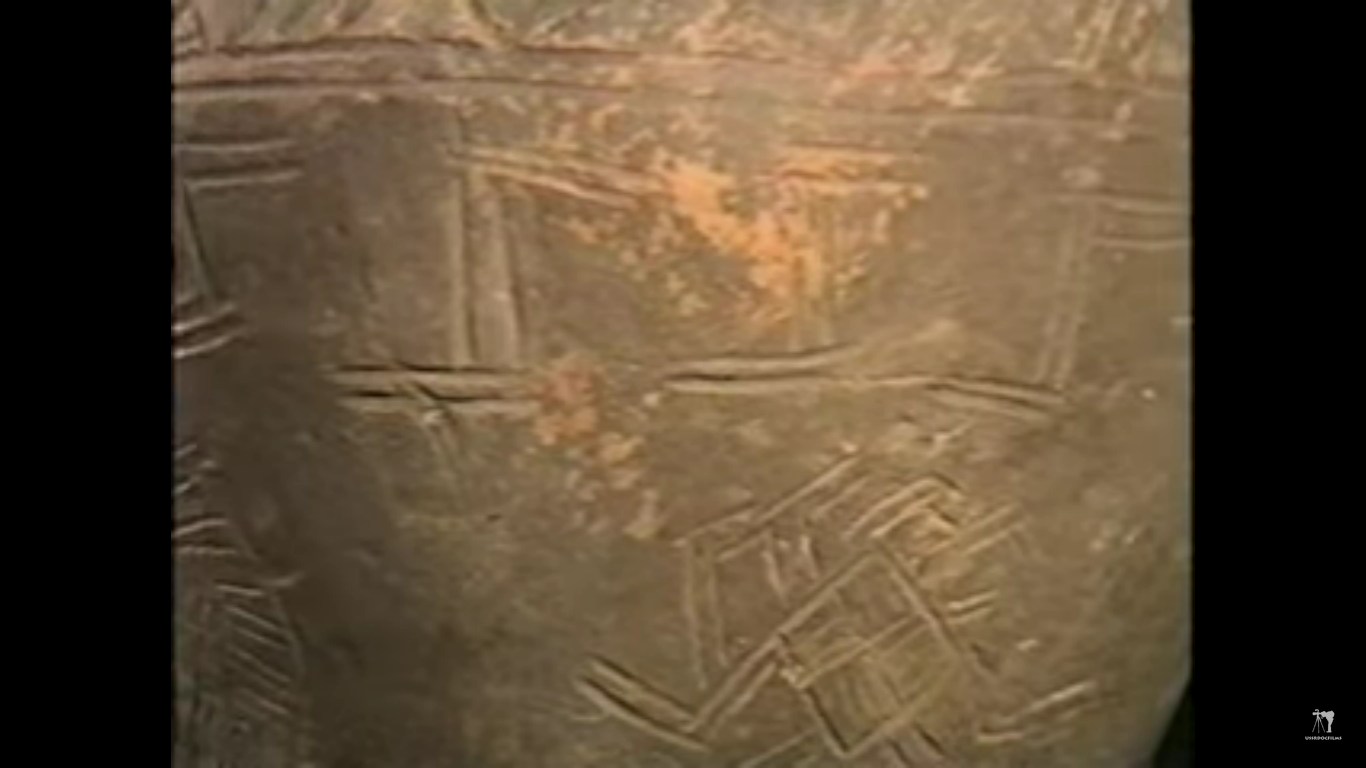
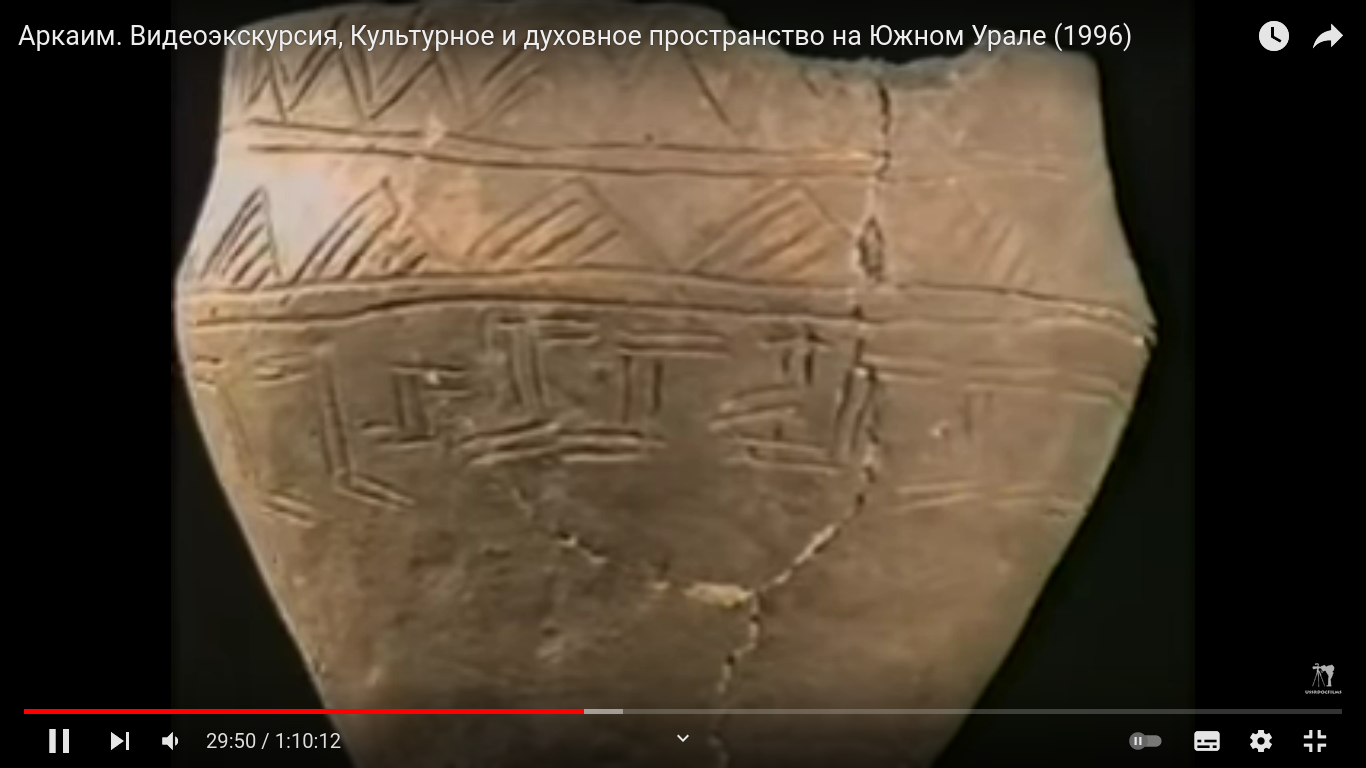
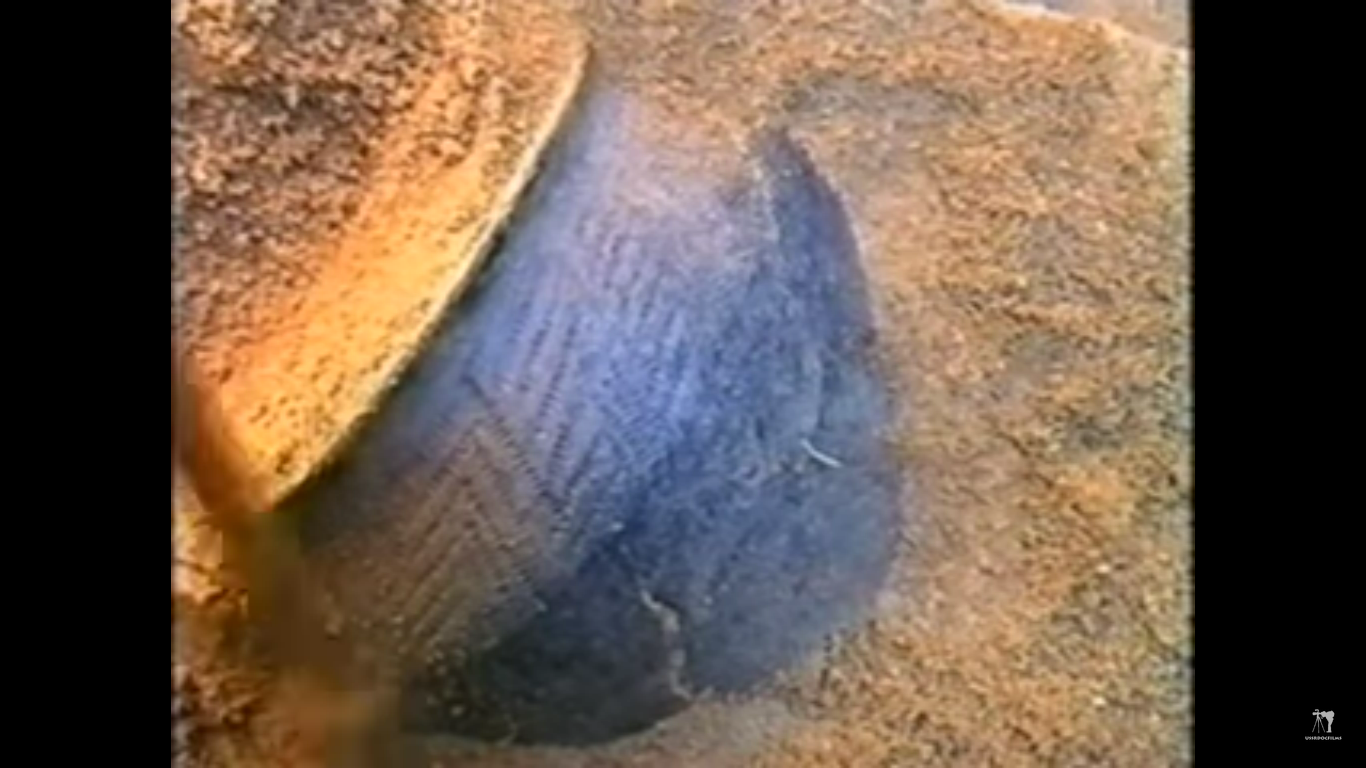
MAZ was the first sequence I saw in the second image. The others make me think that it all could be psy op from Z forces of putin (that documentary uses meditative music over sometimes slow and steady voice as a hypnotist would go. So because it's of putin's era (but actually it started in the 1970s, but then some say the 1980s, or was it when arkaim was found, not the first of them all or is it something special? it probably is, since we didn't have history of this period of that pace, kgb era in general) and is about something ancient at ural, I'm suspicious of any Z, but then those Arkaim findings could be the source of those Zombies' inspiration.
In that video they tell that egg (oval) gave birth to sky (circle) and earth (square)
Sun, moon, even stars are pretty much circular.
Building people built of logs were angular, and so were their lib limbs.
So that story makes some deep sense. So I accept it into my brew.
Is triangle also square? It's definitely also angular.
If we had tentacles, it would make a tit less sense, or we would be recognized as even more heavenly creatures.
But that last image of the jar in the soil. They had to leave them where they found it, or they could have it like a lab gal in that video had, pushing it so that half fell off.
They say it's better to lay on the right side, because heart is at the left one. And thus if you fall left you fall on your heart and it could explain why counter-clockwise thing could be considered unlucky: when you fall left you fall counterclockwise. But then I fell like that and I saw the inner view rotating counterclockwise, when I think the opposite should have happened: the world rotated clockwise relative to my view.
Мова ~ Молва (молвя is the antonym of молча, just as B is the antonym of T)
размолвка, помолвка - обе на словах.
Is golem goyim?
co??d is co?d
did Jesus command not to call anybody on the face of the earth a father
or did he command not to call anybody leaving living dead dad
The conclusdion of book tåboo:
(placed here for whatever reason)
Two most basic social norms are not talking of politics and not talking of
essay could be doublet of issue (not only issue essay may address, but also issues in newspapers are essays) both are complicated words and before things became searchable on the internet, people could have problems finding complex and rare words in ictionaries and/or two traditions of spelling could double the words like that.
and I'm pretty sure I found new way of словообразование (things are searchable, but I'm lazy and write for myself, but for whom am I writing this? garbage!) but then how do I know if I'm the first one? but why would I care. Many inventions had to be made more than once to stick.
I have no idea if this is an actual image or a message to thoese who know optics.

(I share where I took it, but how do I even know if that program wasn't made by vatican themselves to declare their power. But then they keep their power for many centuries, so why wouldn't it be at least partially true? Jews pull their strings and Vatican pulls their strings, and some othre power group pull theirs, and so a complex multi-layer system of сдержек и противовесов? русский кривой перевод понятий привёл к перекосу всей системы. В английском это separation of powers. And maybe russia wouldn't be so clumsily unified if they tolerated many powers, they would be more powerful. But the one power doesn't tolerate competition (because truly they are incompetent) so my task now is to audit the political and economic terms in my sick and definitely unbalanced country (it works in a fraction of its true potential. And the good news is the best are still here, we never left. Or I did, but being of those who can see for themselves saw the ills of that foreign society and decided to be a dragon of my own castle. To help my own country overcome its own ills I at least understand better than the most of my conpatriots. But then I realize that I just think too highly of myself. checks and balances is the term. And it seems to exist alright, but I'm not sure russians understand it the same, most of them don't, but most of many people probably odn't. some people do.. why is this babble? I am what am I doing. Whether language ofr the capsule. Why am I so political. I should avoid pol as plague.)
but then I guess they're:

and if the sun is at the other side of the photographer, I guess that is how rainbow works.
(but I still don't know high. Need to read about it)

Three mothers in hinduism are alike to these three of hebrew and norsk
norsk has suffix russian toponyms have. irkutsk simbirsk novosibirsk
sk is a suffix, bexause you can see complete sibir (siberia in russian) but I thought norsk has north before standard k suffix. or is th also a suffix? is sk the and of (simbirsk is of siberia, novosibirsk is new town of syberia (not nov as in novgorod, but novo as in novosibirsk novokuznetsk)
Three mothers in hinduism are the mother who gave you birth, the mother goddes and the mother who take you after you die (mother Earth)
And this could be the concept of the afterworld, because those are whether those threemothers live. The well is so huge that it is containing all the tree growing from it. Some boundaries of the unthought of or non-existant lays behind the walls of the well.
wall is a straight line
well is a circle.
A is Arrow
E is tetiva? верёвка скручивается (в рулон, roll)
рулон~рулет
рулончик~рулетик
both are different suffixition of roll
A твёрдое
E мяхкое
Реформа правописания: заменить г х (двойное г, долгое г, мяхкое г)
дабы слова мяхкое и лёхкое были мяхче и лехче
(это будет сродни украинскому прочтению буквы г (той где мы читаем г) но это в свете событий 2022 справедливо. Вы хотели триединый народ, получайте украинскую цыбулю в ваш трёхчлен, что гейско просто пиздец. хуйло обогатило русский лексикон, что может сделать язык певучей, вариативней, богаче. бохаче. бохато вместо богато показывает диалектный компонент, добавляя элемент иронии (богато для деревенщины с украины, как у Гоголя показано)
soft may indicate that e was ё верЁвка трЯпка грЯзь пеРИна они все на ре. мЯхкое, вот тебе не р
шеРсть шерьсть? щеристость? шерсть мех. всё на е идёт. я не выбираю. но может у меня подсознательно такая установка включена. Давай переключим на А
АдеЯло всё равно ударная палатализующая. j (but who how do I ignore the O of sOft, there's still A of hArd. how Ard, qaq как Earth
кака ~ like
novo instead of nov
watching тополиный пух (poplar fluff)
pollen (seeing it flying upwards in large ammount, falling up, pollen~fallen? and I thought of that as of pollen, because poplar is topol in russian, and it has that pol as in polen, as if en is nothing more but plural suffix. And I see now that that tree is called like that because it is popular. Which is weird, but that that cotton mixing up with dust may settle it down in more easy to clean substance, I have no idea about it though)
кожаный
пуховой
ν[n] ~ v[v]
(dialectal readings of the same voiced fricative. Before they distinguished labial from lingual, they knew plosives and fricatives, though they probably didn't speak of them in such terms, they could be not speaking about them at all. But I think everybody can distinguish between palatalized and not palatalized forms of say c or g and in russian they have more of those, though they are much less different than different readings of C and G in english.
so в ~ н (could be literally the same letter, but in the в case the serifs would use more liquid ink and their ends merged) and thus праведный=правдивый, а все семантические различия которые я навыдумывал или даже подметил (правдивый содержит правду в себе, праведный сам содержится в правде) столь малозначительны, что я сам порой могу оговориться на предмет человек содержит в себе бога или сам является частью бога (и, кстати, наверняка будут самые различгные мнения на счёт того а как на самом деле правильно, так раз я сам путаюсь, то понимания каких семантических нюансов можно ждать от простого народа)

I suspected rooster to be the bird on the top of the tree, I think I thought so because I read so.
Even though two headed eagle is a rather ancient symbol, at least from roman empire times, so definitely pre-christian, similar to Janus too, I never saw it in this context. And I never (or just forgot) read about the three snakes, three rivers I remember I read of, but that snakes AND the great snake is kinda new to me, let's leave have it on the artist's word, but I will only keep it in mind, I don't accept anything blindly, I will revisit it again and again.
I never saw birds on Yggdrasil like that, but owl between eagle and the singing bird (rooster is literally петух in russian (the one who sings, maybe that is how that word appeared in criminal argo in the meaning of a passive homosexual having sex with other criminals, if that is how they punished snitches, yet it's also gay as fuck and not in a good sense)) makes me think that they are another representation of the trinity or tridevi or whatever that triple archetype is about it seems to appear everywhere, now wonder, three is a common number: 𓄿𓅓𓅱 even though egyptians probably had a canary-like singing bird instead of rooster. Eagle Sees. Owl Hears? the other one speaks? sings! here I linked them to theose three monkeys of the kali-yuga where they seen no evil, hear no evil, speak not.
The canon law, the opposite of common law.
yet another representation of the same:
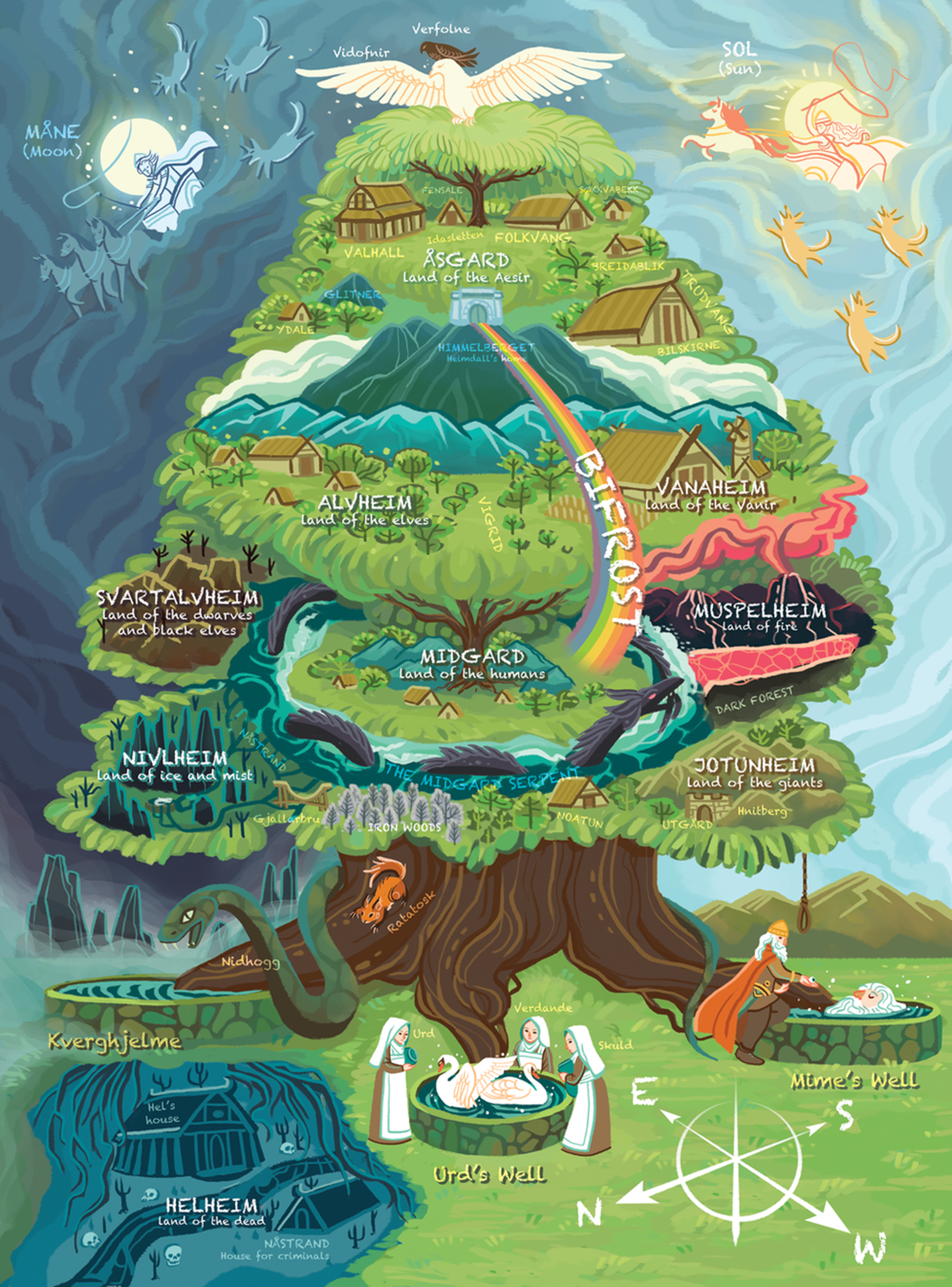
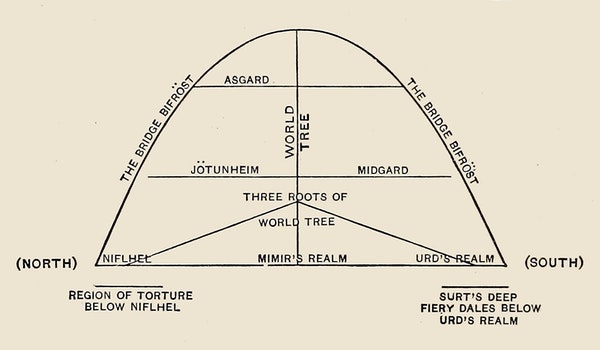

That birdie on the head of the eagle reminds me of a dutch fairytale about a kinglet bird who became a king of all birds by tricking a eagle by hiding in his feather and that way flying higher than him. And one of the species of kinglets is goldcrest (what a name) and I suspect that story to be about hte jews, which could be so especially in the light of nazi imagery, I don't think they ever placed Verfolne on the Vidofnir's head in their propaganda:

And similar to yggdrasil imagery in another culture:

9 DALLI HAYAT AĞACI Ağaç üzerinde Yakut Türklerinin mitolojisindeki Tanrıça Ayısıt tasvir edilmiş.
Ayısıtın avatar hayvanı, Turna ve Kuğu kuşlarıdır. Kuşlar gökyüzü ve yeryüzü arasında kozmik yol olarak görülen, hayat ağacının dallarında yaşar. Türk mitolojisinde kuşlar ruhları simgeler. Tanrıça Ayısıt, ağacın üzerinde, bir tarafta elinde bir süt kasesi ile, ve tarafta ise bir bebeği kucağına almış şekilde ifade edilmiş. Ayısıt Türk mitolojisinde süt ak gölden getirdiği, hayat içeceği bağlamındaki sütü, yeni doğan bebeklerin ağzından damlatarak onlara ruh ve can verir. Türk yaratiliç mitolojisinde Tanri Ülgen 7 yada 9 dalli bir ağaç yaratir ve insanlar bu dallardan türer. Tanriçalar gökyüzünden inerken iki kayin ağaci ile birlikte iner. Ağaçlar Ana Tanriçanin sembolüdür. Uygur Türeyiş Mitolojisinde Uygur Türklerinin atasi olan 5 çocuk, ağaç, konuğunda doğar. Ağaç Kovuğu Ana Tanriçanin Rahmi olarak bilinir. Umay Ana ve Ayisit, hayvan yavrularini ve çocuklari koruyan Tanriçalardir. Bu Yakut Hayat Ağacinin tepesindeki üç çatalli sembol, Orhun Alfabesinde "Ağaç" olarak okunan tamgadir. Nuray Bilgili.
9 TREE OF LIFE WITH BRANCHES On the tree, the Goddess Ayisit from the mythology of the Yakut Turks is depicted.
Bear's avatar animal is Crane and Cygnus birds. Birds live in the branches of the tree of life, which is seen as the cosmic path between sky and earth. In Turkish mythology, birds symbolize spirits. Goddess Ayisit is depicted on the tree with a milk bowl on one side and a baby on her lap on the other. In Turkish mythology, the milk brought from the white lake, in the context of life drink, drips from the mouths of newborn babies and gives them soul and life. In Turkish creation mythology, God Ülgen creates a tree with 7 or 9 branches, and people derive from these branches. As the goddesses descend from the sky, they descend with two beech trees. Trees are the symbol of the Mother Goddess. In the Uyghur Derivative Mythology, 5 children, the ancestors of the Uyghur Turks, are born to the guest of the tree. The Tree Hollow is known as the Womb of the Mother Goddess. Mother Umay and Ayisit are Goddesses who protect animal babies and children. The trident at the top of this Ruby Tree of Life is the tamga read as "Tree" in the Orkhon Alphabet. Nuray Bilgili.

I guess those columns are to be read right to left: The mother with the child, how it began, the mother of the world we live in, the mother earth with what may be an urn with the dust of a deceised. Tengri runes are read right to left. Мир ~ mere ~ мера. м?р мир мор? мар? is there such a word standing for born or something? мара мама? Ма Ми Му (му ~ умру. but then in my personal case I hope I will not end my path but keep on going on, coming my paths forever, but then they say сколько верёвочке не виться.. but let's not forget that probably it's nothing more than symbolic understanding of the world by the ancient ancestors, it is necessary to be this very way, the world is built quite differently than ancients thought, so maybe what they thought of is valid in some )

vol. 20
...
